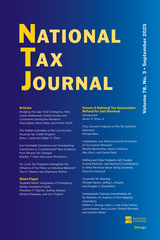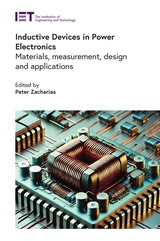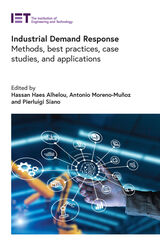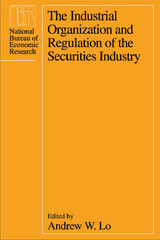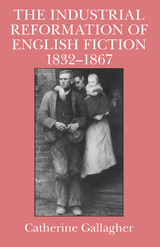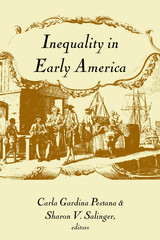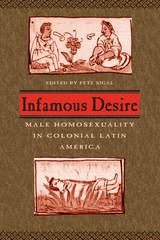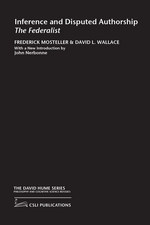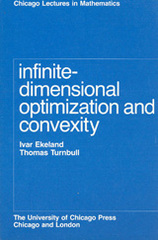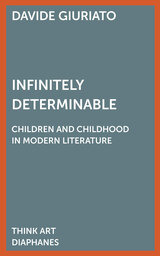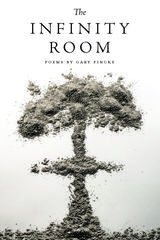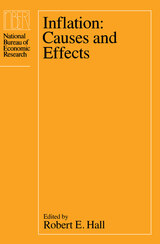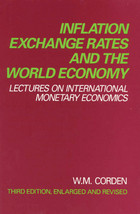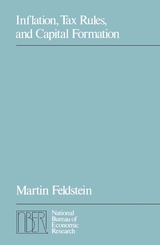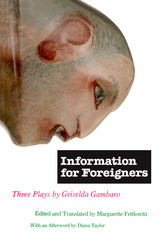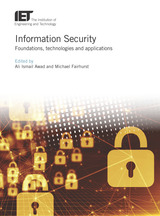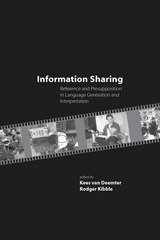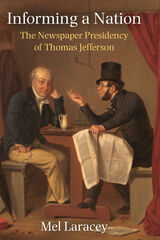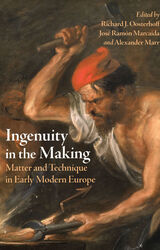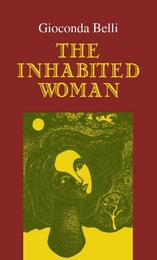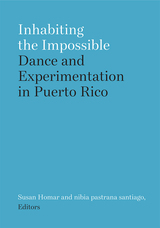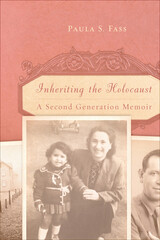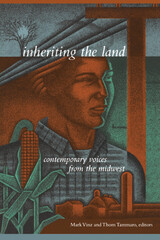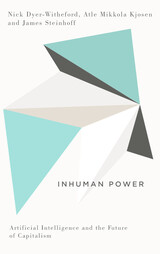Inductive Devices in Power Electronics: Materials, measurement, design and applications
Peter Zacharias
The Institution of Engineering and Technology, 2025 During the rapid developments in semiconductor technology, the role of inductive components as a limitation for further improvements became clear. The challenges involve the magnetization losses and unwanted eddy currents at higher switching frequencies, which in turn limit the reduction of device volumes. New materials and design approaches offer solutions. Furthermore, new topologies of power converters in connection with flexible digital controls and design of magnetic components offer ways to reduce the required component volume and increase the power density, which is especially important for mobile applications.
Industrial Demand Response: Methods, best practices, case studies, and applications
Hassan Haes Alhelou
The Institution of Engineering and Technology, 2022 Demand response (DR) describes controlled changes in the power consumption of an electric load to better match the power demand with the supply. This helps with increasing the share of intermittent renewables like solar and wind, thus ensuring use of the generated clean power and reducing the need for storage capacity.
Industrial Digital Control Systems
K. Warwick
The Institution of Engineering and Technology, 1988 This book provides an introduction to the techniques employed in the design and implementation of digital control systems. The text has arisen out of a highly successful IEE Vacation School held annually at Oxford University and the contents have been tailored to a digestible level and breadth by means of the feedback provided from previous School participants. As well as a tutorial approach to the description of basic concepts and general ideas used, most chapters include numerous worked examples and details of particular applications in order to enhance the theory introduced. The importance of putting over a technique by making use of practical examples is highlighted by the inclusion of several chapters in which selected case studies are presented detailing applications of both the more conventional and the more modern digital control ideas.
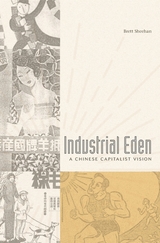 Industrial Eden: A Chinese Capitalist Vision
Brett Sheehan
Harvard University Press, 2015 This illuminating study of the evolution of Chinese capitalism chronicles the fortunes of the Song family of North China under five successive authoritarian governments. Headed initially by Song Chuandian, who became rich by exporting hairnets to Europe and America in the early twentieth century, the family built a thriving business against long odds of rural poverty and political chaos.
A savvy political operator, Song Chuandian prospered and kept local warlords at bay, but his career ended badly when he fell afoul of the new Nationalist government. His son Song Feiqing—inspired by the reformist currents of the May Fourth Movement—developed a utopian capitalist vision that industry would redeem China from foreign imperialism and cultural backwardness. He founded the Dongya Corporation in 1932 to manufacture wool knitting yarn and for two decades steered the company through a constantly changing political landscape—the Nationalists, then Japanese occupiers, then the Nationalists again, and finally Chinese Communists. Increasingly hostile governments, combined with inflation, foreign competition, and a restless labor force, thwarted his ambition to create an “Industrial Eden.”
Brett Sheehan shows how the Song family engaged in eclectic business practices that bore the imprint of both foreign and traditional Chinese influences. Businesspeople came to expect much from increasingly intrusive states, but the position of private capitalists remained tenuous no matter which government was in control. Although private business in China was closely linked to the state, it was neither a handmaiden to authoritarianism nor a natural ally of democracy.
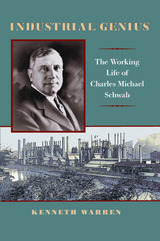 Industrial Genius: The Working Life of Charles Michael Schwab
Kenneth Warren
University of Pittsburgh Press, 2007
Charles Schwab was known to his employees, business associates, and competitors as a congenial and charismatic person-a 'born salesman.' Yet Schwab was much more than a salesman-he was a captain of industry, a man who streamlined and economized the production of steel and ran the largest steelmaking conglomerate in the world. A self-made man, he became one of the wealthiest Americans during the Gilded Age, only to die penniless in 1939.
Schwab began his career as a stake driver at Andrew Carnegie's Edgar Thomson steel works in Pittsburgh at the age of seventeen. By thirty-five, he was president of Carnegie Steel. In 1901, he helped form the U.S. Steel Corporation, a company that produced well over half the nation's iron and steel. In 1904, Schwab left U.S. Steel to head Bethlehem Steel, which after twelve years under his leadership, became the second-largest steel producer in America. President Woodrow Wilson called on Schwab to head the Emergency Fleet Corporation to produce merchant ships for the transport of troops and materials abroad during World War I.
Kenneth Warren presents a compelling biography that chronicles the startling success of Schwab's business career, his leadership abilities, and his drive to advance steel-making technology and operations. Through extensive research and use of previously unpublished archival documentation, Warren offers a new perspective on the life of a monumental figure--a true visionary--in the industrial history of America.
 Industrial Microwave Heating
A.C. Metaxas
The Institution of Engineering and Technology, 1988 This book offers a broad coverage of the theory and practice of industrial microwave heating. It introduces the physical processes behind dipolar and conductivity loss mechanisms and follows with a thorough presentation of dielectric property data of many industrial materials as a function of the moisture content, temperature and frequency, focussing on the interpretation of such data as regards the suitabiliy for processing these materials with microwave energy. The basic equations which govern the power dissipation, attenuation, phase constant, penetration depth and skin depth are derived from first principles while the transport equations of heat, mass and pressure are qualitatively described, giving particular emphasis to the physical mechanisms behind high frequency drying. The book provides established procedures backed by theoretical formulations for the design of industrial travelling wave and multimode applicators. It also provides extensive coverage of single mode fundamental or higher order resonant cavities and outlines a number of atypical applicator structures. It describes the essential features of processing with microwaves under vacuum and presents a brief introduction to the mechanisms which lead to gas breakdown. It stresses the need for a degree of hybridisation with other electrical or conventional heating systems and discusses a few such schemes. The book outlines a number of systems for limiting leakage from on-line industrial microwave systems and concludes with an extensive discussion of successful industrial applications.
The Industrial Organization and Regulation of the Securities Industry
Edited by Andrew W. Lo
University of Chicago Press, 1995 The regulation of financial markets has for years been the domain of lawyers, legislators, and lobbyists. In this unique volume, experts in industrial organization, finance, and law, as well as members of regulatory agencies and the securities industry, examine the securities industry from an economic viewpoint.
Ten original essays address topics including electronic trading and the "virtual"stock exchange; trading costs and liquidity on the London and Tokyo Stock Exchanges and in the German and Japanese government bond markets; international coordination among regulatory agencies; and the impact of changing margin requirements on stock prices, volatility, and liquidity.
This clear presentation of groundbreaking research will appeal to economists, lawyers, and legislators who seek a refreshingly new perspective on policy issues in the securities industry.
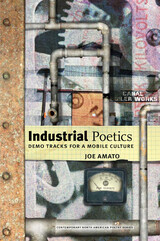 Industrial Poetics: Demo Tracks for a Mobile Culture
Joe Amato
University of Iowa Press, 2006
Through a dizzying array of references to subjects ranging from engineering to poetry, on-the-job experiences in academia and industry, conflicts between working-class and intellectual labor, the privatization of universities, and the contradictions of the modern environment, Joe Amato’s Industrial Poetics mounts a boisterous call for poetry communities to be less invested in artistic self-absorption and more concerned about social responsibility.
As Amato focuses on the challenges faced by American poets in creating a poetry that speaks to a public engineered into complacency by those industrial technologies, practices, and patterns of thought that we cannot seem to do without, he brings readers face to face with the conflicting realities of U.S. intellectual, academic, and poetic culture.
Formally adventurous and rhetorically lively, Industrial Poetics is best compared with the intellectually exploratory, speculative, risky, polemical work of other contemporary poet-critics including Kathleen Fraser, Joan Retallack, Bruce Andrews, Susan Howe, and Allen Grossman. Amato uses an exhilarating range of structural and rhetorical strategies: conventionally developed argument, abruptly juxtaposed aphorisms, personal narrative, manifesto-like polemic, and documentary reportage. With a critic’s sharply analytical mind, a poet’s verve, and a working-class intellectual’s sense of social justice, Amato addresses the many nonliterary institutions and environments in which poetry is inextricably embedded.
By connecting poetry to industry in a lively demonstration against the platitudes and habitudes of the twentieth century, Amato argues for a reenergized and socially forceful poetics—an industrial poetics, rough edges and all. Jed Rasula writes, “I can't say I pay much attention to talk radio, but this is what I imagine it might be like if the deejay were really smart, enviably well read, yet somehow retained the snarling moxie of the AM format.”
Industrial Power Systems with Distributed and Embedded Generation
Radian Belu
The Institution of Engineering and Technology, 2019 Energy for today's complex electrical power systems is increasingly being generated and distributed locally using small-scale, renewable energy sources. The addition of renewables to the grid requires new tools and operation methods, both for suppliers and industrial consumers. This book describes the supporting technologies that can turn conventional passive electricity delivery networks into the active networks of the future, with a focus on electricity utilization in the industrial environment. It examines the integration of the new, dispersed sources with the legacy systems of centralised generation, as well as how the new technologies can operate effectively in isolated systems. Industrial power distribution, lighting, motor control and protection are discussed in detail.
 Industrial Relations in Urban Transportation
Emerson P. Schmidt
University of Minnesota Press, 1937 Industrial Relations in Urban Transportation was first published in 1937. Minnesota Archive Editions uses digital technology to make long-unavailable books once again accessible, and are published unaltered from the original University of Minnesota Press editions. In the present era of industrial warfare and violence, this book points a "middle way" in employer-employee relations. It describes the remarkable achievement of the Amalgamated Association of Street, Electric Railway, and Motor Coach Employees of America, which for nearly fifty years has used the machinery of arbitration to settle all labor disputes without resort to strikes. Herein also is probably the first attempt to measure on a nation-wide scale the influence of a union in raising wages and reducing hours. But this is much more than the story of a successful union. It is a complete history of urban transportation in the United States — the first such history to be written. It deals with technological, financial, and regulatory, as well as labor, aspects. The characteristics of transportation work and the type of men attracted to it are carefully analyzed, and there is a chapter devoted to the late nineteenth century conditions which gave birth to unionism. This readable study will be of particular interest to owners, managers, and employees of local transportation systems, to investment bankers and investors, regulatory commissions and city aldermen, public mediators and arbitrators of labor disputes, and students of economic history.
 Industrial Restructuring with Job Security: The Case of European Steel
Susan N. Houseman
Harvard University Press, 1991 How can workers retain job security in an industry currently experiencing extensive restructuring and retrenchment? In the United States, massive layoffs in the 1980s in industries like steel have resulted in increased worker demands for job security provisions in collective agreements and legal protections against layoffs. In many Western European countries, where private-sector practices ensuring strong job security and laws regulating layoff practices were well established, the 1980s brought strong pressure from business to relax job security in order to facilitate rapid restructuring.
Susan Houseman's book presents some of the first hard evidence on the economic effects of providing job security, evidence gathered during the restructuring of the European Community's steel industry in the 1970s and 1980s. The author reviews personnel practices by the Community's leading steel companies, basing her analysis on extensive interviews with employers, workers, and government officials in West Germany, France, Britain, Belgium, Luxembourg, Italy, and the Netherlands. Drawing on economic theory, she shows that the extent of workers' rights to job security will affect how an industry optimally adjusts to a decline in demand and to a situation of excess capacity.
Using detailed plant data, she shows that job security for workers affected decisions concerning employment, production, investment, and plant closures in the industry, While job security for workers may slow the process of industrial restructuring and result in lower productivity, the author points out that it also generates important social benefits, including community stability and a more equitable distribution of the risks and costs of economic change.
This book will draw the attention of policymakers in government and in international organizations such as the European Community, the OECD, and the ILO. It will also be of interest to scholars in labor economics, industrial relations, public policy, and business.
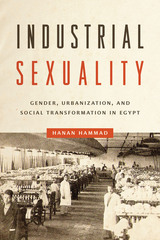 Industrial Sexuality: Gender, Urbanization, and Social Transformation in Egypt
By Hanan Hammad
University of Texas Press, 2016 Sara A. Whaley Book Prize, National Women's Studies Association, 2017
AMEWS Book Award, Journal of Middle Eastern Studies, 2017 Millions of Egyptian men, women, and children first experienced industrial work, urban life, and the transition from peasant-based and handcraft cultures to factory organization and hierarchy in the years between the two world wars. Their struggles to live in new places, inhabit new customs, and establish and abide by new urban norms and moral and gender orders underlie the story of the making of modern urban life—a story that has not been previously told from the perspective of Egypt’s working class. Reconstructing the ordinary urban experiences of workers in al-Mahalla al-Kubra, home of the largest and most successful Egyptian textile factory, Industrial Sexuality investigates how the industrial urbanization of Egypt transformed masculine and feminine identities, sexualities, and public morality. Basing her account on archival sources that no researcher has previously used, Hanan Hammad describes how coercive industrial organization and hierarchy concentrated thousands of men, women, and children at work and at home under the authority of unfamiliar men, thus intensifying sexual harassment, child molestation, prostitution, and public exposure of private heterosexual and homosexual relationships. By juxtaposing these social experiences of daily life with national modernist discourses, Hammad demonstrates that ordinary industrial workers, handloom weavers, street vendors, lower-class landladies, and prostitutes—no less than the middle and upper classes—played a key role in shaping the Egyptian experience of modernity.
Industrial Software Technology
R.J. Mitchell
The Institution of Engineering and Technology, 1987 A number of interrelated developments are changing the nature of software technology. Developments in hardware are putting greatly increased power at the disposal of the software technologist. Advances in formal methods are providing the means to bring greater precision into the early stages of system development. Techniques such as expert systems are being brought into the domain of software technology as a result of advances in the application of artificial intelligence research. Developments in paradigms of system development are giving the software technologist better models of system structure and better tools and techniques for creating large systems, and greater political recognition of the importance of information technology is resulting in increased funding for research and development in software technology.
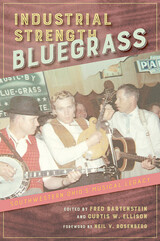 Industrial Strength Bluegrass: Southwestern Ohio's Musical Legacy
Edited by Fred Bartenstein and Curtis W. Ellison
University of Illinois Press, 2021 In the twentieth century, Appalachian migrants seeking economic opportunities relocated to southwestern Ohio, bringing their music with them. Between 1947 and 1989, they created an internationally renowned capital for the thriving bluegrass music genre, centered on the industrial region of Cincinnati, Dayton, Hamilton, Middletown, and Springfield. Fred Bartenstein and Curtis W. Ellison edit a collection of eyewitness narratives and in-depth analyses that explore southwestern Ohio’s bluegrass musicians, radio broadcasters, recording studios, record labels, and performance venues, along with the music’s contributions to religious activities, community development, and public education. As the bluegrass scene grew, southwestern Ohio's distinctive sounds reached new fans and influenced those everywhere who continue to play, produce, and love roots music. Revelatory and multifaceted, Industrial Strength Bluegrass shares the inspiring story of a bluegrass hotbed and the people who created it. Contributors: Fred Bartenstein, Curtis W. Ellison, Jon Hartley Fox, Rick Good, Lily Isaacs, Ben Krakauer, Mac McDivitt, Nathan McGee, Daniel Mullins, Joe Mullins, Larry Nager, Phillip J. Obermiller, Bobby Osborne, and Neil V. Rosenberg.
 The Industrial Worker: A Statistical Study of Human Relations in a Group of Manual Workers
T. N. Whitehead
Harvard University Press Some years ago the Western Electric Company began a series of experiments that have laid the foundations for orderly research into the motives and activities of men and women employed in industry. Starting with the notion that management should know more about its human material, in the sense that it knows about its materials of construction, the responsible executives quickly perceived that people are far more sensitive than are materials of construction to their wider environment, and that the relation between a man and his environment is extremely complex. They came to the conclusion that men and women must be examined under conditions which are sufficiently typical of their daily experience, and yet which permit of an orderly investigation not restricted by the necessity of finding an immediate solution to a practical question. These researches, therefore, represent the development of a new attitude on the part of industrialists towards their human problems. The results, as here set down by Professor Whitehead, are of immediate importance to all executives and no less so to the large number of people interested in human behavior. The first volume describes in great detail the beginning and purpose of the investigation, the methods of analysis, and the results deduced from the data in hand. The second volume consists of a series of charts presenting statistical findings which accompany the text in the first volume. These two volumes constitute a distinctly novel approach to the understanding of human beings in their relations to one another, and particularly in work situations.
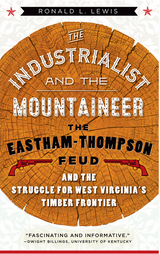 The Industrialist and the Mountaineer: The Eastham-Thompson Feud and the Struggle for West Virginia's Timber Frontier
RONALD L. LEWIS
West Virginia University Press, 2017 In 1897 a small landholder named Robert Eastham shot and killed timber magnate Frank Thompson in Tucker County, West Virginia, leading to a sensational trial that highlighted a clash between local traditions and modernizing forces. Ronald L. Lewis’s book uses this largely forgotten episode as a window into contests over political, environmental, and legal change in turn-of-the-century Appalachia.
The Eastham-Thompson feud pitted a former Confederate against a member of the new business elite who was, as a northern Republican, his cultural and political opposite. For Lewis, their clash was one flashpoint in a larger phenomenon central to US history in the second half of the nineteenth century: the often violent imposition of new commercial and legal regimes over holdout areas stretching from Appalachia to the trans-Missouri West. Taking a ground-level view of these so-called “wars of incorporation,” Lewis’s powerful microhistory shows just how strongly local communities guarded traditional relationships to natural resources. Modernizers sought to convict Eastham of murder, but juries drawn from the traditionalist population refused to comply. Although the resisters won the courtroom battle, the modernizers eventually won the war for control of the state’s timber frontier.
Industrialization and the State: The Changing Role of the Taiwan Government in the Economy, 1945-1985
Li-Min Hsueh
Harvard University Press Taiwan's export-led industrial development is often presented as a model of how state intervention promotes growth. Others see the same experience as a model of a private enterprise market at work. This study demonstrates that Taiwan policymakers varied their approach to development as circumstances changed. Export promotion of labor-intensive industries, which predominated in the 1960s, was supplemented by efforts to promote import-substituting heavy industries in the 1970s.
In the early 1980s there was a fundamental change in the economic environment as Taiwan's government reduced its active intervention in the economy and created a foundation for development based on information and other high-technology products. Taiwan's economy continued to prosper in the 1990s because policies and systems changed along with conditions.
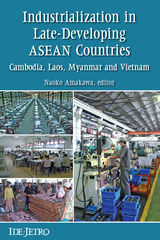 Industrialization in Late-Developing ASEAN Countries: Cambodia, Laos, Myanmar and Vietnam
Naoko Amakawa
National University of Singapore Press, 2010 Late industrializing countries are able to pick strategies for economic development based on the experiences of countries that preceded them. Cambodia, Laos, Myanmar and Vietnam (the CLMV countries) were closed off from the international community for many years, and they began to embrace a market economy at around the same time. Each bypassed the import-substitution strategy adopted by other Southeast Asian countries and began industrialization efforts with export growth funded by Foreign Direct Investment.
The outcomes differed significantly owing to geographical location, government policies, and internal economic conditions. Industrialization in Late-Developing ASEAN Countries explores these differences through case studies based on an extended research program conducted by the Institute of Developing Economies in Tokyo, which offered insights into models of economic growth, and into the trajectories followed by the four countries examined.
 The Industrialization of São Paulo, 1800-1945
By Warren Dean
University of Texas Press, 1969 São Paulo is one of the few places in the underdeveloped world where an advanced industrial system has grown out of a tropical raw-material-exporting economy. By 1960 there were 830,000 industrial workers in the state, producing $3.3 billion worth of goods. It had become Latin America’s largest industrial center. This is a study of the early years of manufacturing in São Paulo: how it was influenced by the growth and decline of the coffee trade; where it found its markets, its credit, and its labor force; and how it confronted the competition of imports. The principal focus, however, is on the manufacturers themselves, whose perceptions of their opportunities determined how industrialization was brought about. Warren Dean discusses their social origins, their connections with other sectors of the elite, their attitudes toward workers and consumers, and their view of the potentialities of economic development. He analyzes the political activities of the manufacturers, to discover both how they promoted their interests and how they confronted the larger challenge of social and political transformation. Paradoxically, the industrialization of São Paulo is not a “success story” of private entrepreneurship. Until after World War II manufacturing grew quite slowly, and its hallmarks were always low productivity, technical backwardness, and consumer hostility. More than half of the state’s present large-scale factory production and nearly all of its heavy industry was built by foreign capital or state enterprise, not by privately owned firms. Dean shows that this outcome is partly a consequence of the historical experience of domestic manufacture. Throughout the book the author points out the “peculiar articulations” of the industrial system of São Paulo—the significant social and political interests that determined what kinds of development were possible. The result is an exposition of an unusual case study in twentieth-century economic development.
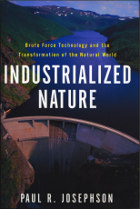 Industrialized Nature: Brute Force Technology and the Transformation of the Natural World
Paul R. Josephson
Island Press, 2002 The construction of the Three Gorges Dam on China's Yangtze River. The transformation of the Amazon into a site for huge cattle ranches and aluminum smelters. The development of Nevada's Yucca Mountain into a repository for nuclear waste. The extensive irrigation networks of the Grand Coulee and Kuibyshev Dams. On the face of it, these massive projects are wonders of engineering, financial prowess, and our seldom-questioned ability to modify nature to suit our immediate needs. For nearly a century we have relied increasingly on science and technology to harness natural forces, but at what environmental and social cost? In Industrialized Nature, historian Paul R. Josephson provides an original examination of the ways in which science, engineering, policy, finance, and hubris have come together, often with unforeseen consequences, to perpetuate what he calls "brute-force technologies"—the large-scale systems created to manage water, forest, and fish resources. Throughout the twentieth century, nations with quite different political systems and economic orientations all pursued this same technological subjugation of nature. Josephson compares the Soviet Union's heavy-handed efforts at resource management to similar projects undertaken in the United States, Norway, Brazil, and China. He argues that brute-force technologies require brute-force politics to operate. He shows how irresponsible—or well-intentioned but misguided—large-scale manipulation of nature has resulted in resource loss and severe environmental degradation. Josephson explores the ongoing industrialization of nature that is happening in our own backyards and around the world. Both a cautionary tale and a call to action, Industrialized Nature urges us to consider how to develop a future for succeeding generations that avoids the pitfalls of brute-force technologies.
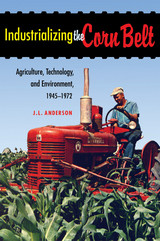 Industrializing the Corn Belt: Agriculture, Technology, and Environment, 1945-1972
J. L. Anderson
Northern Illinois University Press, 2009
From the late 1940s to the early 1970s, farmers in the Corn Belt transformed their region into a new, industrial powerhouse of large-scale production, mechanization, specialization, and efficiency. Many farm experts and implement manufacturers had urged farmers in this direction for decades, but it was the persistent labor shortage and cost-price squeeze following WWII that prompted farmers to pave the way to industrializing agriculture. Anderson examines the changes in Iowa, a representative state of the Corn Belt, in order to explore why farmers adopted particular technologies and how, over time, they integrated new tools and techniques.
In addition to the impressive field machinery, grain storage facilities, and automated feeding systems were the less visible, but no less potent, chemical technologies—antibiotics and growth hormones administered to livestock, as well as insecticide, herbicide, and fertilizer applied to crops. Much of this new technology created unintended consequences: pesticides encouraged the proliferation of resistant strains of plants and insects while also polluting the environment and threatening wildlife, and the use of feed additives triggered concern about the health effects to consumers.
Anderson explains that the cost of equipment and chemicals made unprecedented demands on farm capital, and in order to maximize production, farmers planted more acres with fewer but more profitable crops or specialized in raising large herds of a single livestock species. The industrialization of agriculture gave rural Americans a lifestyle resembling that of their urban and suburban counterparts. Yet the rural population continued to dwindle as farms required less human labor, and many small farmers, unable or unwilling to compete, chose to sell out.
Industrializing the Corn Belt—based on farm records, cooperative extension reports, USDA publications, oral interviews, trade literature, and agricultural periodicals—offers a fresh look at an important period of revolutionary change in agriculture through the eyes of those who grew the crops, raised the livestock, implemented new technology, and ultimately made the decisions that transformed the nature of the family farm and the Midwestern landscape.
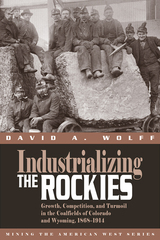 Industrializing the Rockies: Growth, Competition, and Turmoil in the Coalfields of Colorado and Wyoming, 1868-1914
David A. Wolff
University Press of Colorado, 2014 The two defining moments of Western coalfield labor relations have been massacres: Wyoming's Rock Springs Massacre of 1885 and Colorado's Ludlow Massacre of 1914. But it wasn't just the company guns that were responsible for the deaths of 28 Chinese coal miners and 13 women and children. It was the result of racial tensions and the economics of the coal industry itself. In Industrializing the Rockies, David A. Wolff places these deadly conflicts and strikes in the context of the Western coal industry from its inception in 1868 to the age of maturity in the early twentieth century. The result is the first book-length study of the emergence of coalfield labor relations and a general overview of the role of coal mining in the American West. Wolff examines the coal companies and the owners' initial motivations for investment and how these motivations changed over time. He documents the move from speculation to stability in the commodities market, and how this was reflected in the development of companies and company towns. Industrializing the Rockies also examines the workers and their workplaces: how the miners and laborers struggled to maintain mining as a craft and how the workforce changed, ethnically and racially, eventually leading to the emergence of a strong national union. Wolff shines light on the business of coal mining detailing the market and economic forces that influenced companies and deeply affected the lives of the workers.
Industry 5.0: Design, standards, techniques and applications for manufacturing
Wai Yie Leong
The Institution of Engineering and Technology, 2025 We are on the brink of another industrial transformation - one that builds upon the digital foundations of Industry 4.0 and reaches new heights with the emergence of Industry 5.0. Unlike its predecessor, which focused heavily on automation, cyber-physical systems, and the Internet of Things, Industry 5.0 shifts the paradigm toward human-centered solutions, blending the power of cutting-edge technologies with human creativity, expertise, and ethical considerations. This evolution is not merely technological; it is social and economic, reshaping how we live, work, and interact with our environment.
 Industry and Economic Decline in Seventeenth-Century Venice
Richard Tilden Rapp
Harvard University Press, 1976 One of the oldest, most commanding topics in early modern economic history--Venice's fall from commercial supremacy to relative insignificance--is here examined. What emerges is what many scholars have come to suspect: the catch-all phrase "the decline of Venice" embodies a myth. Rapp explains the paradox of seventeenth-century Venice, a republic that experienced a relative economic decline in commerce and industry with no absolute decline in overall income. In this systematic approach to the subject of economic decline, Rapp focuses on economic factors common to all Venetian enterprise: labor supply and quality, technology and capital employment, foreign demand, and government policy. The statistical backbone of this massively documented book is an employment census of the city derived from the records of the Naval Personnel Administration, the Collegio da Milizia da Mar. Throughout the book, many analytical insights are offered about population, guilds, technology, and economic policy in early modern Europe.
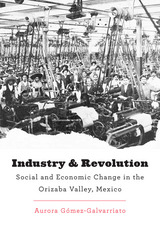 Industry and Revolution: Social and Economic Change in the Orizaba Valley, Mexico
Aurora Gómez-Galvarriato
Harvard University Press, 2013 The Mexican Revolution has long been considered a revolution of peasants. But Aurora Gómez-Galvarriato’s investigation of the mill towns of the Orizaba Valley reveals that industrial workers played a neglected but essential role in shaping the Revolution. By tracing the introduction of mechanized industry into the valley, she connects the social and economic upheaval unleashed by new communication, transportation, and production technologies to the political unrest of the revolutionary decade. Industry and Revolution makes a convincing argument that the Mexican Revolution cannot be understood apart from the changes wrought by the Industrial Revolution, and thus provides a fresh perspective on both transformations.
By organizing collectively on a wide scale, the spinners and weavers of the Orizaba Valley, along with other factory workers throughout Mexico, substantially improved their living and working conditions and fought to secure social and civil rights and reforms. Their campaigns fed the imaginations of the masses. The Constitution of 1917, which embodied the core ideals of the Mexican Revolution, bore the stamp of the industrial workers’ influence. Their organizations grew powerful enough to recast the relationship between labor and capital, not only in the towns of the valley, but throughout the entire nation.
The story of the Orizaba Valley offers insight into the interconnections between the social, political, and economic history of modern Mexico. The forces unleashed by the Mexican and the Industrial revolutions remade the face of the nation and, as Gómez-Galvarriato shows, their consequences proved to be enduring.
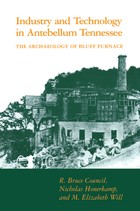 Industry and Technology in Antebellum Tennessee: The Archaeology of Bluff Furnace
R. Bruce Council
University of Tennessee Press, 1992 This excellent work will be of interest to regional historians as well as anyone interested in the history of American technology. It is the only historical archaeology report of its type that has been published, a detailed study of a Tennessee iron industry site. And it is written with the nonprofessional reader in mind. —Sam D. Smith, historic archaeologist, Tennessee Department of Conservation
Traditional images of the antebellum South emphasize agrarianism, slave labor, and an aristocratic social structure; absent from such mental landscapes are industrial facilities such as blast furnaces and rolling mills, coal mines and railyards, textile mills and lumberyards. This study of a major industrial site in Chattanooga, Tennessee, suggests the richly textured interplay between northern and southern technologies, slave labor and free, entrepreneur and planter, that in fact characterized the South on the brink of Civil War.
Early in 1860, the East Tennessee Iron Manufacturing Company put into blast the first coke-fired furnace in the Southern Appalachian iron-producing region. In November of that year, the wall of the furnace's hearth ruptured, and the hearth's contents of semimolten iron congealed into an intractable mass. Before repairs could be made, Tennessee was invaded by Union armies. Movable equipment was sent to Alabama, and the occupying Federal troops used the partially demolished stack for making lime. By century's end, Bluff Furnace had been buried and forgotten.
In the late 1970s, erosion from a storm sewer began to expose portions of the furnace. Subsequent investigations of the site united field archaeology, site history, and artifact analysis. Discussing the resulting data within the context of the regional and national midnineteenth-century iron industry, the authors have constructed an exemplary and highly readable introduction to the field of industrial archaeology.
The Authors: R. Bruce Council is Research Instructor at the Jeffrey L. Brown Institute of Archaeology, University of Tennessee, Chattanooga.
Nicholas Honerkamp is Director of the Jeffrey L. Brown Institute of Archaeology and UC Foundation Associate Professor of Sociology-Anthropology, University of Tennessee, Chattanooga.
M. Elizabeth Will holds a PhD in soil science from the University of Florida.
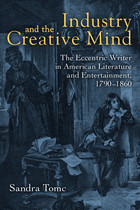 Industry and the Creative Mind: The Eccentric Writer in American Literature and Entertainment, 1790-1860
Sandra Tomc
University of Michigan Press, 2012 Industry and the Creative Mind takes a radically new look at the figure of the eccentric, alienated writer in American literature and entertainment from 1790 to 1860. Traditional scholarship takes for granted that the eccentric writer, modeled by such Romantic beings as Lord Byron and brought to life for American audiences by the gloomy person of Edgar Allan Poe, was a figure of rebellion against the excesses of modern commercial culture and industrial life. By contrast, Industry and the Creative Mind argues that in the United States myths of writerly moodiness, alienation, and irresponsibility predated the development of a commercial arts and entertainment industry and instead of forming a site of rebellion from this industry formed a bedrock for its development. Looking at the careers of a number of early American writers---Joseph Dennie, Nathaniel Parker Willis, Edgar Allan Poe, Fanny Fern, as well as a host of now forgotten souls who peopled the twilight worlds of hack fiction and industrial literature---this book traces the way in which early nineteenth-century American arts and entertainment systems incorporated writerly eccentricity in their "logical" economic workings, placing the mad, rebellious writer at the center of the industry's productivity and success.
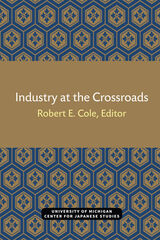 Industry at the Crossroads
Robert E. Cole, Editor
University of Michigan Press, 1982 The mood of the first U of M U.S.-Japan Auto conference in January 1981 could only be described as electric. People wanted to know what our problems were and how we could begin to solve them. Inherent in the latter issue was the questions, what could we learn from the Japanese? One left the conference with a sense that there was a call for action, a mandate to address the problems facing industry. The mood, about a year later, at the March 1982 U.S.-Japan Auto Conference was far more subdued. While undoubtedly this reflected the stream of statistics confirming the continually depressed state of the industry, another dynamic was possibly operating as well. Whereas the 1981 conference was "electric," a state of mind which flowed from a certain frustration at seemingly overwhelming difficulties and often vague expectations of what we might learn from the Japanese, the 1982 conference was more "workmanlike" in the sense that speakers discussed specifically what progress was being made in addressing problems. This more subdued, pragmatic approach continued throughout wand was reinforced by workshops held the day after the main conference. Instead of discussing the virtues of the Just-In-Time system in Japan, speakers addressed the practical problems of introducing such a system in the U.S. firms. Instead of railing about the benefits or failings of regulation of the industry, they discussed what we could reasonably expect from regulation. Instead of exhorting the industry to adopt Japanese practices willy-nilly, they focused on some of the limitations of the Japanese model in a range of different areas. Instead of trying to identify some magic key to Japanese success in the automotive industry, they discussed the interrelationships among various factors. At the same, they continued to explore the basic issues transforming the auto industry worldwide. In this connection, they sought to unravel some of the complexities associated with the internalization of the auto industry and trade obligations under the GATT.
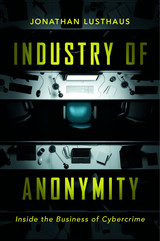 Industry of Anonymity: Inside the Business of Cybercrime
Jonathan Lusthaus
Harvard University Press, 2018 The most extensive account yet of the lives of cybercriminals and the vast international industry they have created, deeply sourced and based on field research in the world’s technology-crime hotspots.
Cybercrime seems invisible. Attacks arrive out of nowhere, their origins hidden by layers of sophisticated technology. Only the victims are clear. But every crime has its perpetrator—specific individuals or groups sitting somewhere behind keyboards and screens. Jonathan Lusthaus lifts the veil on the world of these cybercriminals in the most extensive account yet of the lives they lead, and the vast international industry they have created.
We are long past the age of the lone adolescent hacker tapping away in his parents’ basement. Cybercrime now operates like a business. Its goods and services may be illicit, but it is highly organized, complex, driven by profit, and globally interconnected. Having traveled to cybercrime hotspots around the world to meet with hundreds of law enforcement agents, security gurus, hackers, and criminals, Lusthaus takes us inside this murky underworld and reveals how this business works. He explains the strategies criminals use to build a thriving industry in a low-trust environment characterized by a precarious combination of anonymity and teamwork. Crime takes hold where there is more technical talent than legitimate opportunity, and where authorities turn a blind eye—perhaps for a price. In the fight against cybercrime, understanding what drives people into this industry is as important as advanced security.
Based on seven years of fieldwork from Eastern Europe to West Africa, Industry of Anonymity is a compelling and revealing study of a rational business model which, however much we might wish otherwise, has become a defining feature of the modern world.
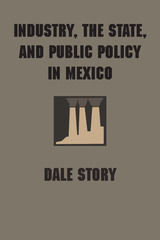 Industry, the State, and Public Policy in Mexico
By Dale Story
University of Texas Press, 1986 The industrialization process in Mexico began before that of any other nation in Latin America except Argentina, with the most rapid expansion of new industrial firms occurring in the 1930s and 1940s, and import substitution in capital goods evident as early as the late 1930s. Though Mexico’s trade relations have always been dependent on the United States, successive Mexican presidents in the postwar period attempted to control the penetration of foreign capital into Mexican markets. In Industry, the State, and Public Policy in Mexico, Dale Story, recognizing the significance of the Mexican industrial sector, analyzes the political and economic role of industrial entrepreneurs in postwar Mexico. He uses two original data sets—industrial production data for 1929–1983 and a survey of the political attitudes of leaders of the two most important industrial organizations in Mexico—to address two major theoretical arguments relating to Latin American development: the meaning of late and dependent development and the nature of the authoritarian state. Story accepts the general relevance of these themes to Mexico but asserts that the country is an important variant of both. With regard to the authoritarian thesis, the Mexican authoritarian state has demonstrated some crucial distinctions, especially between popular and elite sectors. The incorporation of the popular sector groups has closely fit the characteristics of authoritarianism, but the elite sectors have operated fairly independently of state controls, and the government has employed incentives or inducements to try to win their cooperation. In short, industrialists have performed important functions, not only in accumulating capital and organizing economic enterprises but also by bringing together the forces of social change. Industrial entrepreneurs have emerged as a major force influencing the politics of growth, and the public policy arena has become a primary focus of attention for industrialists since the end of World War II.
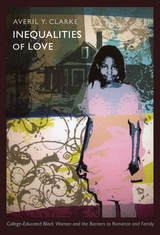 Inequalities of Love: College-Educated Black Women and the Barriers to Romance and Family
Averil Y. Clarke
Duke University Press, 2011 Inequalities of Love uses the personal narratives of college-educated black women to describe the difficulties they face when trying to date, marry, and have children. While conventional wisdom suggests that all women, regardless of race, must sacrifice romance and family for advanced educations and professional careers, Averil Y. Clarke’s research reveals that educated black women’s disadvantages in romance and starting a family are consequences of a system of racial inequality and discrimination. The author analyzes the accounts of black women who repeatedly return to incompatible partners as they lose hope of finding “Mr. Right” and reject unwed parenting because it seems to affirm a negative stereotype of black women’s sexuality that is inconsistent with their personal and professional identities. She uses national survey data to compare college-educated black women’s experiences of romance, reproduction, and family to those of less-educated black women and those of white and Hispanic women with degrees. She reports that degreed black women’s lives include less marriage and sex, and more unwanted pregnancy, abortion, and unwed childbearing than college-educated white and Hispanic women. Black women’s romantic limitations matter because they constitute deprivation and constraint in romance and because they illuminate important links between race, class, and gender inequality in the United States. Clarke’s discussion of the inequities that black women experience in romance highlights the connections between individuals’ sexual and reproductive decisions, their performance of professional or elite class identities, and the avoidance of racial stigma.
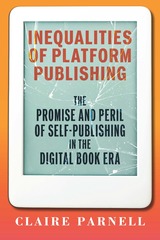 Inequalities of Platform Publishing: The Promise and Peril of Self-Publishing in the Digital Book Era
Claire Parnell
University of Massachusetts Press, 2025 Uncovering race, gender, and sexual biases in popular self-publishing platforms
The average reader need not go far in a bookstore before, knowingly or not, they encounter authors who started their careers by self-publishing prior to achieving commercial success. Examples include Margaret Atwood, Andy Weir, Colleen Hoover, Anna Todd, E. L. James, Scarlett St. Clair, and many more. Such stories of self-made writers are compelling and seem more attainable to others with the accessibility of modern publishing platforms such as Amazon, Apple, Google, Kobo, Wattpad, Webtoon, Radish, Inkitt, Qidian, Tapas, and Swoon Reads. However, as Claire Parnell uncovers in her examination of the two most popular—Amazon and Wattpad—these services in fact perpetuate systemic racial, gender, and sexual bias against authors of color and queer authors through their technological, economic, social, and cultural structures.
At a time when there is a real reckoning with the discrimination that has resulted in publishing opportunities for only relatively few privileged authors—who are often White, upper class, and male—self-publishing presents itself as an equalizer of sorts. Exploring that idea, Parnell shows that these platforms are not just intermediaries for information; they structure content and users in multiple, often inequitable, ways through their ability to set market conditions and apply algorithmic sorting. Combining original interviews, walkthrough method, metadata analysis, and more, Parnell finds that self-publishing platforms reproduce challenges for authors from marginalized communities. Far from equalizing the market, the new platforms instead frequently perpetuate the stubborn barriers to mainstream success for BIPOC and queer authors.
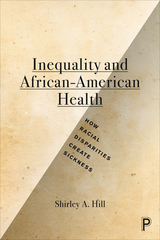 Inequality and African-American Health: How Racial Disparities Create Sickness
Shirley A. Hill
Bristol University Press, 2016 This book reveals how living in a highly racialized society affects health through multiple social contexts, including neighborhoods, personal and family relationships, and the medical system. Black-white disparities in health, illness, and mortality have been widely documented, but most research has focused on single factors that produce and perpetuate those disparities, such as individual health behaviors and access to medical care. Inequality and African-American Health is the first book to offer a comprehensive perspective on health and sickness among African Americans.
Starting with an examination of how race has been historically constructed in the United States generally and in its medical system specifically, it goes on to explore the resilience of these racial ideologies and practices. Shirley A. Hill shows that racial disparities in health reflect racial inequalities in living conditions, incarceration rates, family systems, and opportunities and that these racial disparities often cut across social class boundaries and have gender-specific consequences. Bringing together data from existing quantitative and qualitative research with new archival and interview research, this book marks a crucial advance in the fields of family studies, race and ethnicity studies, and medical sociology.
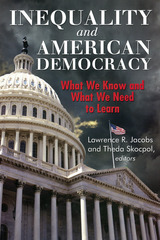 Inequality and American Democracy: What We Know and What We Need to Learn
Lawrence R. Jacobs
Russell Sage Foundation, 2005 In the twentieth century, the United States ended some of its most flagrant inequalities. The "rights revolution" ended statutory prohibitions against women's suffrage and opened the doors of voting booths to African Americans. Yet a more insidious form of inequality has emerged since the 1970s—economic inequality—which appears to have stalled and, in some arenas, reversed progress toward realizing American ideals of democracy. In Inequality and American Democracy, editors Lawrence Jacobs and Theda Skocpol headline a distinguished group of political scientists in assessing whether rising economic inequality now threatens hard-won victories in the long struggle to achieve political equality in the United States. Inequality and American Democracy addresses disparities at all levels of the political and policy-making process. Kay Lehman Scholzman, Benjamin Page, Sidney Verba, and Morris Fiorina demonstrate that political participation is highly unequal and strongly related to social class. They show that while economic inequality and the decreasing reliance on volunteers in political campaigns serve to diminish their voice, middle class and working Americans lag behind the rich even in protest activity, long considered the political weapon of the disadvantaged. Larry Bartels, Hugh Heclo, Rodney Hero, and Lawrence Jacobs marshal evidence that the U.S. political system may be disproportionately responsive to the opinions of wealthy constituents and business. They argue that the rapid growth of interest groups and the increasingly strict party-line voting in Congress imperils efforts at enacting policies that are responsive to the preferences of broad publics and to their interests in legislation that extends economic and social opportunity. Jacob Hacker, Suzanne Mettler, and Dianne Pinderhughes demonstrate the feedbacks of government policy on political participation and inequality. In short supply today are inclusive public policies like the G.I. Bill, Social Security legislation, the War on Poverty, and the Voting Rights Act of 1965 that changed the American political climate, mobilized interest groups, and altered the prospect for initiatives to stem inequality in the last fifty years. Inequality and American Democracy tackles the complex relationships between economic, social, and political inequality with authoritative insight, showcases a new generation of critical studies of American democracy, and highlights an issue of growing concern for the future of our democratic society.
 Inequality and the Global Economic Crisis
Douglas Dowd
Pluto Press, 2009 Inequality, per se, has been with us for millennia. With the creation, growth and deepening of Capitalism across the globe, inequalities take on new dimensions, unknown in previous eras. As Capitalism has spread its wings across the globe over the last 200 or so years, so inequalities have deepened and widened, both inside Nation Sates, between nation States. These inequalities are of income, wealth and of power.
This book, written by the widely respected economic historian Douglas Dowd at the age of 90, is notable for his own experience and vivid memory, of the 1929-31 recession. Since the 1980s, and the predominance of the present neo-liberal ideology, all of the inequalities that the book presents have grown rapidly. Written as a critique of the counter-productivity of growing economic inequality and vindicated by the present world banking crisis, Dowd presents a strong argument against capitalist expansion, exploitation and oligarchic rule.
Dowd's conclusions, that the globalization and growth of the financial sector will impact painfully upon hundreds of millions of people, unknown to most of us in our lifetime, Dowd's book deals with these issues from the unique perspective of inequality. Presenting both a history of the current crisis and an overview of it's, Inequality will appeal to both a broad general readership, and provides an extremely useful reference point for students of political economy, economic history, contemporary economics and global politics.
 Inequality, Crime, and Resistance in New York City
Timothy P. R. Weaver
Temple University Press, 2025 Looking closely at New York City’s political development since the 1970s, three “political orders”—conservativism, neoliberalism, and egalitarianism—emerged. In Inequality, Crime, and Resistance in New York City, Timothy Weaver argues that the intercurrent impact of these orders has created a constant battle for power.
Weaver brings these clashes to the fore by showing how New York City politics has been shaped by these conflicting orders. He examines the transformation of the city’s political economy in the aftermath of the 1975 fiscal crisis through neoliberal real estate development and privatization, the conservative rise of law-and-order politics in the 1970s to 1990s, and the efforts of the city’s egalitarians to respond to each of these shifts through social movements such as Occupy and Black Lives Matter.
Inequality, Crime, and Resistance in New York City belies glib assumptions about the city’s liberal character. Weaver reveals the metropolis not as a homogenous political whole, but as a site in which the victories and defeats of rival political forces change the terms of local citizenship for the millions of residents who call the city home.
In the series Political Lessons from American Cities
Inequality in Early America
Carla Gardina Pestana
Dartmouth College Press, 2015 This book was designed as a collaborative effort to satisfy a long-felt need to pull together many important but separate inquiries into the nature and impact of inequality in colonial and revolutionary America. It also honors the scholarship of Gary Nash, who has contributed much of the leading work in this field. The 15 contributors, who constitute a Who's Who of those who have made important discoveries and reinterpretations of this issue, include Mary Beth Norton on women's legal inequality in early America; Neal Salisbury on Puritan missionaries and Native Americans; Laurel Thatcher Ulrich on elite and poor women's work in early Boston; Peter Wood and Philip Morgan on early American slavery; as well as Gary Nash himself writing on Indian/white history. This book is a vital contribution to American self-understanding and to historical analysis.
Inequality Reexamined
Amartya Sen
Harvard University Press, 1992 The noted economist and philosopher Amartya Sen argues that the dictum “all people are created equal” serves largely to deflect attention from the fact that we differ in age, gender, talents, and physical abilities as well as in material advantages and social background. He argues for concentrating on higher and more basic values: individual capabilities and freedom to achieve objectives. By concentrating on the equity and efficiency of social arrangements in promoting freedoms and capabilities of individuals, Sen adds an important new angle to arguments about such vital issues as gender inequalities, welfare policies, affirmative action, and public provision of health care and education.
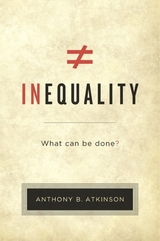 Inequality: What Can Be Done?
Anthony B. Atkinson
Harvard University Press, 2015 Winner of the Richard A. Lester Award for the Outstanding Book in Industrial Relations and Labor Economics, Princeton University
An Economist Best Economics and Business Book of the Year
A Financial Times Best Economics Book of the Year
Inequality is one of our most urgent social problems. Curbed in the decades after World War II, it has recently returned with a vengeance. We all know the scale of the problem—talk about the 99% and the 1% is entrenched in public debate—but there has been little discussion of what we can do but despair. According to the distinguished economist Anthony Atkinson, however, we can do much more than skeptics imagine.
“[Atkinson] sets forth a list of concrete, innovative, and persuasive proposals meant to show that alternatives still exist, that the battle for social progress and equality must reclaim its legitimacy, here and now… Witty, elegant, profound, this book should be read.”
—Thomas Piketty, New York Review of Books
“An uncomfortable affront to our reigning triumphalists. [Atkinson’s] premise is straightforward: inequality is not unavoidable, a fact of life like the weather, but the product of conscious human behavior.
—Owen Jones, The Guardian
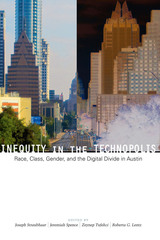 Inequity in the Technopolis: Race, Class, Gender, and the Digital Divide in Austin
Edited by Joseph Straubhaar, Jeremiah Spence, Zeynep Tufekci, and Roberta G. Lentz
University of Texas Press, 2012 Over the past few decades, Austin, Texas, has made a concerted effort to develop into a “technopolis,” becoming home to companies such as Dell and numerous start-ups in the 1990s. It has been a model for other cities across the nation that wish to become high-tech centers while still retaining the livability to attract residents. Nevertheless, this expansion and boom left poorer residents behind, many of them African American or Latino, despite local and federal efforts to increase lower-income and minority access to technology. This book was born of a ten-year longitudinal study of the digital divide in Austin—a study that gradually evolved into a broader inquiry into Austin’s history as a segregated city, its turn toward becoming a technopolis, what the city and various groups did to address the digital divide, and how the most disadvantaged groups and individuals were affected by those programs. The editors examine the impact of national and statewide digital inclusion programs created in the 1990s, as well as what happened when those programs were gradually cut back by conservative administrations after 2000. They also examine how the city of Austin persisted in its own efforts for digital inclusion by working with its public libraries and a number of local nonprofits, and the positive impact those programs had.
 Inescapable Entrapments?: The Civil-Military Decision Paths to Uruzgan and Helmand
Mirjam Grandia Mantas
Leiden University Press, 2021 "Military involvement in foreign policy decision-making, and its role as a driving force in that process, has long been anathema to both academic and practitioner circles. Without wanting to pursue the quest for principles or ultimate predictions this study looks specifically into the role of the military in foreign policy decision-making. It does so by carefully reconstructing and comparing the sequential series of decisions of a group of British and Dutch senior civil and military decision-makers which have led to the deployment of their militaries into to Afghan provinces of Helmand and Uruzgan. One of the most prominent findings of this analysis is the shaping ability of military initiatives on the series of decisions and the consequent path dependent reasoning during political deliberations on the deployment of military forces: the decision of the United Kingdom and the Netherlands to deploy their troops to southern Afghanistan was based on an emergent case that largely built itself. "
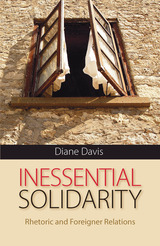 Inessential Solidarity: Rhetoric and Foreigner Relations
Diane Davis
University of Pittsburgh Press, 2010
In Inessential Solidarity, Diane Davis examines critical intersections of rhetoric and sociality in order to revise some of rhetorical theory’s basic presumptions. Rather than focus on the arguments and symbolic exchanges through which social relations are defined, Davis exposes an underivable rhetorical imperative, an obligation to respond that is as undeniable as the obligation to age. Situating this response-ability as the condition for, rather than the effect of, symbolic interaction, Davis both dissolves contemporary concerns about linguistic overdetermination and calls into question long-held presumptions about rhetoric’s relationship with identification, figuration, hermeneutics, agency, and judgment.
Spotlighting a rhetorical “situation” irreducible to symbolic relations, Davis proposes quite provocatively that rhetoric—rather than ontology (Aristotle/Heidegger), epistemology (Descartes), or ethics (Levinas)—is “first philosophy.” The subject or “symbol-using animal” comes into being, Davis argues both with and against Emmanuel Levinas, only inasmuch as it responds to the other; the priority of the other is not a matter of the subject's choice, then, but of its inescapable predicament. Directing the reader’s attention to this inessential solidarity without which no meaning-making or determinate social relation would be possible, Davis aims to nudge rhetorical studies beyond the epistemological concerns that typically circumscribe theories of persuasion toward the examination of a more fundamental affectability, persuadability, responsivity.
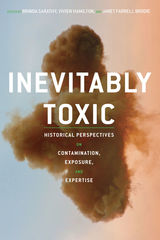 Inevitably Toxic: Historical Perspectives on Contamination, Exposure, and Expertise
Brinda Sarathy, Janet Brodie, and Vivien Hamilton
University of Pittsburgh Press, 2020 Winner, 2019 CHOICE Awards Outstanding Academic Title
Not a day goes by that humans aren’t exposed to toxins in our environment—be it at home, in the car, or workplace. But what about those toxic places and items that aren’t marked? Why are we warned about some toxic spaces' substances and not others? The essays in Inevitably Toxic consider the exposure of bodies in the United States, Canada and Japan to radiation, industrial waste, and pesticides. Research shows that appeals to uncertainty have led to social inaction even when evidence, e.g. the link between carbon emissions and global warming, stares us in the face. In some cases, influential scientists, engineers and doctors have deliberately "manufactured doubt" and uncertainty but as the essays in this collection show, there is often no deliberate deception. We tend to think that if we can’t see contamination and experts deem it safe, then we are okay. Yet, having knowledge about the uncertainty behind expert claims can awaken us from a false sense of security and alert us to decisions and practices that may in fact cause harm.
In the epilogue, Hamilton and Sarathy interview Peter Galison, a prominent historian of science whose recent work explores the complex challenge of long term nuclear waste storage.
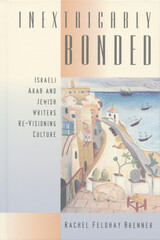 Inextricably Bonded: Israeli Arab and Jewish Writers Re-Visioning Culture
Rachel Feldhay Brenner
University of Wisconsin Press, 2003 Despite the tragic reality of the continuing Israeli-Arab conflict and deep-rooted beliefs that the chasm between Israeli Jews and Israeli Arabs is unbridgeable, this book affirms the bonds between the two communities. Rachel Feldhay Brenner demonstrates that the literatures of both ethnic groups defy the ideologies that have obstructed dialogue between the two peoples.
Brenner argues that literary critics have ignored the variety and the dissent in the novels of both Arab and Jewish writers in Israel, giving them interpretations that embrace the politics of exclusion and conform with Zionist ideology. Brenner offers insightful new readings that compare fiction by Jewish writers Amos Oz, A.B. Yehoshua, David Grossman, and others with fiction written in Hebrew by such Arab-Israeli writers as Atallah Mansour, Emile Habiby, and Anton Shammas. This parallel analysis highlights the moral and psychological dilemmas faced by both the Jewish victors and the Arab vanquished, and Brenner suggests that the hope for release from the historical trauma lies—on both sides—in reaching an understanding with and of the adversary.
Drawing upon the theories of Walter Benjamin, Jacques Lacan, Sigmund Freud, Emanuel Levinas, and others, Inextricably Bonded is an innovative and illuminating examination of literary dissent from dominant ideology.
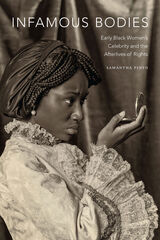 Infamous Bodies: Early Black Women’s Celebrity and the Afterlives of Rights
Samantha Pinto
Duke University Press, 2020 The countless retellings and reimaginings of the private and public lives of Phillis Wheatley, Sally Hemings, Sarah Baartman, Mary Seacole, and Sarah Forbes Bonetta have transformed them into difficult cultural and black feminist icons. In Infamous Bodies, Samantha Pinto explores how histories of these black women and their ongoing fame generate new ways of imagining black feminist futures. Drawing on a variety of media, cultural, legal, and critical sources, Pinto shows how the narratives surrounding these eighteenth- and nineteenth-century celebrities shape key political concepts such as freedom, consent, contract, citizenship, and sovereignty. Whether analyzing Wheatley's fame in relation to conceptions of race and freedom, notions of consent in Hemings's relationship with Thomas Jefferson, or Baartman's ability to enter into legal contracts, Pinto reveals the centrality of race, gender, and sexuality in the formation of political rights. In so doing, she contends that feminist theories of black women's vulnerable embodiment can be the starting point for future progressive political projects.
Infamous Desire: Male Homosexuality in Colonial Latin America
Edited by Pete Sigal
University of Chicago Press, 2003 What did it mean to be a man in colonial Latin America? More specifically, what did indigenous and Iberian groups think of men who had sexual relations with other men? Providing comprehensive analyses of how male homosexualities were represented in areas under Portuguese and Spanish control, Infamous Desire is the first book-length attempt to answer such questions. In a study that will be indispensable for anyone studying sexuality and gender in colonial Latin America, an esteemed group of contributors view sodomy through the lens of desire and power, relating male homosexual behavior to broader gender systems that defined masculinity and femininity.
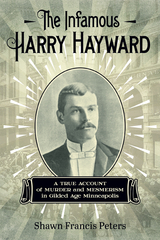 The Infamous Harry Hayward: A True Account of Murder and Mesmerism in Gilded Age Minneapolis
Shawn Francis Peters
University of Minnesota Press, 2018 A fascinating tale of seduction, murder, fraud, coercion—and the trial of the “Minneapolis Monster”
On a winter night in 1894, a young woman’s body was found in the middle of a road near Lake Calhoun on the outskirts of Minneapolis. She had been shot through the head. The murder of Kittie Ging, a twenty-nine-year-old dressmaker, was the final act in a melodrama of seduction and betrayal, petty crimes and monstrous deeds that would obsess reporters and their readers across the nation when the man who likely arranged her killing came to trial the following spring. Shawn Francis Peters unravels that sordid, spellbinding story in his account of the trial of Harry Hayward, a serial seducer and schemer whom some deemed a “Svengali,” others a “Machiavelli,” and others a “lunatic” and “man without a soul.” Dubbed “one of the greatest criminals the world has ever seen” by the famed detective William Pinkerton, Harry Hayward was an inveterate and cunning plotter of crimes large and small, dabbling in arson, insurance fraud, counterfeiting, and illegal gambling. His life story, told in full for the first time here, takes us into shadowy corners of the nineteenth century, including mesmerism, psychopathy, spiritualism, yellow journalism, and capital punishment. From the horrible fate of an independent young businesswoman who challenged Victorian mores to the shocking confession of Hayward on the eve of his execution (which, if true, would have made him a serial killer), The Infamous Harry Hayward unfolds a transfixing tale of one of the most notorious criminals in America during the Gilded Age.
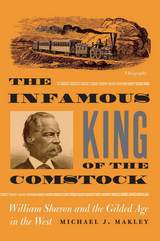 The Infamous King Of The Comstock: William Sharon And The Gilded Age In The West
Michael J. Makley
University of Nevada Press, 2009 William Sharon was one of the most colorful scoundrels in the nineteenth-century mining West. He epitomized the robber barons of the nation’s Gilded Age and the political corruption and moral decay for which that period remains notorious; yet he was also a visionary capitalist who controlled more than a dozen of the greatest mines on Nevada’s mighty Comstock Lode, built the Virginia & Truckee Railroad, manipulated speculation and prices on the San Francisco Stock Exchange, and revived the collapsed Bank of California. One enemy called him “a thoroughly bad man—a man entirely void of principle,” while a Comstock neighbor called him “one of the best men that ever lived in Virginia City.” Both descriptions were reasonably accurate. In this first-ever biography of one of Nevada’s most reviled historical figures, author Michael Makley examines Sharon’s complex nature and the turbulent times in which he flourished. Arriving in San Francisco shortly after the Gold Rush began, Sharon was soon involved in real estate, politics, banking, and stock speculation, and he was a party in several of the era’s most shocking business and sexual scandals. When he moved to Virginia City, Nevada’s mushrooming silver boomtown, his business dealings there soon made him known as the “King of the Comstock.” Makley’s engaging and meticulously researched account not only lays bare the life of the notorious but enigmatic Sharon but examines the broader historical context of his career—the complex business relationships between San Francisco and the booming gold and silver mining camps of the Far West; the machinations of rampant Gilded Age capitalism; and the sophisticated financial and technological infrastructure that supported Virginia City’s boomtown economy. The Infamous King of the Comstock offers a significant fresh perspective on Nevada and the mining West.
 Infancy
Tiffany Field
Harvard University Press, 1990 Until very recently, almost all books on infancy assumed basic infant immaturity. Remarkably, as Tiffany Field shows in her survey of recent research, investigators are discovering that infants possess sophisticated perceptual skills, such as hearing, even before birth. Newborns can sense touch and motion, discriminate tastes and smells, recognize their mother's voice, and imitate facial expressions. In fact, the newborn is an active learner, looking, reaching, sucking, and grimacing from its first moments in its new environment.
Field provides a readable account of our current knowledge about infant development. She looks at the emergence of sensorimotor and cognitive skills, which play an important role in social and emotional development in the months following birth as the infant experiences the world. In a chapter with important implications for working mothers, Field reviews the literature on infants in nursery and daycare programs, countering negative assessments with studies that show an enhancement of infants' social interaction in good care settings. In the concluding chapter, she pays particular attention to infants at risk because of disease (including AIDS), maternal drug use, prematurity, or maternal depression, and describes possible intervention strategies. The bibliography provides an invaluable summary of significant primary reference papers for professional researchers, students, and parents.
 Infancy: Its Place in Human Development
Jerome Kagan, Richard B. Kearsley, and Philip R. Zelazo
Harvard University Press, 1978 Here is a major new work on human infancy written by one of the country's leading developmental psychologists and two distinguished colleagues. At its core is the long-awaited report of the authors' six-year study of infant daycare. Important in its own right, this experiment becomes the occasion for a wide-ranging discussion of cognitive and emotional processes in infancy, of the effects of early experience on later growth, and of the deep-seated cultural and historical assumptions that underlie our views of human development.
For those concerned with social policy, the book provides the best empirical assessment now available of the effects of group care on the psychological well-being of infants. It also supplies a blueprint for quality daycare that may well stand as a model for future nurseries.
For those interested in the course of cognitive and emotional development, the book provides rich information about the major growth functions that characterize human infancy. It also outlines an explanation of these growth functions that links changes in emotional behavior to the maturation of underlying cognitive processes in a new and provocative way.
And for everyone interested in human nature, the book of offers a controversial thesis about the discontinuity of psychological growth that challenges some of our most fundamental assumptions about the nature of individual development.
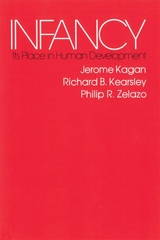 Infancy: Its Place in Human Development, With a New Foreword by the Authors
Jerome Kagan, Richard B. Kearsley, and Philip R. Zelazo
Harvard University Press, 1980 Here is a major new work on human infancy written by one of the country’s leading developmental psychologists and two distinguished colleagues. At its core is the long-awaited report of the authors’ six-year study of infant day care. Important in its own right, this experiment becomes the occasion for a wide-ranging discussion of cognitive and emotional processes in infancy, of the effects of early experience on later growth, and of the deep-seated cultural and historical assumptions that underlie our views of human development.
For those concerned with social policy, the book provides the best empirical assessment now available of the effects of group care on the psychological well-being of infants. It also supplies a blueprint for quality daycare that may well stand as a model for future nurseries. For those interested in the course of cognitive and emotional development, the book provides rich information about the major growth functions that characterize human infancy. It also outlines an explanation of these growth functions that links changes in emotional behavior to the maturation of underlying cognitive processes in a new and provocative way. And for everyone interested in human nature, the book of offers a controversial thesis about the discontinuity of psychological growth that challenges some of our most fundamental assumptions about the nature of individual development.
For this paperback edition, the statistical summary has been removed from the appendix to shorten the work and make it even more appealing to the general reader.
Infant, Perinatal, Maternal, and Childhood Mortality in the United States
Sam Shapiro, Edward R. Schlesinger, and Robert E. L. Nesbitt, Jr.
Harvard University Press In this volume, the authors use data from the U.S. Census and various specialized studies to analyze trends in infant, maternal, and childhood mortality in the United States and to provide comparisons with other countries. They discuss such variables as sex, cause of death, race, and geography, and, in the case of infant mortality, birth order, age, and prior pregnancy history of mother.
The Infant Scholar
Kathy Nilsson
Tupelo Press, 2015 Each poem in The Infant Scholar is an homage to those born brilliant and vulnerable, those who carry around with them a great comprehension at odds with their age. These poems are built upon facts and observations unearthed while panning the world for gold: diamonds sewn into the Romanov corsets that deflected bullets, or a lift-off in some early space flight to the moon, with a chimpanzee at the helm; Iphigenia saying goodbye to her beloved daylight, and Edward R. Murrow describing what soldiers heard as they entered prison camps at the end of World War II: “the handclapping of babies.”
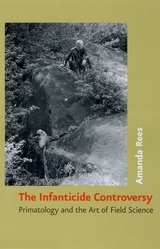 The Infanticide Controversy: Primatology and the Art of Field Science
Amanda Rees
University of Chicago Press, 2009 Infanticide in the natural world might be a relatively rare event, but as Amanda Rees shows, it has enormously significant consequences. Identified in the 1960s as a phenomenon worthy of investigation, infanticide had, by the 1970s, become the focus of serious controversy. The suggestion, by Sarah Hrdy, that it might be the outcome of an evolved strategy intended to maximize an individual’s reproductive success sparked furious disputes between scientists, disagreements that have continued down to the present day. Meticulously tracing the history of the infanticide debates, and drawing on extensive interviews with field scientists, Rees investigates key theoretical and methodological themes that have characterized field studies of apes and monkeys in the twentieth century. As a detailed study of the scientific method and its application to field research, The Infanticide Controversy sheds new light on our understanding of scientific practice, focusing in particular on the challenges of working in “natural” environments, the relationship between objectivity and interpretation in an observational science, and the impact of the public profile of primatology on the development of primatological research. Most importantly, it also considers the wider significance that the study of field science has in a period when the ecological results of uncontrolled human interventions in natural systems are becoming ever more evident.
 Infanticide in Tudor and Stuart England
Josephine Billingham
Amsterdam University Press, 2019 Infanticide in Tudor and Stuart England explores one of society’s darkest crimes using archival sources and discussing its representation in the drama, pamphlets and broadside ballads of the early modern period. It takes the reader on a journey through the streets and taverns where street literature was hawked, to the playhouses where the crime was dramatized, and the courts where it was tried and punished. Using a regional microstudy of coroners’ inquests and churchwardens’ presentments, coupled with theories of liminality, marginality and rites of passage, it reveals complex and contradictory attitudes to infants, women and the crime. As well as considering unwed women, the most common perpetrators of infanticide, the study shows that married women, men and the local community were also culpable, and the many reasons for this. Infanticide in Tudor and Stuart England is set in its European and historical contexts, revealing surprising continuities across time.
 Infants
Robert B. McCall
Harvard University Press, 1979 In the past few years, a new breed of baby-watchers has discovered more about infancy than has ever been known before. Infants brings this knowledge out of inaccessible academic journals and makes it available to everyone in direct language.
Written by a child psychologist who has studied the developmental progress of infants for many years, the book describes and interprets the fascinating capabilities of infants in their first years of life. It covers the ability of the newborn to see and hear their parents, their natural disposition toward getting to know caregivers, and the growth of love and attachment between parent and baby. It explores the changing mental abilities and social skills in the first and second years, and tells readers how they can observe these stages in children.
At a time when parents are increasingly beset by contradictory advice about infant care, many will find it useful to have a sensible and caring book that presents the latest information on understanding the behavior of babies. Parenting can then become the emotionally fulfilling and intellectually stimulating responsibility it should be.
 The Infant’s World
Philippe Rochat
Harvard University Press, 2004 What do infants know? What do they feel, and how do they come to understand what’s happening around them? How do they begin to construe others as persons with feelings and intentions? These questions inspire this remarkable new look at the infant’s world. The short answer? Infants are much more sophisticated perceivers, feelers, and thinkers of their world than we may think.
In this lively book, Philippe Rochat makes a case for an ecological approach to human development. Looking at the ecological niche infants occupy, he describes how infants develop capabilities and conceptual understanding in relation to three interconnected domains: the self, objects, and other people. Drawing on the great body of contemporary “competent infant” research, Rochat offers a thoughtful overview of many current, controversial topics, from neonatal imitation to early numeracy, to the development of self-awareness. In a provocative conclusion, he describes infancy as a series of key transitions—so dramatic that they are sometimes called “revolutions”—and maps out the processes that impel development.
Offering a unifying theoretical vision of the vast research of recent years, The Infant’s World is an inspiring introduction to the liveliest area of modern psychology.
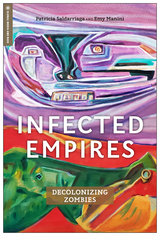 Infected Empires: Decolonizing Zombies
Patricia Saldarriaga
Rutgers University Press, 2022 Given the current moment—polarized populations, increasing climate fears, and decline of supranational institutions in favor of a rising tide of nationalisms—it is easy to understand the proliferation of apocalyptic and dystopian elements in popular culture. Infected Empires examines one of the most popular figures in contemporary apocalyptic film: the zombie. This harbinger of apocalypse reveals bloody truths about the human condition, the wounds of history, and methods of contending with them. Infected Empires considers parallels in the zombie genre to historical and current events on different political, theological and philosophical levels, and proposes that the zombie can be read as a figure of decolonization and an allegory of resistance to oppressive structures that racialize, marginalize, disable, and dispose of bodies. Studying films from around the world, including Latin America, Asia, Africa, the US, and Europe, Infected Empires presents a vision of a global zombie that points toward a posthuman and feminist future.
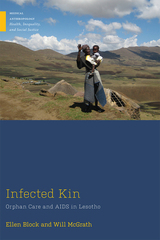 Infected Kin: Orphan Care and AIDS in Lesotho
Ellen Block
Rutgers University Press, 2019 AIDS has devastated communities across southern Africa. In Lesotho, where a quarter of adults are infected, the wide-ranging implications of the disease have been felt in every family, disrupting key aspects of social life. In Infected Kin, Ellen Block and Will McGrath argue that AIDS is fundamentally a kinship disease, examining the ways it transcends infected individuals and seeps into kin relations and networks of care. While much AIDS scholarship has turned away from the difficult daily realities of those affected by the disease, Infected Kin uses both ethnographic scholarship and creative nonfiction to bring to life the joys and struggles of the Basotho people at the heart of the AIDS pandemic. The result is a book accessible to wide readership, yet built upon scholarship and theoretical contributions that ensure Infected Kin will remain relevant to anyone interested in anthropology, kinship, global health, and care. Supplementary instructor resources ( https://www.csbsju.edu/sociology/faculty/anthropology-teaching-resources/infected-kin-teaching-resources)
 Infectious Disease: A Scientific American Reader
Edited by Scientific American
University of Chicago Press, 2008 The international public health scare that resulted last year when a man infected with multidrug-resistant tuberculosis flew overseas from the United States and back illustrates both the fear and the potential impact of highly infectious diseases in a global age. At a time when scientists warn of the potential for an influenza epidemic to rival the deadly outbreak of 1919 and newspapers feature alarming headlines about incidences of mad cow disease, infectious disease will be a critical area of concern and scientific study in the twenty-first century. Infectious Disease collects thirty of the most exciting, innovative, and significant articles on communicable illness published inthe pages of ScientificAmerican magazine since 1993. With sections devoted to viral infections, infectious disease, the immune system, and global management and treatment issues, Infectious Disease provides general readers and students with an excellent overview of recent research in the field. Roger I. Glass discusses a potential vaccine for the rotavirus—a leading cause of severe childhood diarrhea world wide and frequent killer of young children in developing nations. Jeffery K. Taubenberger and colleagues investigate the virulent strain of influenza that killed up to 40 million people in 1919 to suggest treatments and recommend preventative measures. And Paul R. Epstein looks into whether global warming could be harmful to our health, untangling research that suggests that many diseases will flourish as Earth’s atmosphere heats up. The prominence of disease in the ecology and evolution of human society has spurred investment in research and technology development, and, as a consequence, the topic is much discussed in the general and scientific media. Infectious Disease is the essential sourcebook for anyone looking for the solid science and compelling narrative behind the stories that make headlines.
 Infectious Disease Emergencies: Preparedness and Response
Edited by Dale Fisher
National University of Singapore Press, 2025 An accessible and diverse resource for infectious disease outbreak response.
For too long, the theory and practice of infectious disease outbreak response have been the domain of a small number of experienced responders. The COVID-19 pandemic brought global attention to the requirements of effective outbreak response, and the need for preparation across the key pillars. Decisionmakers, early career practitioners, and those in the field now have access to a comprehensive text that brings together evidence-based and practical insights from the best in the business.
Dale Fisher, Professor of Medicine at the National University of Singapore, was chair of WHO’s Global Outbreak Alert and Response Network before and during most of the pandemic. In this massive collaborative effort, he marshals nearly one hundred top public health leaders and experts from the front lines to present thirty-seven chapters on pandemic preparedness and response, drawing heavily on experiences from COVID-19, but also from Ebola, MERS, SARS-1, influenza, and other outbreaks of modern times. The contributors include experts from health ministries and Centres for Disease Control and national public health institutions around the world; from international organizations like the WHO, MSF, IFRC, and UNICEF; and research institutions and various NGOs from dozens of countries, adding to the diversity and richness of the descriptions.
Inference and Disputed Authorship
Frederick Mosteller and David L. Wallace
CSLI, 2013 The 1964 publication of Inference and Disputed Authorship made the cover of Time magazine and the attention of academics and the public alike for its use of statistical methodology to solve one of American history’s most notorious questions: the disputed authorship of the Federalist Papers.
Back in print for a new generation of readers, this classic volume applies mathematics, including the once-controversial Bayesian analysis, into the heart of a literary and historical problem by studying frequently used words in the texts. The reissue of this landmark book will be welcomed by anyone interested in the juncture of history, political science, and authorship.
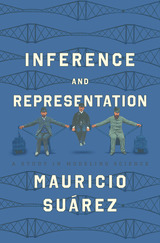 Inference and Representation: A Study in Modeling Science
Mauricio Suárez
University of Chicago Press, 2024 The first comprehensive defense of an inferential conception of scientific representation with applications to art and epistemology.
Mauricio Suárez develops a conception of representation that delivers a compelling account of modeling practice. He begins by discussing the history and methodology of model building, charting the emergence of what he calls the modeling attitude, a nineteenth-century and fin de siècle development. Prominent cases of models, both historical and contemporary, are used as benchmarks for the accounts of representation considered throughout the book. After arguing against reductive naturalist theories of scientific representation, Suárez sets out his own account: a case for pluralism regarding the means of representation and minimalism regarding its constituents. He shows that scientists employ a variety of modeling relations in their representational practice—which helps them to assess the accuracy of their representations—while demonstrating that there is nothing metaphysically deep about the constituent relation that encompasses all these diverse means.
The book also probes the broad implications of Suárez’s inferential conception outside scientific modeling itself, covering analogies with debates about artistic representation and philosophical thought over the past several decades.
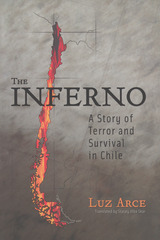 The Inferno: A Story of Terror and Survival in Chile
Luz Arce; Translated by Stacey Alba Skar
University of Wisconsin Press, 2004 As a member of Salvador Allende’s Personal Guards (GAP), Luz Arce worked with leaders of the Socialist Party during the Popular Unity Government from 1971 to1973. In the months following the coup, Arce served as a militant with others from the Left who opposed the military junta led by Augusto Pinochet, which controlled the country from 1973 to1990. Along with thousands of others in Chile, Arce was detained and tortured by Chile’s military intelligence service, the DINA, in their attempt to eliminate alternative voices and ideologies in the country. Arce’s testimonial offers the harrowing story of the abuse she suffered and witnessed as a survivor of detention camps, such as the infamous Villa Grimaldi.
But when faced with threats made to her family, including her young son, and with the possibility that she could be murdered as thousands of others had been, Arce began to collaborate with the Chilean military in their repression of national resistance groups and outlawed political parties. Her testimonial thus also offers a unique perspective from within the repressive structures as she tells of her work as a DINA agent whose identifications even lead to the capture of some of her former friends and compañeros.
During Chile’s return to democracy in the early 1990s, Arce experienced two fundamental changes in her life that led to the writing of her story. The first was a deep spiritual renewal through her contacts with the Catholic Church whose Vicariate of Solidarity had fought for human rights in the country during the dictatorship. The second was her decision to participate within the legal system to identify and bring to justice those members of the military who were responsible for the crimes committed from 1973 to1990. Luz Arce’s book invites readers to rethink the definition of testimonial narrative in Latin America through the unique perspective of a survivor-witness-confessor.
 Inferno: An Anatomy of American Punishment
Robert A. Ferguson
Harvard University Press, 2014 An Open Letters Monthly Best Nonfiction Book of the Year
America’s criminal justice system is broken. The United States punishes at a higher per capita rate than any other country in the world. In the last twenty years, incarceration rates have risen 500 percent. Sentences are harsh, prisons are overcrowded, life inside is dangerous, and rehabilitation programs are ineffective. Looking not only to court records but to works of philosophy, history, and literature for illumination, Robert Ferguson, a distinguished law professor, diagnoses all parts of a now massive, out-of-control punishment regime.
“If I had won the $400 million Powerball lottery last week I swear I would have ordered a copy for every member of Congress, every judge in America, every prosecutor, and every state prison official and lawmaker who controls the life of even one of the millions of inmates who exist today, many in inhumane and deplorable conditions, in our nation’s prisons.”
—Andrew Cohen, The Atlantic
“Inferno is a passionate, wide-ranging effort to understand and challenge…our heavy reliance on imprisonment. It is an important book, especially for those (like me) who are inclined towards avoidance and tragic complacency…[Ferguson’s] book is too balanced and thoughtful to be disregarded.”
—Robert F. Nagel, Weekly Standard
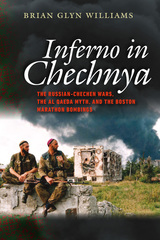 Inferno in Chechnya: The Russian-Chechen Wars, the Al Qaeda Myth, and the Boston Marathon Bombings
Brian Glyn Williams
University Press of New England, 2015 In 2013, the United States suffered its worst terrorist bombing since 9/11 at the annual running of the Boston Marathon. When the culprits turned out to be U.S. residents of Chechen descent, Americans were shocked and confused. Why would members of an obscure Russian minority group consider America their enemy? Inferno in Chechnya is the first book to answer this riddle by tracing the roots of the Boston attack to the Caucasus Mountains of southern Russia. Brian Glyn Williams describes the tragic history of the bombers’ war-devastated homeland—including tsarist conquest and two bloody wars with post-Soviet Russia that would lead to the rise of Vladimir Putin—showing how the conflict there influenced the rise of Europe’s deadliest homegrown terrorist network. He provides a historical account of the Chechens’ terror campaign in Russia, documents their growing links to Al Qaeda and radical Islam, and describes the plight of the Chechen diaspora that ultimately sent two Chechens to Boston. Inferno in Chechnya delivers a fascinating and deeply tragic story that has much to say about the historical and ethnic roots of modern terrorism.
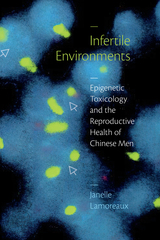 Infertile Environments: Epigenetic Toxicology and the Reproductive Health of Chinese Men
Janelle Lamoreaux
Duke University Press, 2023 In Infertile Environments, Janelle Lamoreaux investigates how epigenetic research into the effects of toxic exposure conceptualizes and configures environments. Drawing on fieldwork in a Nanjing, China, toxicology lab that studies the influence of pesticides and other pollutants on male reproductive and developmental health, Lamoreaux shows how the lab’s everyday research practices bring national, hormonal, dietary, maternal, and laboratory environments into being. She situates the lab’s work within broader Chinese history as well as the contemporary cultural and political moment, in which declining fertility rates and reproductive governance and technology are growing concerns. She also points to how toxicology in China is a transnational endeavor tied to both local conditions and international research agendas and infrastructures, which highlights the myriad scales and scope of epigenetic environments. At a moment of growing concerns about toxins, endocrine-disrupting chemicals, and climate change, Lamoreaux demonstrates that epigenetic research’s proliferation of environments produces new kinds of toxic relations that impact multiple generations of humans.
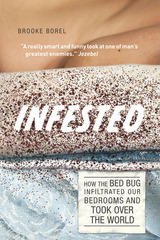 Infested: How the Bed Bug Infiltrated Our Bedrooms and Took Over the World
Brooke Borel
University of Chicago Press, 2015 Bed bugs. Few words strike such fear in the minds of travelers. In cities around the world, lurking beneath the plush blankets of otherwise pristine-looking hotel beds are tiny bloodthirsty beasts just waiting for weary wanderers to surrender to a vulnerable slumber. Though bed bugs today have infested the globe, the common bed bug is not a new pest at all. Indeed, as Brooke Borel reveals in this unusual history, this most-reviled species may date back over 250,000 years, wreaking havoc on our collective psyche while even inspiring art, literature, and music—in addition to vexatious red welts.
In Infested, Borel introduces readers to the biological and cultural histories of these amazingly adaptive insects, and the myriad ways in which humans have responded to them. She travels to meet with scientists who are rearing bed bug colonies—even by feeding them with their own blood (ouch!)—and to the stages of musicals performed in honor of the pests. She explores the history of bed bugs and their apparent disappearance in the 1950s after the introduction of DDT, charting how current infestations have flourished in direct response to human chemical use as well as the ease of global travel. She also introduces us to the economics of bed bug infestations, from hotels to homes to office buildings, and the expansive industry that has arisen to combat them.
Hiding during the day in the nooks and seams of mattresses, box springs, bed frames, headboards, dresser tables, wallpaper, or any clutter around a bed, bed bugs are thriving and eager for their next victim. By providing fascinating details on bed bug science and behavior as well as a captivating look into the lives of those devoted to researching or eradicating them, Infested is sure to inspire at least a nibble of respect for these tenacious creatures—while also ensuring that you will peek beneath the sheets with prickly apprehension.
 Infidel Poetics: Riddles, Nightlife, Substance
Daniel Tiffany
University of Chicago Press, 2009 Poetry has long been regarded as the least accessible of literary genres. But how much does the obscurity that confounds readers of a poem differ from, say, the slang that seduces listeners of hip-hop? Infidel Poetics examines not only the shared incomprensibilities of poetry and slang, but poetry's genetic relation to the spectacle of underground culture.
Charting connections between vernacular poetry, lyric obscurity, and types of social relations—networks of darkened streets in preindustrial cities, the historical underworld of taverns and clubs, the subcultures of the avant-garde—Daniel Tiffany shows that obscurity in poetry has functioned for hundreds of years as a medium of alternative societies. For example, he discovers in the submerged tradition of canting poetry and its eccentric genres—thieves’ carols, drinking songs, beggars’ chants—a genealogy of modern nightlife, but also a visible underworld of social and verbal substance, a demimonde for sale.
Ranging from Anglo-Saxon riddles to Emily Dickinson, from the icy logos of Parmenides to the monadology of Leibniz, from Mother Goose to Mallarmé, Infidel Poetics offers an exhilarating account of the subversive power of obscurity in word, substance, and deed.
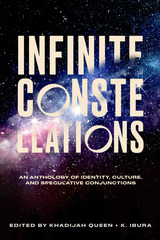 Infinite Constellations: An Anthology of Identity, Culture, and Speculative Conjunctions
Edited by Khadijah Queen and K. Ibura
University of Alabama Press, 2023 A galaxy of voices. A universe of belonging. The innovative fictions in Infinite Constellations showcase the voices and visions of 30 remarkable writers, both new and established, from the global majority: Native American/First Nation writers, South Asian writers, East Asian writers, Black American writers, Latinx writers, and Caribbean and Middle Eastern writers. These are visions both familiar and strange, but always rooted in the mystery of human relationships, the deep honoring of memory, and the rootedness to place and the centering of culture. The writers in this anthology mirror, instruct, bind and unbind, myth-make and myth-invert, transform and transmute, make us belly-laugh or hum our understanding, gasp or whisper gently, and remember that sometimes we need to holler and fight as we grieve. Any dangers herein, imagined or observed in poem and story, transport us: moving from latent to extant, then unleashed. This work does not presume; it presents and blossoms, creating a constellation of appearances, a symphony of belonging. “In collecting this work,” note editors Khadijah Queen and K. Ibura, “we felt humbled by the love threaded throughout the voices speaking to us in stories and poems that vault beyond expectation and settle in our consciousness as an expansion of what’s possible when we tend to one another with intention. We felt lifted, held aloft in these arrangements of language. We hope that as you read each story and poem, you will find the same sense of empowerment and celebration that we know has sustained us over countless generations, and in their beauty and humor and intelligence and complexity, continue to enrich us still.”
CONTRIBUTORS
George Abraham / Kenzie Allen / Shreya lla Anasuya / Thea Anderson / Wendy Chin-Tanner / Alton Melvar M. Depanas / Yohanca Delgado / Jennifer Elise Foerster / Aerik Francis / André O. Hoilette / Brian K. Hudson / K. Ibura / Pedro Iniguez / Ruth Ellen Kocher / Ra’Niqua Lee / Tonya Liburd / Kenji C. Liu / Shalewa Mackall / Lucien Darjeun Meadows / Melanie Merle / Juan J. Morales / Thirii Myo Kyaw Myint / Cindy Juyound Ok / Daniel José Older / Soham Patel / Lynn C. Pitts/ Khadijah Queen / Sheree Renée Thomas / Sarah Sophia Yanni / dg nanouk okpik / shakirah peterson
Infinite Conversation
Maurice Blanchot
University of Minnesota Press, 1992 In this landmark volume, Blanchot sustains a dialogue with a number of thinkers whose contributions have marked turning points in the history of Western thought and have influenced virtually all the themes that inflect the contemporary literary and philosophical debate today.
“Blanchot waits for us still to come, to be read and reread. . . I would say that never as much as today have I pictured him so far ahead of us.” Jacques Derrida
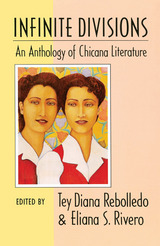 Infinite Divisions: An Anthology of Chicana Literature
Tey Diana Rebolledo
University of Arizona Press, 1993 Given the explosive creativity shown by Chicana writers over the past two decades, this first major anthology devoted to their work is a major contribution to American letters. It highlights the key issues, motifs, and concerns of Mexican American women from 1848 to the present, and particularly reflects the modern Chicana's struggle for identity. Among the recurring themes in the collection is a re-visioning of foremothers such as the historical Malinche, the mythical Llorona, and pioneering women who settled the American Southwest from the sixteenth to twentieth centuries. Also included are historical documents on the lives, culture, and writings of Mexican American women in the nineteenth century, as well as oral histories recorded by the Federal Writers Project in the 1930s.
Through poetry, fiction, drama, essay, and other forms, this landmark volume showcases the talents of more than fifty authors, including Gloria E. Anzaldúa, Ana Castillo, Lorna Dee Cervantes, Denise Chávez, Sandra Cisneros, Pat Mora, Cherríe Moraga, and María Helena Viramontes.
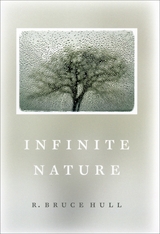 Infinite Nature
R. Bruce Hull
University of Chicago Press, 2006 You would be hard-pressed to find someone who categorically opposes protecting the environment, yet most people would agree that the environmentalist movement has been ineffectual and even misguided. Some argue that its agenda is misplaced, oppressive, and misanthropic—a precursor to intrusive government, regulatory bungles, and economic stagnation. Others point out that its alarmist rhetoric and preservationist solutions are outdated and insufficient to the task of galvanizing support for true reform.
In this impassioned and judicious work, R. Bruce Hull argues that environmentalism will never achieve its goals unless it sheds its fundamentalist logic. The movement is too bound up in polarizing ideologies that pit humans against nature, conservation against development, and government regulation against economic growth. Only when we acknowledge the infinite perspectives on how people should relate to nature will we forge solutions that are respectful to both humanity and the environment.
Infinite Nature explores some of these myriad perspectives, from the scientific understandings proffered by anthropology, evolution, and ecology, to the promise of environmental responsibility offered by technology and economics, to the designs of nature envisioned in philosophy, law, and religion. Along the way, Hull maintains that the idea of nature is social: in order to reach the common ground where sustainable and thriving communities are possible, we must accept that many natures can and do exist.
Incisive, heartfelt, and brimming with practical solutions, Infinite Nature brings a much-needed and refreshing voice to the table of environmental reform.
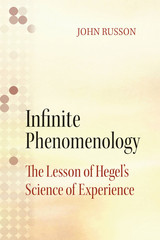 Infinite Phenomenology: The Lessons of Hegel's Science of Experience
John Russon
Northwestern University Press, 2016 Infinite Phenomenology builds on John Russon’s earlier book, Reading Hegel’s Phenomenology, to offer a second reading of Hegel’s Phenomenology of Spirit. Here again, Russon writes in a lucid, engaging style and, through careful attention to the text and a subtle attunement to the existential questions that haunt human life, he demonstrates how powerfully Hegel’s philosophy can speak to the basic questions of philosophy. In addition to original studies of all the major sections of the Phenomenology, Russon discusses complementary texts by Hegel, namely, the Philosophy of Spirit, the Philosophy of Right, and the Science of Logic. He concludes with an appendix that discusses the reception and appropriation of Hegel’s Phenomenology in twentieth-century French philosophy. As with Russon’s earlier work, Infinite Phenomenology will remain essential reading for those looking to engage Hegel’s essential, yet difficult, text.
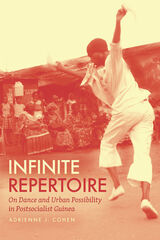 Infinite Repertoire: On Dance and Urban Possibility in Postsocialist Guinea
Adrienne J. Cohen
University of Chicago Press, 2021 In Guinea’s capital city of Conakry, dance is everywhere. Most neighborhoods boast at least one dance troupe, and members of those troupes animate the city’s major rites of passage and social events. In Infinite Repertoire, Adrienne Cohen shows how dance became such a prominent—even infrastructural—feature of city life in Guinea, and tells a surprising story of the rise of creative practice under a political regime known for its authoritarianism and violent excesses. Guinea’s socialist state, which was in power from 1958 to 1984, used staged African dance or “ballet” strategically as a political tool, in part by tapping into indigenous conceptualizations of artisans as powerful figures capable of transforming the social fabric through their manipulation of vital energy. Far from dying with the socialist revolution, Guinean ballet continued to thrive in Conakry after economic liberalization in the 1980s, with its connection to transformative power retrofitted for a market economy and a rapidly expanding city. Infinite Repertoire follows young dancers and percussionists in Conakry as they invest in the present—using their bodies to build a creative urban environment and to perform and redefine social norms and political subjectivities passed down from the socialist generation before them. Cohen’s inventive ethnography weaves the political with the aesthetic, placing dance at the center of a story about dramatic political change and youthful resourcefulness in one of the least-studied cities on the African continent.
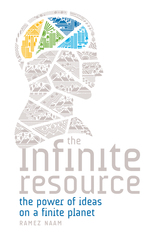 The Infinite Resource: The Power of Ideas on a Finite Planet
Ramez Naam
University Press of New England, 2013 Climate change. Finite fossil fuels. Fresh water depletion. Rising commodity prices. Ocean acidification. Overpopulation. Deforestation. Feeding the world’s billions. We’re beset by an array of natural resource and environmental challenges. They pose a tremendous risk to human prosperity, to world peace, and to the planet itself. Yet, if we act, these problems are addressable. Throughout history we’ve overcome similar problems, but only when we’ve focused our energies on innovation. For the most valuable resource we have isn’t oil, water, gold, or land – it’s our stockpile of useful ideas, and our continually growing capacity to expand them. In this remarkable book, Ramez Naam charts a course to supercharge innovation – by changing the rules of our economy – that can lead the whole world to greater wealth and human well-being, even as we dodge looming resource crunches and environmental disasters and reduce our impact on the planet. “Most books about the future are written by blinkered Pollyannas or hand-wringing Cassandras. Ramez Naam—Egypt-born, Illinois-raised, a major contributor to the computer revolution—is neither. Having thought about science, technology and the environment for decades, he has become that rarest of creatures: a clear-eyed optimist. Concise, informed and passionately argued, The Infinite Resource both acknowledges the very real dangers that lie ahead for the human enterprise and the equally real possibility that we might not only survive but thrive.” —Charles Mann, New York Times bestselling author of 1491 and 1493 “An amazing book. Throughout history, the most important source of new wealth has been new ideas. Naam shows how we can tap into and steer that force to overcome our current problems and help create a world of abundance.” —Peter H. Diamandis, MD, chairman and CEO, X PRIZE Foundation; chairman, Singularity University; and author, Abundance—The Future Is Better Than You Think
 Infinite Variety: The Life and Legend of the Marchesa Casati
Scot D. Ryersson
University of Minnesota Press, 2004 For the first three decades of the twentieth century, the Marchesa Casati astounded Europe: nude servants gilded in gold leaf attended her; bizarre wax mannequins sat as guests at her dining table; and she was infamous for her evening strolls, naked beneath her furs, parading cheetahs on diamond-studded leashes. Artists painted, sculpted, and photographed her; poets praised her strange beauty. Among them were Gabriele D’Annunzio, Man Ray, Jean Cocteau, Cecil Beaton, and American writers Tennessee Williams, Jack Kerouac, and Ezra Pound. Couturiers Fortuny, Poiret, and Erté dressed her. Some became lovers, others awestruck admirers, but all were influenced by this extraordinary muse. The extravagance ended in 1930 when Casati was more than twenty-five million dollars in debt. Fleeing to London, she spent her final flamboyant years there until her death in 1957. Now nearly a half-century later, Casati’s fashion legacy continues to inspire such designers as John Galliano, Karl Lagerfeld, and Tom Ford. Fully authorized and accurate, this is the fantastic story of the Marchesa Luisa Casati.Scot D. Ryersson is an award-winning freelance writer, illustrator, and graphic designer. He lives in New Jersey.Michael Orlando Yaccarino is a freelance writer specializing in international genre film, fashion, music, and unconventional historical figures. He lives in New Jersey.
Infinite-Dimensional Optimization and Convexity
Ivar Ekeland and Thomas Turnbull
University of Chicago Press, 1983 In this volume, Ekeland and Turnbull are mainly concerned with existence theory. They seek to determine whether, when given an optimization problem consisting of minimizing a functional over some feasible set, an optimal solution—a minimizer—may be found.
Infinitely Determinable: Children and Childhood in Modern Literature
Davide Giuriato
Diaphanes, 2021 Upon the “discovery of childhood,” as named by Philippe Ariès, bourgeois culture and modern literature marked out an arcane realm that, while scarcely accessible for adults, acted as a space for projections of the most contradictory kind and diverse ideological purposes: childhood. As this book reveals, from the eighteenth century onwards, the child increasingly came into focus in literature as a mysterious creature. Now the child seems a strange being, constantly unsettling and alienating, although exposed to ongoing territorialization. This is possible because the space of ‘childhood’ is essentially blank and indefinite. Modernity, therefore, has discovered it as a zone, in the words of Friedrich Schiller of “boundless determinability."
Infinity Diary
Cyril Wong
Seagull Books, 2020 This volume of poems by Cyril Wong, one of the leading figures of poetry in Singapore, reflects the many ways in which love between two men can unfold, balancing emotional outpourings with meditations on the nature of relationships. The poetry punctures the sometimes oppressive reality of life in a city that is hypermodern yet far from free and, through twists and turns, ultimately lifts the reader to a place beyond pleasure and pain. Sensual, anecdotal and, of course, confessional, Infinity Diary charts an evolution in the work of one of Asia’s most intimate English-language poets.
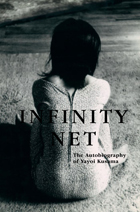 Infinity Net: The Autobiography of Yayoi Kusama
Yayoi Kusama
University of Chicago Press, 2011 In 1957, encouraged by Georgia O’Keeffe, artist Yayoi Kusama left Japan for New York City to become a star. By the time she returned to her home country in 1973, she had established herself as a leader of New York’s avant-garde movement, known for creating happenings and public orgies to protest the Vietnam War and for the polka dots that had become a trademark of her work. Her sculptures, videos, paintings, and installations are to this day included in major international exhibitions. Available for the first time in English, Infinity Net paints a multilayered portrait of this fascinating artist. Taking us from her oppressive childhood in postwar Japan to her present life in the psychiatric hospital where she voluntarily stays—and is still productive—Kusama’s autobiography offers insight into the persona of mental illness that has informed her work. While she vibrantly describes the hallucinatory episodes she experiences, her tale is punctuated by stories of her pluck and drive in making her artistic voice heard. Conveying the breadth and ambition of her own work, Kusama also offers a dazzling snapshot of 1960s and 1970s New York City and her encounters with its artists—she collaborates with Andy Warhol, shares an apartment with Donald Judd, and becomes romantically entangled with Joseph Cornell. Replete with the sense of the sheer necessity within an artist to create, Infinity Net is an energetic and juicy page-turner that offers a glimpse into Kusama’s exhilarating world.
 Infinity Pool
Jonathan Thirkield
University of Chicago Press, 2024 Moving through the realms of digital technologies, these poems cut to the core of our physical human experiences amid a virtually mediated world.
Diving through illusions and phantoms of virtual realms and into the human desire for boundless possibility, Infinity Pool charts the ways technologies have become embedded in our minds, bodies, and lives. Immersed in a world of data streams, neural nets, spider algorithms, and electronic terminals, Jonathan Thirkield’s poems plumb the dissonances and shrinking distances between ourselves and digital technologies, imagining what becomes of the fragile machinery of the human body amid a rapidly transforming world.
Thirkield turns to language as a mediator and explores infinity as a mathematical concept, a multiverse conceit, and a driver of the computational imagination. Traveling across the full spectrum of digital experience—from satellites crossing the edges of our solar system to microscopic bytes that operate beneath our perception—this collection is a testament to the future we imagine ourselves to be living through and to what happens when our escapist desires give way to the realities of birth, loss, parenthood, and sickness.
Through lyrical, narrative, and formal mutations, these poems cut through a decade of exponential technological growth, landing in the reality of our corporeal experiences: the isolation of chronic illness, the daunting journeys of children growing up today, and the hope that we can remain connected to each other no matter how tenuous the ties.
The Infinity Room
Gary Fincke
Michigan State University Press, 2019 In The Infinity Room the reader will find polished, precise poems that are built around the author’s experiences of touring Nevada’s atomic bomb test sites, the Chernobyl disaster site, and Oak Ridge, as well as living for decades near Three Mile Island. These iconic landmarks of the threat of nuclear technology become more than talking points as they provide grounding for narratives of faith and skepticism from multiple viewpoints that employ science, religion, history, myth, politics, and popular culture, including a piece about the author’s experience as a student at Kent State at the time of the National Guard shooting. The poems here are tightly controlled but electric, dark yet vibrant with love and longing, and packed with memorable characters and places that are presented through a singular, lyrical voice that connects us to what it means to be human.
 Inflation and Disinflation: The Israeli Experiment
Leonardo Leiderman
University of Chicago Press, 1993 During the early 1980s, Israel's inflation rate rose to almost 500% per year—one of the highest inflation rates in the developed world. In 1985, the Israeli government implemented a program that immediately reduced inflation to 15%-20%, where it remained for the rest of the decade. How did the economy deal with these major changes so rapidly and successfully? In these eighteen articles, Leonardo Leiderman discusses why the Israeli plan worked and considers how other countries might benefit from similar policies.
Even though standard economic models predict that output will drop and unemployment will rise during disinflation, Israel saw a boom in private consumption and large increases in real wages that lasted for about three years. To understand how the effects of Israeli disinflation policies defied typical expectations, Leiderman investigates how monetary fiscal policy determined Israel's runaway inflation and how the country brought its economy abruptly under control. He finds that rates of inflation and consumption depend on the public's expectations about future fiscal adjustments and that foreign trade shocks do not inevitably lead to a long-term rise in the inflation rate. His illumination of international trade and domestic policies, past and present, will interest academic economists and policymakers alike.
Inflation: Causes and Effects
Edited by Robert E. Hall
University of Chicago Press, 1983 This volume presents the latest thoughts of a brilliant group of young economists on one of the most persistent economic problems facing the United States and the world, inflation. Rather than attempting an encyclopedic effort or offering specific policy recommendations, the contributors have emphasized the diagnosis of problems and the description of events that economists most thoroughly understand. Reflecting a dozen diverse views—many of which challenge established orthodoxy—they illuminate the economic and political processes involved in this important issue.
Inflation, Exchange Rates, and the World Economy: Lectures on International Monetary Economics
W. Max Corden
University of Chicago Press, 1986 The previous editions of this work were praised as lucid and insightful introductions to a complicated subject. This third edition incorporates major additions to update the survey while retaining its clarity. Selected from the second edition are essential chapters on developments in balance-of-payments theories, inflation and exchange rates, the international adjustment to the oil price rise, and monetary integration in Europe. In three new chapters, Corden considers the international transmission of economic disturbances, the international macrosystem, and macroeconomic policy coordination.
Inflation, Tax Rules, and Capital Formation
Martin Feldstein
University of Chicago Press, 1983 Inflation, Tax Rules, and Capital Formation brings together fourteen papers that show the importance of the interaction between tax rules and monetary policy. Based on theoretical and empirical research, these papers emphasize the importance of including explicit specifications of the tax system in such study.
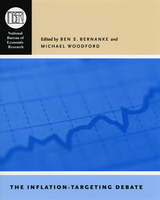 The Inflation-Targeting Debate
Edited by Ben S. Bernanke and Michael Woodford
University of Chicago Press, 2004 Over the past fifteen years, a significant number of industrialized and middle-income countries have adopted inflation targeting as a framework for monetary policymaking. As the name suggests, in such inflation-targeting regimes, the central bank is responsible for achieving a publicly announced target for the inflation rate. While the objective of controlling inflation enjoys wide support among both academic experts and policymakers, and while the countries that have followed this model have generally experienced good macroeconomic outcomes, many important questions about inflation targeting remain.
In Inflation Targeting, a distinguished group of contributors explores the many underexamined dimensions of inflation targeting—its potential, its successes, and its limitations—from both a theoretical and an empirical standpoint, and for both developed and emerging economies. The volume opens with a discussion of the optimal formulation of inflation-targeting policy and continues with a debate about the desirability of such a model for the United States. The concluding chapters discuss the special problems of inflation targeting in emerging markets, including the Czech Republic, Poland, and Hungary.
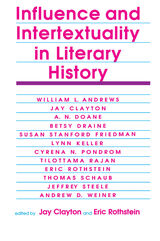 Influence and Intertextuality in Literary History
John B. Clayton
University of Wisconsin Press, 1991 This important collection explores and clarifies two of the most contested ideas in literary theory today, influence and intertextuality. The study of influence tends to center on major authors and canonical works, identifying prior documents as “sources” or “contexts” for a given author. Intertextuality, on the other hand, is a concept unconcerned with authors as individuals; it treats all texts as part of a network of discourse that includes culture, history, and social practices as well as other literary works. In thirteen essays drawing on the entire spectrum of English and American literary history, this volume considers the relationship between these two terms—their rivalry, their kinship, their range of uses.
Debates about these two concepts have been crucial to the “new historicism” and the resurgence of interest in literary history. The essays in this volume employ a refreshing array of examples from that history—poetry of the Renaissance and the twentieth century, novels of the eighteenth through twentieth centuries, Old English texts, and postmodernist productions that have served as recurrent “intertexts” for contemporary theory. The contributors treat such currently vital questions as the role of the author, canon formation, gender, causality, and the social dimension of texts. They illuminate old assumptions and new ideas about agency that lie behind notions of influence, and they examine models of an anonymous textual field that lie behind notions of intertextuality.
The volume takes much of its character from its own intertextual origin as a group project of the English faculty at the University of Wisconsin–Madison. Though diverse in their academic interests, concerns, and experience, the contributors particpated in an ongoing intellectual exchange that is a model of how new scholarship can arise from dialogue.
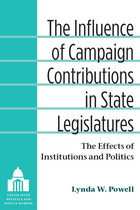 The Influence of Campaign Contributions in State Legislatures: The Effects of Institutions and Politics
Lynda W. Powell
University of Michigan Press, 2012 Campaign contributions are widely viewed as a corrupting influence but most scholarly research concludes that they have marginal impact on legislative behavior. Lynda W. Powell shows that contributions have considerable influence in some state legislatures but very little in others. Using a national survey of legislators, she develops an innovative measure of influence and delineates the factors that explain this great variation across the 99 U.S. state legislative chambers. Powell identifies the personal, institutional, and political factors that determine how much time a legislator devotes to personal fundraising and fundraising for the caucus. She shows that the extent of donors' legislative influence varies in ways corresponding to the same variations in the factors that determine fundraising time. She also confirms a link between fundraising and lobbying with evidence supporting the theory that contributors gain access to legislators based on donations, Powell's findings have important implications for the debate over the role of money in the legislative process.
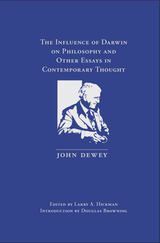 The Influence of Darwin on Philosophy and Other Essays in Contemporary Thought
John Dewey. Edited by Larry A. Hickman. Introduction by Douglas Browning
Southern Illinois University Press, 2007 Presenting Dewey’s new view of philosophical inquiry This critical edition of The Influence of Darwin on Philosophy and Other Essays in Contemporary Thought presents the results of John Dewey’s patient construction, throughout the previous sixteen years, of the radically new view of the methods and concerns of philosophical inquiry. It was a view that he continued to defend for the rest of his life. In the 1910 The Influence of Darwin on Philosophy and Other Essays in Contemporary Thought—the first collection of Dewey’s previously published, edited essays—John Dewey provided readers with an overview of the scope and direction of his philosophical vision in one volume. The order in which the eleven essays were presented was a reverse chronology, with more recently published essays appearing first. The collection of eleven essays offered a detailed portrait of Dewey’s proposed reconstruction of the traditional concepts of knowledge and truth. It furthermore elaborated on how his new logic and his proposal regarding knowledge and truth fit comfortably together, not only with each other but also with a pragmatically proper understanding of belief, reality, and experience. Because material in the Collected Works of John Dewey, 1882–1953 was published chronologically, however, the essays published together in the 1910 Darwin book have appeared in seven different volumes in the Collected Works. This new, critical edition restores a classic collection of essays authored and edited by John Dewey as they originally appeared in the volume. The edition is presented with ancillary materials, including responses by Dewey’s critics and an introduction by Douglas Browning.
 The Influence of Prophecy in the Later Middle Ages: A Study in Joachimism
Marjorie Reeves
University of Notre Dame Press, 1994
Since the original publication of this title, the twelfth-century Calabrian Abbot Joachim of Fiore has been accorded an increasingly central position in the history of medieval thought and culture. In this classic work Marjorie Reeves shows the wide extent of Joachimist influence from the thirteenth to the sixteenth centuries and demonstrates the continuity between medieval and Renaissance thought in the field of prophecy.
Reeves pinpoints some of the most original aspects of Joachim's theology of history and traces his reputation and influence through succeeding centuries. She also explains how his vision of a final age of the spirit in history became a powerful force in shaping expectations of the future in Western Europe. The book traces in detail the development of the three great images in which these expectations came to be focused: New Spiritual Men, Angelic Pope, and Last World Emperor. In addition, Reeves illuminates how the pervading influence of Joachim's concepts of a future golden age forms the basis for an understanding of prophetic visions in later centuries.
 The Influence of the Commons on Early Legislation: A Study of the Fourteenth and Fifteenth Centuries
Howard Levi Gray
Harvard University Press Accounts of the early activities of Parliament have been based largely upon two series of enrolled records, the Rolls of Parliament and the Statute Rolls. Little attention has been given to the types of bills recorded in the first or to the preparation of the statutes collected in the second. Yet a considerable number of documents antecedent to both sorts of Rolls survive and often promise new information. To ascertain what this information is and especially to interpret the Rolls of Parliament in the light of the originals of the bills which they record, is the aim of the present volume. Various types of bills emerge, some of which originated with the Commons, some elsewhere. The number and importance of the former, together with the extent to which they were or were not amended, indicate how far the influence of the Commons was at one time or another felt in the legislation of two centuries. Not only is the method of the volume new but the results of the investigation diverge in some respects from current views on the subject.
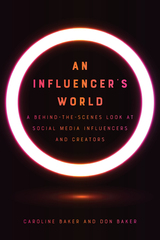 An Influencer's World: A Behind-the-Scenes Look at Social Media Influencers and Creators
Caroline Baker
University of Iowa Press, 2023 What is the influencer lifestyle? How do influencers win their fight for relevance and create a brand that catches fire, while still leading an authentic, healthy life? Influencing is a business built around likes and hate, which can take a huge psychological toll on those who choose to play the game. An Influencer’s World pulls back the curtain and shines a light on the often-misunderstood realities of this dynamic industry. Featuring dozens of interviews with trending influencers, CEOs, leading industry insiders, brands, mental health professionals, and celebrities, this book provides an unconventional look at both the business side of influencing and the personal lives of influencers and creators.
INTERVIEWEES INCLUDE:
Isabella Avila (17.7m on TikTok)
Jacques Bastien (cofounder, SHADE)
Mark Cuban (8.6m on Twitter)
Mary Fitzgerald (1.8m on Instagram)
GloZell Green (4.6m on YouTube)
Tim Karsliyev (1.7m on Instagram)
Kevin Kreider (431k on Instagram)
Max Levine (cofounder, Amp Studios)
Cindy Pham (468k on YouTube)
Michael Schweiger (CEO, Central Entertainment Group)
LaToya Shambo (CEO/founder, Black Girl Digital)
Joshua Suarez (14.4m on TikTok)
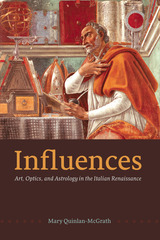 Influences: Art, Optics, and Astrology in the Italian Renaissance
Mary Quinlan-McGrath
University of Chicago Press, 2013 Today few would think of astronomy and astrology as fields related to theology. Fewer still would know that physically absorbing planetary rays was once considered to have medical and psychological effects. But this was the understanding of light radiation held by certain natural philosophers of early modern Europe, and that, argues Mary Quinlan-McGrath, was why educated people of the Renaissance commissioned artworks centered on astrological themes and practices. Influences is the first book to reveal how important Renaissance artworks were designed to be not only beautiful but also—perhaps even primarily—functional. From the fresco cycles at Caprarola, to the Vatican’s Sala dei Pontefici, to the Villa Farnesina, these great works were commissioned to selectively capture and then transmit celestial radiation, influencing the bodies and minds of their audiences. Quinlan-McGrath examines the sophisticated logic behind these theories and practices and, along the way, sheds light on early creation theory; the relationship between astrology and natural theology; and the protochemistry, physics, and mathematics of rays. An original and intellectually stimulating study, Influences adds a new dimension to the understanding of aesthetics among Renaissance patrons and a new meaning to the seductive powers of art.
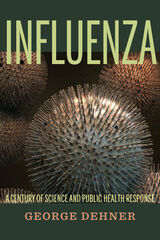 Influenza: A Century of Science and Public Health Response
George Dehner
University of Pittsburgh Press, 2012
In 1976, the outbreak of a new strain of swine flu at the Fort Dix, New Jersey, army base prompted an unprecedented inoculation campaign. Some forty-two million Americans were vaccinated as the National Influenza Immunization Program hastened to prevent a pandemic, while the World Health Organization (WHO) took a wait-and-see approach. Fortunately, the virus did not spread, and only one death occurred. But instead of being lauded, American actions were subsequently denounced as a “fiasco” and instigator of mass panic.
In Influenza, George Dehner examines the wide disparity in national and international responses to influenza pandemics, from the Russian flu of 1889 to the swine flu outbreak in 2009. He chronicles the technological and institutional progress made along the way and shows how these developments can shape an effective future policy.
Early pandemic response relied on methods of quarantine and individual scientific research. In the aftermath of World War II, a consensus for cooperation and shared resources led to the creation of the WHO, under the auspices of the United Nations. Today, the WHO maintains a large and proactive role in responding to influenza outbreaks. International pandemic response, however, is only as strong as its weakest national link—most recently evidenced in the failed early detection of the 2009 swine flu in Mexico and the delayed reporting of the 2002 SARS outbreak in China.
As Dehner’s study contends, the hard lessons of the past highlight the need for a coordinated early warning system with full disclosure, shared technologies, and robust manufacturing capabilities. Until the “national” aspect can be removed from the international equation, responses will be hampered, and a threat to an individual remains a threat to all.
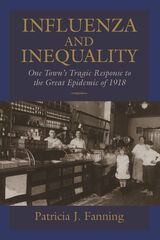 Influenza and Inequality: One Town's Tragic Response to the Great Epidemic of 1918
Patricia J. Fanning
University of Massachusetts Press, 2010 The influenza epidemic of 1918 was one of the worst medical disasters in human history, taking close to thirty million lives worldwide in less than a year, including more than 500,000 in the United States. What made this pandemic even more frightening was the fact that it occurred when death rates for most common infectious diseases were diminishing. Still, an epidemic is not merely a medical crisis; it has sociological, psychological, and political dimensions as well. In Influenza and Inequality, Patricia J. Fanning examines these other dimensions and brings to life this terrible episode of epidemic disease by tracing its path through the town of Norwood, Massachusetts.
By 1918, Norwood was a small, ethnically diverse, industrialized, and stratified community. Ink, printing, and tanning factories were owned by wealthy families who lived privileged lives. These industries attracted immigrant laborers who made their homes in several ethnic neighborhoods and endured prejudice and discrimination at the hands of native residents. When the epidemic struck, the immigrant neighborhoods were most affected; a fact that played a significant role in the town's response—with tragic results.
This close analysis of one town's struggle illuminates how even well-intentioned elite groups may adopt and implement strategies that can exacerbate rather than relieve a medical crisis. It is a cautionary tale that demonstrates how social behavior can be a fundamental predictor of the epidemic curve, a community's response to crisis, and the consequences of those actions.
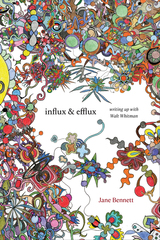 Influx and Efflux: Writing Up with Walt Whitman
Jane Bennett
Duke University Press, 2020 In influx & efflux Jane Bennett pursues a question that was bracketed in her book Vibrant Matter: how to think about human agency in a world teeming with powerful nonhuman influences? “Influx & efflux”—a phrase borrowed from Whitman's "Song of Myself"—refers to everyday movements whereby outside influences enter bodies, infuse and confuse their organization, and then exit, themselves having been transformed into something new. How to describe the human efforts involved in that process? What kinds of “I” and “we” can live well and act effectively in a world of so many other lively materialities? Drawing upon Whitman, Thoreau, Caillois, Whitehead, and other poetic writers, Bennett links a nonanthropocentric model of self to a radically egalitarian pluralism and also to a syntax and style of writing appropriate to the entangled world in which we live. The book tries to enact the uncanny process by which we “write up” influences that pervade, enable, and disrupt us.
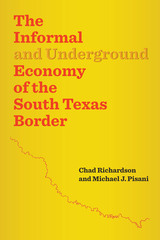 The Informal and Underground Economy of the South Texas Border
By Chad Richardson and Michael J. Pisani
University of Texas Press, 2012 Much has been debated about the presence of undocumented workers along the South Texas border, but these debates often overlook the more complete dimension: the region’s longstanding, undocumented economies as a whole. Borderlands commerce that evades government scrutiny can be categorized into informal economies (the unreported exchange of legal goods and services) or underground economies (criminal economic activities that, obviously, occur without government oversight). Examining long-term study, observation, and participation in the border region, with the assistance of hundreds of locally embedded informants, The Informal and Underground Economy of the South Texas Border presents unique insights into the causes and ramifications of these economic channels. The third volume in UT–Pan American’s Borderlife Project, this eye-opening investigation draws on vivid ethnographic interviews, bolstered by decades of supplemental data, to reveal a culture where divided loyalties, paired with a lack of access to protection under the law and other forms of state-sponsored recourse, have given rise to social spectra that often defy stereotypes. A cornerstone of the authors’ findings is that these economic activities increase when citizens perceive the state’s intervention as illegitimate, whether in the form of fees, taxes, or regulation. From living conditions in the impoverished colonias to President Felipe Calderón’s futile attempts to eradicate police corruption in Mexico, this book is a riveting portrait of benefit versus risk in the wake of a “no-man’s-land” legacy.
 Informal Cities: Histories of Governance and Inequality in Latin Europe, Latin America, and Colonial North Africa
Edited by Charlotte Vorms and Brodwyn Fischer
University of Chicago Press, 2025 An empirically rich reconstruction of how informality became an intrinsic part of urban life across three continents. Over a quarter of the world’s urban population lives in informal settlements. While informality as a concept has been widely debated, we still know very little about the phenomenon’s urban history or how that history has shaped the evolution of world cities. Spotlighting the historical processes that have created and sustained urban informality for more than a century, editors Charlotte Vorms and Brodwyn Fischer and this volume’s contributors reveal informality as an intrinsic feature of urbanity, shaping not only cities across the globe but also deeper processes of state formation, socioeconomic stratification, and political struggle.
The volume brings together case studies spanning more than a hundred years, drawn from Latin America (Brazil, Chile, Venezuela, and Mexico), Northern Africa (Morocco and Algeria), and Latin Europe (France, Spain, and Italy). Together, they show that informality is neither a contemporary crisis nor a predicament unique to the Global South. Topics include the origins of informal settlements and their relationship with law and institutional power; grassroots efforts to legitimize shantytown communities; mass social movements for rights to the city; the role that shantytown removal campaigns played in populist politics, fascism, and colonialism; and the ways that informality perpetuated racial and ethnic inequalities. Informal Cities is an indispensable guide to the complex and fraught terrain of urban informality in its many historical guises.
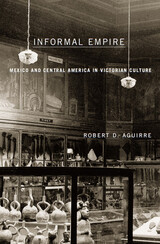 Informal Empire: Mexico And Central America In Victorian Culture
Robert D. Aguirre
University of Minnesota Press, 2004 Behind the ancient artifacts exhibited in our museums lies a secret past—of travel, desire, the quest for knowledge, and even theft. Such is the case with the objects of Mesoamerican culture so avidly collected, cataloged, and displayed by the British in the nineteenth century. Informal Empire recaptures the history of those artifacts from Mexico and Central America that stirred Victorian interest—a history that reveals how such objects and the cultures they embodied were incorporated into British museum collections, panoramas, freak shows, adventure novels, and records of imperial administrators. Robert D. Aguirre draws on a wealth of previously untapped historical information to show how the British colonial experience in Africa and the Near East gave rise to an “informal imperialism” in Mexico and Central America. Aguirre’s work helps us to understand what motivated the British to beg, borrow, buy, and steal from peripheral cultures they did not govern. With its original insights, Informal Empire points to a new way of thinking about British imperialism and, more generally, about the styles and forms of imperialism itself.
 Informatics of Domination
Zach Blas, Melody Jue, and Jennifer Rhee, editors
Duke University Press, 2025 Informatics of Domination is an experimental collection addressing formations of power that manifest through technical systems and white capitalist patriarchy in the twenty-first century. The volume takes its name from a chart in Donna J. Haraway’s canonical 1985 essay “A Manifesto for Cyborgs.” Haraway theorizes the informatics of domination as a feminist, diagrammatic concept for situating power and a world system from which the figure of the cyborg emerges. Informatics of Domination builds on Haraway’s chart as an open structure for thought, inviting fifty scholars, artists, and creative writers to unfold new perspectives. Their writings take on a variety of forms, such as essays on artificial intelligence, disability and protest, and transpacific imaginaries; conversations with an AI trained on Black oral history; a three-dimensional response to Mexico-US border tensions; hand-drawn images on queer autotheory; ecological fictions about gut microbiomes and wet markets; and more. Together, the writings take up the unfinished structure of the chart in order to proliferate critiques of white capitalist patriarchal power with the study of information systems, networks, and computation today. This volume includes an afterword by Haraway.
Contributors. Dalida María Benfield, Zach Blas, Ama Josephine Budge Johnstone, micha cárdenas, Amy Sara Carroll, Shu Lea Cheang, Jian Neo Chen, Heather Dewey-Hagborg, Ranjodh Singh Dhaliwal, Stephanie Dinkins, Ricardo Dominguez, Ashley Ferro-Murray, Matthew Fuller, Jacob Gaboury, Jennifer Gabrys, Alexander R. Galloway, Jennifer Mae Hamilton, Donna J. Haraway, Eva Hayward, Stefan Helmreich, Kathy High, Leon J. Hilton, Ho Rui An, Hi'ilei Julia Kawehipuaakahaopulani Hobart, Tung-Hui Hu, Caroline A. Jones, Melody Jue, Homay King, Larissa Lai, Lawrence Lek, Esther Leslie, Alexis Lothian, Isadora Neves Marques, Radha May (Elisa Giardina-Papa, Nupur Mathur, and Bathsheba Okwenje), Shaka McGlotten, Mahan Moalemi, madison moore, Astrida Neimanis, Bahar Noorizadeh, Luciana Parisi, Thao Phan, Ana Teixeira Pinto, Luiza Prado de O. Martins, Rita Raley, Patricia Reed, Jennifer Rhee, Bassem Saad, Ashkan Sepahvand, Justin Talplacido Shoulder, Lucy Suchman, Ollie Zhang
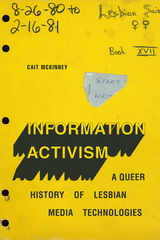 Information Activism: A Queer History of Lesbian Media Technologies
Cait McKinney
Duke University Press, 2020 For decades, lesbian feminists across the United States and Canada have created information to build movements and survive in a world that doesn't want them. In Information Activism Cait McKinney traces how these women developed communication networks, databases, and digital archives that formed the foundation for their work. Often learning on the fly and using everything from index cards to computers, these activists brought people and their visions of justice together to organize, store, and provide access to information. Focusing on the transition from paper to digital-based archival techniques from the 1970s to the present, McKinney shows how media technologies animate the collective and unspectacular labor that sustains social movements, including their antiracist and trans-inclusive endeavors. By bringing sexuality studies to bear on media history, McKinney demonstrates how groups with precarious access to control over information create their own innovative and resourceful techniques for generating and sharing knowledge.
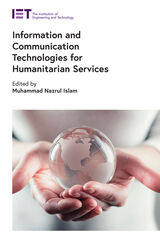 Information and Communication Technologies for Humanitarian Services
Muhammad Nazrul Islam
The Institution of Engineering and Technology, 2020 Humanitarian services seek to promote welfare to save lives, maintain human dignity, alleviate suffering, strengthen preparedness, and provide material and logistical assistance in response to humanitarian crises. They are thus different from development aids that address underlying socioeconomic factors and provides support for the social, economic and political developments of developing nations. Information and Communication Technologies (ICTs) are becoming the backbone technologies for providing quality and efficient services and are playing an increasingly important and sophisticated role in humanitarian-service activities. Many ICT-based solutions exist such as tools to support the work of humanitarian organizations, mobile applications and solutions to provide health services, open source web portals for disaster management systems, and mobile and autonomous devices to provide assistance.
Information and Democratic Processes
Edited by John A. Ferejohn and James H. Kuklinski
University of Illinois Press, 1990 The golden democratic tradition of an informed and involved electorate freely and rationally choosing its public officials seems to be at odds with American political reality. Thus the questions: On what basis do people vote and form opinions? How does the lack of information at the individual level affect system performance? In this collection twenty-six distinguished political scientists discuss, debate, and define the relationship between information and the democracy it supposedly serves. The contributors address both the empirical and normative aspects of governing in the United States, employing psychological, sociological, and economic perspectives.
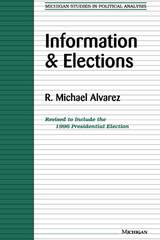 Information and Elections
R. Michael Alvarez
University of Michigan Press, 1998 R. Michael Alvarez examines how voters make their decisions in presidential elections. He begins with the assumption that voters have neither the incentive nor the inclination to be well-informed about politics and presidential candidates. Candidates themselves have incentives to provide ambiguous information about themselves, their records and their issue positions. Yet the author shows that a tremendous amount of information is made available about presidential candidates. And he uncovers clear and striking evidence that people are not likely to vote for candidates about whom they know very little. Alvarez explores how voters learn about candidates through the course of a campaign. He provides a detailed analysis of the media coverage of presidential campaigns and shows that there is a tremendous amount of media coverage of these campaigns, that much of this coverage is about issues and is informative, and that voters learn from this coverage.
The paperback edition of this work has been updated to include information on the 1996 Presidential election.
Information and Elections is a book that will be read by all who are interested in campaigns and electoral behavior in presidential and other elections.
"Thoughtfully conceptualized, painstakingly analyzed, with empirically significant conclusions on presidential election voting behavior, this book is recommended for both upper-division undergraduate and graduate collections." --Choice
R. Michael Alvarez is Associate Professor of Political Science, California Institute of Technology.
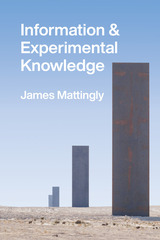 Information and Experimental Knowledge
James Mattingly
University of Chicago Press, 2021 An ambitious new model of experimentation that will reorient our understanding of the key features of experimental practice.
What is experimental knowledge, and how do we get it? While there is general agreement that experiment is a crucial source of scientific knowledge, how experiment generates that knowledge is far more contentious. In this book, philosopher of science James Mattingly explains how experiments function. Specifically, he discusses what it is about experimental practice that transforms observations of what may be very localized, particular, isolated systems into what may be global, general, integrated empirical knowledge. Mattingly argues that the purpose of experimentation is the same as the purpose of any other knowledge-generating enterprise—to change the state of information of the knower. This trivial-seeming point has a non-trivial consequence: to understand a knowledge-generating enterprise, we should follow the flow of information. Therefore, the account of experimental knowledge Mattingly provides is based on understanding how information flows in experiments: what facilitates that flow, what hinders it, and what characteristics allow it to flow from system to system, into the heads of researchers, and finally into our store of scientific knowledge.
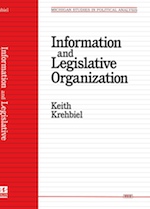 Information and Legislative Organization
Keith Krehbiel
University of Michigan Press, 1992 In this controversial book, Keith Krehbiel investigates and casts doubt upon a view of Congress held by many academics, journalists, and members of the lay public: that Congress is organized primarily to facilitate logrolling or "gains from trade" between legislators. The author puts forward an alternative "informational" theory that, unlike previous formal theories, highlights institutional needs and individual incentives for acquiring policy expertise. Using games with incomplete information, Krehbiel derives a set of unique and testable predictions about the organization of legislatures -- including the composition of committees and the procedures under which legislation is considered. Krehbiel's creative illustrations and nonmathematical presentation of formal theories make this book accessible to a diverse set of readers. The political relevance and testability of games with incomplete information will be appreciated by game theorists and economists, while the book's findings make it essential reading for political scientists who study American politics, political institutions, or democratic legislatures.
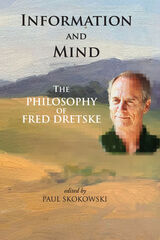 Information and Mind: The Philosophy of Fred Dretske
Edited by Paul Skokowski
CSLI, 2020 Information and Mind explores questions of consciousness that Fred Dretske addressed in his philosophical career. Ranging from one of the earliest problems Dretske analyzed—the nature of seeing an object—to epistemological issues that he began working on mid-career, to matters he focused on in later years, including information, mental representation, and conscious experience, this volume investigates and engages with a spectrum of his prolific works. These papers, written by former colleagues and students from the University of Wisconsin and Stanford University, were inspired by talks given at the Center for the Explanation of Consciousness at Stanford in 2015 to celebrate Dretske’s life and work. In addition to scholarly essays, the authors also recount stories of personal interactions with Dretske that transformed their views or changed their professional trajectory. A bibliography of Dretske’s publications rounds out the volume. This generous volume includes contributions by Fred Adams, John A. Barker, John Perry, Paul Skokowski, and Dennis Stampe.
 Information Brokers: Political Socialization in Latino Immigrant Families
Roberto F. Carlos
University of Chicago Press An insightful rethinking of political socialization within Latino immigrant households. Conventional wisdom tells us that children are passive recipients of political lessons from their parents, with caregivers being the ones who mold the developing behavior and beliefs of the children under their roof. Roberto F. Carlos challenges this preconception by revealing how Latino children, especially those with immigrant parents, often become key sources of political information and guidance in their families. As migrant parents navigate unfamiliar institutions and customs in the United States, they often turn to their children to broker information about everything from daily life to civic engagement. These roles not only place unique responsibilities on children but also create new pathways for them to shape the political behavior of their parents. Moreover, by taking on these roles, children learn the skills that can make them effective advocates later in life, even as they face resource disadvantages that normally correlate with reduced political participation and sense of political efficacy. Drawing on six original surveys, multiple experiments, and in-depth interviews, including the accounts of youth helping protect their families from deportation, InformationBrokers shows how these dynamics influence both immigrant parents and their children in politically consequential ways. With the Latino population now over 64 million, Information Brokers offers vital insight into the political incorporation of America’s largest ethnic group.
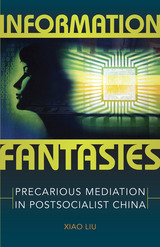 Information Fantasies: Precarious Mediation in Postsocialist China
Xiao Liu
University of Minnesota Press, 2019 Winner of the Science Fiction Research Association Book Award
A groundbreaking, alternate history of information technology and information discourses
Although the scale of the information economy and the impact of digital media on social life in China today could pale that of any other country, the story of their emergence in the post-Mao sociopolitical environment remains untold. Information Fantasies offers a revisionist account of the emergence of the “information society,” arguing that it was not determined by the technology of digitization alone but developed out of a set of techno-cultural imaginations and practices that arrived alongside postsocialism. Anticipating discussions on information surveillance, data collection, and precarious labor conditions today, Xiao Liu goes far beyond the current scholarship on internet and digital culture in China, questioning the limits of current new-media theory and history, while also salvaging postsocialism from the persistent Cold War structure of knowledge production. Ranging over forgotten science fiction, unjustly neglected films, corporeal practices such as qigong, scientific journals, advertising, and cybernetic theories, Information Fantasies constructs an alternate genealogy of digital and information imaginaries—one that will change how we look at the development of the postsocialist world and the emergence of digital technologies.
Information for Foreigners: Three Plays
Griselda Gambaro
Northwestern University Press, 1992 One of Latin America's most important and prolific writers, Griselda Gambaro has focused on the dynamics of repression, complicity, and violence--specifically, the terror of violent regimes and their devastating effects on the moral framework of society. Information for Foreigners is a drama of disappearance, an experimental work dealing with the theme of random and meaningless punishment in which the audience is led through darkened passageways to a series of nightmarish tableaux. The collection also includes The Walls and Antigona Furiosa.
 Information in War: Military Innovation, Battle Networks, and the Future of Artificial Intelligence
Benjamin M. Jensen, Christopher Whyte, and Scott Cuomo
Georgetown University Press, 2022 An in-depth assessment of innovations in military information technology informs hypothetical outcomes for artificial intelligence adaptations In the coming decades, artificial intelligence (AI) could revolutionize the way humans wage war. The military organizations that best innovate and adapt to this AI revolution will likely gain significant advantages over their rivals. To this end, great powers such as the United States, China, and Russia are already investing in novel sensing, reasoning, and learning technologies that will alter how militaries plan and fight. The resulting transformation could fundamentally change the character of war. In Information in War, Benjamin Jensen, Christopher Whyte, and Scott Cuomo provide a deeper understanding of the AI revolution by exploring the relationship between information, organizational dynamics, and military power. The authors analyze how militaries adjust to new information communication technology historically to identify opportunities, risks, and obstacles that will almost certainly confront modern defense organizations as they pursue AI pathways to the future. Information in War builds on these historical cases to frame four alternative future scenarios exploring what the AI revolution could look like in the US military by 2040.
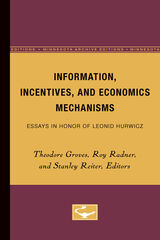 Information, Incentives, and Economics Mechanisms: Essays in Honor of Leonid Hurwicz
Theodore Groves
University of Minnesota Press, 1987
Information, Incentives, and Economics Mechanisms was first published in 1987.In 1960, economist Leonid Hurwicz formulated a theoretical model that initiated a field of research on the design and analysis of economic mechanisms (the institutional rules and structures by which economic activity is coordinated). By treating mechanisms as a “variable,” this research provided a methodology for their comparison. The inefficiency of mechanisms arises from 1) the dispersion of information among agents, and 2) agents’ incentives to seek private advantage from this dispersion. Exploration of these limits to efficiency was pioneered by Hurwicz in 1972, and has become a major area of active research. In part, this research enables economic theory to be a more effective instrument for the study of how a society can and should organize its economic activity.The fourteen new papers in this volume -- by a group of distinguished economists, all former students, colleagues, and collaborators of Hurwicz -- address major themes in the study of information and incentives for implementing desired economic allocations. Two comprehensive survey essays provide introductions to the topics of incentive in decentralized organizations generally and, more specifically, in classical models of private goods and public goods economies. The following sections deal with informational aspects of mechanism theory, information and the stability of general resource allocation mechanisms, market mechanisms, and nonmarket and general mechanisms.In addition to the editors, the contributors are: Masahiko Aoki, Kenneth J. Arrow, Xavier Calsamiglia, Jerry R. Green, James S. Jordan, Jean-Jacques Laffont, John Ledyard, Thomas Marschak, Eric Maskin, Andreu Mas-Coleli, Kenneth R. Mount, Andrew Postlewaite, Jean-Charles Rochet, John Roberts, David Schmeidler, and William Thomson.
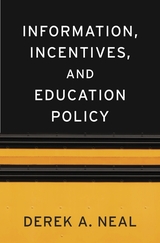 Information, Incentives, and Education Policy
Derek A. Neal
Harvard University Press, 2018 How do we ensure that waste and inefficiency do not undermine the mission of publicly funded schools? Derek Neal writes that economists must analyze education policy in the same way they analyze other procurement problems. Insights from research on incentives and contracts in the private sector point to new approaches that could induce publicly funded educators to provide excellent education, even though taxpayers and parents cannot monitor what happens in the classroom.
Information, Incentives, and Education Policy introduces readers to what economists know—and do not know—about the logjams created by misinformation and disincentives in education. Examining a range of policy agendas, from assessment-based accountability and centralized school assignments to charter schools and voucher systems, Neal demonstrates where these programs have been successful, where they have failed, and why. The details clearly matter: there is no quick-and-easy fix for education policy. By combining elements from various approaches, economists can help policy makers design optimal reforms.
Information, Incentives, and Education Policy is organized to show readers how standard tools from economics research on information and incentives speak directly to some of the most crucial issues in education today. In addition to providing an overview of the pluses and minuses of particular programs, each chapter includes a series of exercises that allow students of economics to work through the mathematics for themselves or with an instructor’s assistance. For those who wish to master the models and tools that economists of education should use in their work, there is no better resource available.
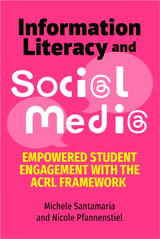 Information Literacy and Social Media: Empowered Student Engagement with the ACRL Framework
Michele Santamaria
Association of College & Research Libraries, 2024 Teaching our students how to become flexible and accurate evaluators of information requires teaching them adaptable processes and not static heuristics. Our conventional information literacy teaching and learning tools are simply not up to tackling the life-long, real-world challenges and transferable applications required by today’s evolving information landscape.
Information Literacy and Social Media: Empowered Student Engagement with the ACRL Framework provides librarians and non-librarian practitioners with ways to teach and learn with social media. It addresses how to broadly conceptualize information literacy teaching with social media and allay any student reluctance to using social media for academic purposes. It proposes how to map some of the ACRL threshold concepts onto specific social media platforms, including Facebook, X, Instagram, and TikTok, while providing general guidance for if and when those platforms change. There are eight concrete, cross-disciplinary lesson plans that factor in design, assessment, and student engagement. Finally, the book considers how up-and-coming platforms might empower students to be critical content creators and encourage librarians and faculty to support and create new information literacy initiatives on their campuses.
Information Literacy and Social Media demonstrates how to engage students with and through social media platforms and teach them to embrace their role as information creators through engagement with the ACRL Framework for Information Literacy for Higher Education. This is the step that they must take to truly be metaliterate in the creative and ethical ways that make information literacy an essential college competency.
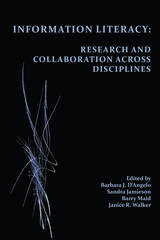 Information Literacy: Research and Collaboration across Disciplines
Barbara d'Angelo
University Press of Colorado, 2017 This collection brings together scholarship and pedagogy from multiple perspectives and disciplines, offering nuanced and complex perspectives on Information Literacy in the second decade of the twenty-first century. Taking as a starting point the concerns that prompted the Association of Research Libraries (ACRL) to review the Information Literacy Standards for Higher Education and develop the Framework for Information Literacy for Higher Education (2015), the chapters in this collection consider six frameworks that place students in the role of both consumer and producer of information within today's collaborative information environments. Contributors respond directly or indirectly to the work of the ACRL, providing a bridge between past/current knowledge and the future and advancing the notion that faculty, librarians, administrators, and external stakeholders share responsibility and accountability for the teaching, learning, and research of Information Literacy.
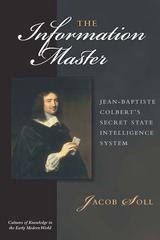 The Information Master: Jean-Baptiste Colbert's Secret State Intelligence System
Jacob Soll
University of Michigan Press, 2011 "Colbert has long been celebrated as Louis XIV's minister of finance, trade, and industry. More recently, he has been viewed as his minister of culture and propaganda. In this lively and persuasive book, Jake Soll has given us a third Colbert, the information manager."
---Peter Burke, University of Cambridge "Jacob Soll gives us a road map drawn from the French state under Colbert. With a stunning attention to detail Colbert used knowledge in the service of enhancing
royal power. Jacob Soll's scholarship is impeccable and his story long
overdue and compelling."
---Margaret Jacob, University of California, Los Angeles "Nowadays we all know that information is the key to power, and that the masters of information rule the world. Jacob Soll teaches us that Jean-Baptiste Colbert had grasped this principle three and a half centuries ago, and used it to construct a new kind of state. This imaginative, erudite, and powerfully written book re-creates the history of libraries and archives in early modern Europe, and ties them in a novel and convincing way to the new statecraft of Europe's absolute monarchs."
---Anthony Grafton, Princeton University "Brilliantly researched, superbly told, and timely, Soll's story is crucial for the history of the modern state."
---Keith Baker, Stanford University When Louis XIV asked his minister Jean-Baptiste Colbert---the man who was to oversee the building of Versailles and the Royal Academy of Sciences, as well as the navy, the Paris police force, and French industry---to build a large-scale administrative government, Colbert created an unprecedented information system for political power. In The Information Master, Jacob Soll shows how the legacy of Colbert's encyclopedic tradition lies at the very center of the rise of the modern state and was a precursor to industrial intelligence and Internet search engines. Soll's innovative look at Colbert's rise to power argues that his practice of collecting knowledge originated from techniques of church scholarship and from Renaissance Italy, where merchants recognized the power to be gained from merging scholarship, finance, and library science. With his connection of interdisciplinary approaches---regarding accounting, state administration, archives, libraries, merchant techniques, ecclesiastical culture, policing, and humanist pedagogy---Soll has written an innovative book that will redefine not only the history of the reign of Louis XIV and information science but also the study of political and economic history. Jacob Soll is Associate Professor of History at Rutgers University and the author of Publishing The Prince: History, Reading, and the Birth of Political Criticism (University of Michigan Press, 2005), and winner of the 2005 Jacques Barzun Prize from the American Philosophical Society and a 2009 Guggenheim Fellowship. Soll edited a special issue of Journal of the History of Ideas titled "The Uses of Historical Evidence in Early Modern Europe"; has cofounded the online journal Republics of Letters; and is editor, along with Anthony Grafton and Ann Blair, of the series Cultures of Knowledge in the Early Modern World. Jacket illustration: Jean Baptiste Colbert (1619–1683), Philippe de Champaigne, 1655, The Metropolitan Museum of Art, Gift of the Wildenstein Foundation, Inc., 1951 (51.34). Photograph © 2003 The Metropolitan Museum of Art.
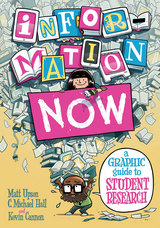 Information Now: A Graphic Guide to Student Research
Matt Upson, C. Michael Hall, and Kevin Cannon
University of Chicago Press, 2015 Every day researchers face an onslaught of irrelevant, inaccurate, and sometimes insidious information. While new technologies provide powerful tools for accessing knowledge, not all information is created equal. Valuable information may be tucked away on a shelf, buried on the hundredth page of search results, or hidden behind digital barriers. With so many obstacles to effective research, it is vital that higher education students master the art of inquiry.
Information Now is an innovative approach to information literacy that will reinvent the way college students think about research. Instead of the typical textbook format, it uses illustrations, humor, and reflective exercises to teach students how to become savvy researchers. Students will learn how to evaluate information, to incorporate it into their existing knowledge base, to wield it effectively, and to understand the ethical issues surrounding its use. Written by two library professionals, it incorporates concepts and skills drawn from the Association of College and Research Libraries’ Information Literacy Competency Standards for Higher Education and their Framework for Information Literacy for Higher Education. Thoroughly researched and highly engaging, Information Now offers the tools that students need to become powerful consumers and creators of information.
Whether used by a high school student tackling a big paper, an undergrad facing the newness of a university library, or a writer wanting to go beyond Google, Information Now is a powerful tool for any researcher’s arsenal.
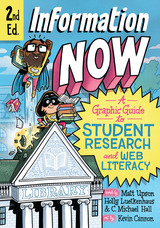 Information Now, Second Edition: A Graphic Guide to Student Research and Web Literacy
Matt Upson, Holly Luetkenhaus, C. Michael Hall, and Kevin Cannon
University of Chicago Press, 2021 Today’s information environments are complex, and learning how to find relevant and reliable information online, as well as how to fact-check and evaluate that information, is essential. Enter Information Now, a graphic guide that uses humor and sequential art to teach students about information, research, and the web.
This second edition of the popular guide incorporates critical analysis of information systems, asking students to think about the biases and problems in how databases and search engines are designed and used. It also addresses how different populations of people are disproportionately affected by the algorithmic biases built into information systems. And it includes revised critical thinking exercises in every chapter.
Written and revised by library professionals, Information Now is a fun and insightful tool for high school and college students, writers, and anyone wanting to improve their research skills.
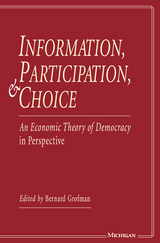 Information, Participation, and Choice: An Economic Theory of Democracy in Perspective
Bernard Grofman, Editor
University of Michigan Press, 1995 Anthony Downs's An Economic Theory of Democracy is one of the handful of books that reshaped political science in the post-World War II period. Information, Participation, and Choice traces the influence of Downs's ideas on subsequent research on voters, candidates, and parties in the United States and elsewhere.
Since their publication in 1957, Downs's seminal ideas -- tweedledum and tweedledee politics and the "rationality" of political ignorance and nonparticipation on the part of voters--have shaped an ongoing debate about how politics actually work. The debate pits a public-choice model inspired by microeconomic precepts against a traditional textbook model that presumes a responsible, informed, and civic-minded citizenry and a set of elected officials motivated by concern for the public interest and policy convictions.
The essays comprising Information, Participation, and Choice, by leading political scientists and economists, provide both a summary of Downs's key theoretical insights and an empirical examination of how well models inspired by Downs accurately describe U.S. political competition for Congress and the presidency.
Bernard Grofman is Professor of Political Science and Social Psychology, University of California, Irvine.
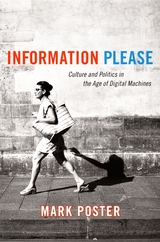 Information Please: Culture and Politics in the Age of Digital Machines
Mark Poster
Duke University Press, 2006 Information Please advances the ongoing critical project of the media scholar Mark Poster: theorizing the social and cultural effects of electronically mediated information. In this book Poster conceptualizes a new relation of humans to information machines, a relation that avoids privileging either the human or the machine but instead focuses on the structures of their interactions. Synthesizing a broad range of critical theory, he explores how texts, images, and sounds are made different when they are mediated by information machines, how this difference affects individuals as well as social and political formations, and how it creates opportunities for progressive change. Poster’s critique develops through a series of lively studies. Analyzing the appearance of Sesame Street’s Bert next to Osama Bin Laden in a New York Times news photo, he examines the political repercussions of this Internet “hoax” as well as the unlimited opportunities that Internet technology presents for the appropriation and alteration of information. He considers the implications of open-source licensing agreements, online personas, the sudden rise of and interest in identity theft, peer-to-peer file sharing, and more. Focusing explicitly on theory, he reflects on the limitations of critical concepts developed before the emergence of new media, particularly globally networked digital communications, and he argues that, contrary to the assertions of Michael Hardt and Antonio Negri, new media do not necessarily reproduce neoimperialisms. Urging a rethinking of assumptions ingrained during the dominance of broadcast media, Poster charts new directions for work on politics and digital culture.
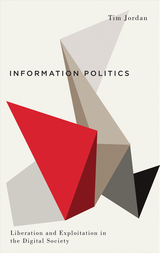 Information Politics: Liberation and Exploitation in the Digital Society
Tim Jordan
Pluto Press, 2015 Conflict over information has become a central part of twenty-first century politics and culture. Currents of liberation and exploitation course through the debates about Edward Snowden and surveillance, Anonymous, the Arab Spring, search engines, and social media. In Information Politics, Tim Jordan confronts contemporary panic about whether we are being controlled by digital systems, such as social networks, iPhones, and Google. He approaches these issues in relation to the information politics that have emerged with the rise of mass digital cultures and the internet. Within our modern world, he argues for possibilities of rebellion and liberation interwoven among social and political conflicts including gender, class, and ecology.
The first of Pluto Press’s new Digital Barricades series, focusing on ground-breaking critical explorations of resistance within the digital world, Information Politics explores the exploitations both facilitated by, and contested through, increases in information flows; the embedding of information technologies in daily life; and the intersection of network and control protocols. Anyone hoping to get to grips with the rapidly changing terrain of digital culture and conflict should start here.
Information Security: Foundations, technologies and applications
Ali Ismail Awad
The Institution of Engineering and Technology, 2018 The rapid advancements in telecommunications, computing hardware and software, and data encryption, and the widespread use of electronic data processing and electronic business conducted through the Internet have led to a strong increase in information security threats. The latest advances in information security have increased practical deployments and scalability across a wide range of applications to better secure and protect our information systems and the information stored, processed and transmitted. This book outlines key emerging trends in information security from the foundations and technologies in biometrics, cybersecurity, and big data security to applications in hardware and embedded systems security, computer forensics, the Internet of Things security, and network security.
Information Sharing: Reference and Presupposition in Language Generation and Interpretation
Edited by Kees van Deemter and Rodger Kibble
CSLI, 2002 This book introduces the concept of information sharing as an area of cognitive science, defining it as the process by which speakers depend on "given" information to convey "new" information—an idea crucial to language engineering. Where previous work in information sharing was often fragmented between different disciplines, this volume brings together theoretical and applied work, and joins computational contributions with papers based on analyses of language corpora and on psycholinguistic experimentation.
Information Society and Media Development in Modern Mongolia
Undrah Baasanjav
Amsterdam University Press, 2025 This book provides an account of Mongolian information society from the perspective of critical media studies. The converged media sphere in modern Mongolia mirrors and shapes political communication, economic outlook, institutional norms, and Mongolian identity. When placing Mongolia on the global information society map, the arguments in the book juxtapose information society tenets and structural constraints like the small market, communist past, and mining-dependent economy. Today, people in Mongolia take advantage of the mobility, speed, and spatiality of the internet, as the Mongolians of old once saddled their horses and galloped across the grassy steps of Eurasia.
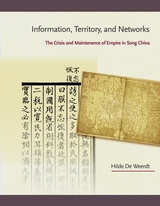 Information, Territory, and Networks: The Crisis and Maintenance of Empire in Song China
Hilde De Weerdt
Harvard University Press The occupation of the northern half of the Chinese territories in the 1120s brought about a transformation in political communication in the south that had lasting implications for imperial Chinese history. By the late eleventh century, the Song court no longer dominated the production of information about itself and its territories. Song literati gradually consolidated their position as producers, users, and discussants of court gazettes, official records, archival compilations, dynastic histories, military geographies, and maps. This development altered the relationship between court and literati in political communication for the remainder of the imperial period. Based on a close reading of reader responses to official records and derivatives and on a mapping of literati networks, the author further proposes that the twelfth-century geopolitical crisis resulted in a lasting literati preference for imperial restoration and unified rule.
Hilde De Weerdt makes an important intervention in cultural and intellectual history by examining censorship and publicity together. In addition, she reorients the debate about the social transformation and local turn of imperial Chinese elites by treating the formation of localist strategies and empire-focused political identities as parallel rather than opposite trends.
 Information: The New Language of Science
Hans Christian von Baeyer
Harvard University Press, 2004 Confronting us at every turn, flowing from every imaginable source, information defines our era--and yet what we don't know about it could--and does--fill a book. In this indispensable volume, a primer for the information age, Hans Christian von Baeyer presents a clear description of what information is, how concepts of its measurement, meaning, and transmission evolved, and what its ever-expanding presence portends for the future.
Information is poised to replace matter as the primary stuff of the universe, von Baeyer suggests; it will provide a new basic framework for describing and predicting reality in the twenty-first century. Despite its revolutionary premise, von Baeyer's book is written simply in a straightforward fashion, offering a wonderfully accessible introduction to classical and quantum information. Enlivened with anecdotes from the lives of philosophers, mathematicians, and scientists who have contributed significantly to the field, Information conducts readers from questions of subjectivity inherent in classical information to the blurring of distinctions between computers and what they measure or store in our quantum age. A great advance in our efforts to define and describe the nature of information, the book also marks an important step forward in our ability to exploit information--and, ultimately, to transform the nature of our relationship with the physical universe.
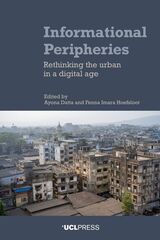 Informational Peripheries: Rethinking the Urban in a Digital Age
Edited by Ayona Datta and Fenna Imara Hoefsloot
University College London, 2025 An examination of how urban peripheries are being redefined in the digital era.
Moving beyond current scholarship in urban and regional studies, this volume presents a case for “informational peripheries” as an analytical lens to understand the uneven, fragmented, and disconnected geographies of urban peripheries in the Global South. While this concept is parallel to and overlaps with the urban periphery, the circulation—or restriction—of information has taken on additional significance with the coming of a digital age. The periphery is no longer confined to the slums or suburbia at a city's edge; it now also encompasses uneven and fragmented digital infrastructures.
Providing empirical and theoretical contributions from cities in the Global South, this book advances scholarship in Southern urbanism, smart cities, and peripheral urbanization, conceptualizing the diverse ways in which informational peripheries are resisted, adapted, complied with, and lived in.
Informed Consent: Patient Autonomy and Clinician Beneficence within Health Care, Second Edition
Stephen Wear
Georgetown University Press, 1998 Wear develops an efficient and flexible model of informed consent that accommodates both clinical realities and legal and ethical imperatives. In this second edition, he has expanded his examination of the larger process within which informed consent takes place and his discussion of the clinician's need for a wide range of discretion.
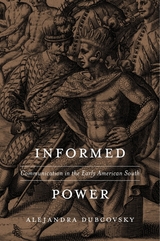 Informed Power: Communication in the Early American South
Alejandra Dubcovsky
Harvard University Press, 2016 Informed Power maps the intricate, intersecting channels of information exchange in the early American South, exploring how people in the colonial world came into possession of vital knowledge in a region that lacked a regular mail system or a printing press until the 1730s.
Challenging the notion of early colonial America as an uninformed backwater, Alejandra Dubcovsky uncovers the ingenious ways its inhabitants acquired timely news through largely oral networks. Information circulated through the region via spies, scouts, traders, missionaries, and other ad hoc couriers—and by encounters of sheer chance with hunting parties, shipwrecked sailors, captured soldiers, or fugitive slaves. For many, content was often inseparable from the paths taken and the alliances involved in acquiring it. The different and innovative ways that Indians, Africans, and Europeans struggled to make sense of their world created communication networks that linked together peoples who otherwise shared no consensus of the physical and political boundaries shaping their lives.
Exchanging information was not simply about having the most up-to-date news or the quickest messenger. It was a way of establishing and maintaining relationships, of articulating values and enforcing priorities—a process inextricably tied to the region’s social and geopolitical realities. At the heart of Dubcovsky’s study are important lessons about the nexus of information and power in the early American South.
Informing a Nation: The Newspaper Presidency of Thomas Jefferson
Mel Laracey
University of Michigan Press, 2021 During his presidency, Thomas Jefferson both sponsored and wrote for his own newspaper, the National Intelligencer and Washington Advertiser. The newspaper spoke on behalf of his policies and those of his Republican, anti-federalist party, the Democratic-Republicans, the precursor to today’s Democrats. Author Mel Laracey focuses on the newspaper’s message during Jefferson’s first term, showing how the third president used media to promote his administration and its goals against their political rivals, the Federalists. Informing a Nation shows how Jefferson and his allies dealt with political challenges, reveals hitherto unexamined aspects of the early presidency, and raises broad questions of the relationship between the presidency and media today.
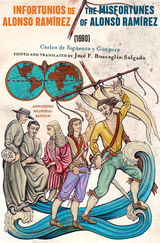 Infortunios de Alonso Ramirez / The Misfortunes of Alonso Ramirez (1690): Annotated Bilingual Edition
Buscaglia-Salgado, José F
Rutgers University Press, 2018 In 2009, 319 years after its publication, and following over a century of copious scholarly speculation about the work, José F. Buscaglia is the first scholar to furnish direct and irrefutable proof that the story contained in the Infortunios/Misfortunes is based on the life and times of a man certifiably named Alonso Ramírez, who was shipwrecked on Herradura Point in the Coast of Yucatán on Sunday September 18, 1689. This first bilingual edition of the Infortunios/Misfortunes reports the findings of almost two decades of sustained research in pursuit, on land and by sea, of a most elusive historical character who was, as we now can attest with all degree of certainty, the first American known to have circumnavigated the globe. Captured by pirates, shipwrecked, and eventually rescued and sent on his way, this is one man’s story of his unanticipated voyage around the Early Modern world. With transcription, translation, notes, maps, images, and critical essay by Jose F. Buscaglia-Salgado, this Rutgers edition is the most complete and authoritative study on a work that grants us privileged access to the intricacies of early American subjectivity.
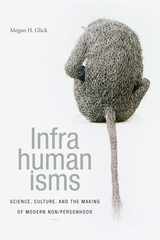 Infrahumanisms: Science, Culture, and the Making of Modern Non/personhood
Megan H. Glick
Duke University Press, 2018 In Infrahumanisms Megan H. Glick considers how conversations surrounding nonhuman life have impacted a broad range of attitudes toward forms of human difference such as race, sexuality, and health. She examines the history of human and nonhuman subjectivity as told through twentieth-century scientific and cultural discourses that include pediatrics, primatology, eugenics, exobiology, and obesity research. Outlining how the category of the human is continuously redefined in relation to the infrahuman—a liminal position of speciation existing between the human and the nonhuman—Glick reads a number of phenomena, from early twentieth-century efforts to define children and higher order primates as liminally human and the postwar cultural fascination with extraterrestrial life to anxieties over AIDS, SARS, and other cross-species diseases. In these cases the efforts to define a universal humanity create the means with which to reinforce notions of human difference and maintain human-nonhuman hierarchies. In foregrounding how evolving definitions of the human reflect shifting attitudes about social inequality, Glick shows how the consideration of nonhuman subjectivities demands a rethinking of long-held truths about biological meaning and difference.
 Infrastructural Attachments: Austerity, Sovereignty, and Expertise in Kenya
Emma Park
Duke University Press, 2024 Set against critiques of neoliberal capitalism in the present, Infrastructural Attachments argues that the technopolitics of austerity have been the organizing logic of statecraft in Kenya since the late nineteenth century, calling into question the novelty of austerity as a mode of governance and a lived experience. Using infrastructures as a lens to explore state formation over the long twentieth century—roads in the early colonial period, radio broadcasting from the interwar through the postwar periods, and mobile phones and digital financial services in the present—historian Emma Park reveals that as the state drew on private capital to make up for limited budgets, it inaugurated a peculiar political-economic form: the corporate-state. For more than a century—in pursuit of minimizing costs and maximizing profits—the corporate-state crucially relied on the exploitation and expropriation of its subject-citizens. By foregrounding these workers, Park interrogates how Kenyans’ knowledge and expertise has been rescaled and subsumed, quietly underwriting the development of infrastructural expertise, the circuits of finance upon which (post)colonial infrastructural expansion has been premised, and the forms of profit-making it has enabled.
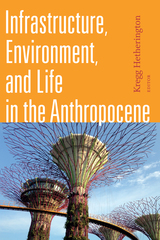 Infrastructure, Environment, and Life in the Anthropocene
Kregg Hetherington, editor
Duke University Press, 2019 Infrastructure, Environment, and Life in the Anthropocene explores life in the age of climate change through a series of infrastructural puzzles—sites at which it has become impossible to disentangle the natural from the built environment. With topics ranging from breakwaters built of oysters, underground rivers made by leaky pipes, and architecture gone weedy to neighborhoods partially submerged by rising tides, the contributors explore situations that destabilize the concepts we once relied on to address environmental challenges. They take up the challenge that the Anthropocene poses both to life on the planet and to our social-scientific understanding of it by showing how past conceptions of environment and progress have become unmoored and what this means for how we imagine the future.
Contributors. Nikhil Anand, Andrea Ballestero, Bruce Braun, Ashley Carse, Gastón R. Gordillo, Kregg Hetherington, Casper Bruun Jensen, Joseph Masco, Shaylih Muehlmann, Natasha Myers, Stephanie Wakefield, Austin Zeiderman
 Infrastructure in Dystopian and Post-apocalyptic Film, 1968–2021
Christian Long
Intellect Books, 2024 Lessons from society’s frameworks at the end of the world.
Dystopian and post-apocalyptic movies from 1968 to 2021 usually conclude with optimism, giving the audience a window into what is possible in the face of social dysfunction. The infrastructure that peeks through at the edges of the frame surfaces some of the concrete ways in which dystopian and post-apocalyptic survivors have made do with their damaged and destroyed worlds. In this book, Christian B. Long argues that if the happy endings so common to mass-audience films do not provide an all-encompassing vision of a better world, the presence of infrastructure, whether old or retrofitted or new, offers a starting point for the continued work of building toward the future.
Film imaginings of energy, transportation, water, waste, and their combination in the food system reveal what might be essential infrastructure on which to build the new post-dystopian and post-apocalyptic communities. We can look to dystopian and post-apocalyptic movies for a sense of where we might begin.
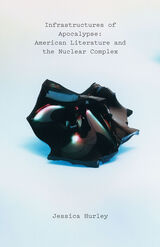 Infrastructures of Apocalypse: American Literature and the Nuclear Complex
Jessica Hurley
University of Minnesota Press, 2020 A new approach to the vast nuclear infrastructure and the apocalypses it produces, focusing on Black, queer, Indigenous, and Asian American literatures
Since 1945, America has spent more resources on nuclear technology than any other national project. Although it requires a massive infrastructure that touches society on myriad levels, nuclear technology has typically been discussed in a limited, top-down fashion that clusters around powerful men. In Infrastructures of Apocalypse, Jessica Hurley turns this conventional wisdom on its head, offering a new approach that focuses on neglected authors and Black, queer, Indigenous, and Asian American perspectives.
Exchanging the usual white, male “nuclear canon” for authors that include James Baldwin, Leslie Marmon Silko, and Ruth Ozeki, Infrastructures of Apocalypse delivers a fresh literary history of post-1945 America that focuses on apocalypse from below. Here Hurley critiques the racialized urban spaces of civil defense and reads nuclear waste as a colonial weapon. Uniting these diverse lines of inquiry is Hurley’s belief that apocalyptic thinking is not the opposite of engagement but rather a productive way of imagining radically new forms of engagement.
Infrastructures of Apocalypse offers futurelessness as a place from which we can construct a livable world. It fills a blind spot in scholarship on American literature of the nuclear age, while also offering provocative, surprising new readings of such well-known works as Atlas Shrugged, Infinite Jest, and Angels in America. Infrastructures of Apocalypse is a revelation for readers interested in nuclear issues, decolonial literature, speculative fiction, and American studies.
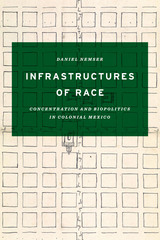 Infrastructures of Race: Concentration and Biopolitics in Colonial Mexico
By Daniel Nemser
University of Texas Press, 2017 Winner, Humanities Book Prize, Mexico Section of the Latin American Studies Association, 2018 Many scholars believe that the modern concentration camp was born during the Cuban war for independence when Spanish authorities ordered civilians living in rural areas to report to the nearest city with a garrison of Spanish troops. But the practice of spatial concentration—gathering people and things in specific ways, at specific places, and for specific purposes—has a history in Latin America that reaches back to the conquest. In this paradigm-setting book, Daniel Nemser argues that concentration projects, often tied to urbanization, laid an enduring, material groundwork, or infrastructure, for the emergence and consolidation of new forms of racial identity and theories of race. Infrastructures of Race traces the use of concentration as a technique for colonial governance by examining four case studies from Mexico under Spanish rule: centralized towns, disciplinary institutions, segregated neighborhoods, and general collections. Nemser shows how the colonial state used concentration in its attempts to build a new spatial and social order, and he explains why the technique flourished in the colonies. Although the designs for concentration were sometimes contested and short-lived, Nemser demonstrates that they provided a material foundation for ongoing processes of racialization. This finding, which challenges conventional histories of race and mestizaje (racial mixing), promises to deepen our understanding of the way race emerges from spatial politics and techniques of population management.
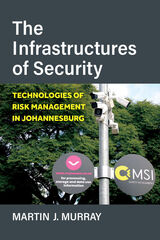 The Infrastructures of Security: Technologies of Risk Management in Johannesburg
Martin J. Murray
University of Michigan Press, 2022 Much of the South African government’s response to crime—especially in Johannesburg—has been to rely increasingly on technology. This includes the widespread use of video cameras, Artificial Intelligence, machine-learning, and automated systems, effectively replacing human watchers with machine watchers. The aggregate effect of such steps is to determine who is, and isn’t, allowed to be in public spaces—essentially another way to continue segregation.
In The Infrastructures of Security, author Martin J. Murray concentrates on not only the turn toward technological solutions to managing the risk of crime through digital (and software-based) surveillance and automated information systems, but also the introduction of somewhat bizarre and fly-by-night experimental “answers” to perceived risk and danger. Digitalized surveillance is significant for two reasons: first, it enables monitoring to take place across wide "geographical distances with little time delay"; and second, it allows for the active sorting, identification, and "tracking of bodies, behaviors, and characteristics of subject populations on a continuous, real-time basis." These new software-based surveillance technologies represent monitoring, tracking, and information gathering without walls, towers, or guards.
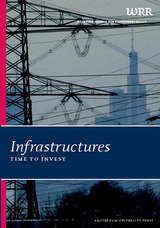 Infrastructures: Time to Invest
Netherlands Scientific Council for Government Policy
Amsterdam University Press, 2009 All sectors of the Dutch infrastructures have undergone a degree of commercialisation, liberalisation or privatisation over the last ten to twenty years. Where in the past the infrastructure landscape was dominated by public monopolies, the ownership and management of infrastructures is today shared by several public and private sector players. The original goals of this 'regime change' have in many cases been achieved: greater efficiency, a greater focus on the customer and more choice for consumers.
The question is whether this emphasis on current consumer interests allows enough scope to achieve long-term objectives which affect the whole of our society: innovation, long-term availability and sustainability of infrastructures. This is of crucial importance for economic and social development, which is coming under increasing pressure due to the combined impact of the exhaustion of natural resources and climate change.
The transition to a sustainable future demands substantial investment in infrastructures, which cannot be taken for granted in the present situation. The WRR has investigated how these investments could be safeguarded in the long term, whilst retaining the efficiency of the infrastructures.
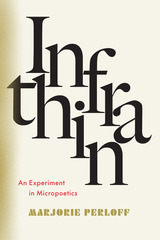 Infrathin: An Experiment in Micropoetics
Marjorie Perloff
University of Chicago Press, 2021 Esteemed literary critic Marjorie Perloff reconsiders the nature of the poetic, examining its visual, grammatical, and sound components.
The “infrathin” was Marcel Duchamp’s playful name for the most minute shade of difference: that between the report of a gunshot and the appearance of the bullet hole, or between two objects in a series made from the same mold. “Eat” is not the same thing as “ate.” The poetic, Marjorie Perloff suggests, can best be understood as the language of infrathin. For in poetry, whether in verse or prose, words and phrases that are seemingly unrelated in ordinary discourse are realigned by means of sound, visual layout, etymology, grammar, and construction so as to “make it new.”
In her revisionist “micropoetics,” Perloff draws primarily on major modernist poets from Stein and Yeats to Beckett, suggesting that the usual emphasis on what this or that poem is “about,” does not do justice to its infrathin possibilities. From Goethe’s eight-line “Wanderer’s Night Song” to Eliot’s Four Quartets, to the minimalist lyric of Rae Armantrout, Infrathin is designed to challenge our current habits of reading and to answer the central question: what is it that makes poetry poetry?
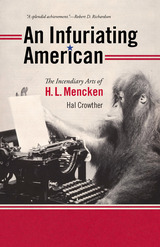 An Infuriating American: The Incendiary Arts of H. L. Mencken
Hal Crowther
University of Iowa Press, 2014 As American journalism shape-shifts into multimedia pandemonium and seems to diminish rapidly in influence and integrity, the controversial career of H. L. Mencken, the most powerful individual journalist of the twentieth century, is a critical text for anyone concerned with the balance of power between the free press, the government, and the corporate plutocracy. Mencken, the belligerent newspaperman from Baltimore, was not only the most outspoken pundit of his day but also, by far, the most widely read, and according to many critics the most gifted American writer ever nurtured in a newsroom—a vanished world of typewriter banks and copy desks that electronic advances have precipitously erased.
Nearly 60 years after his death, Mencken’s memory and monumental verbal legacy rest largely in the hands of literary scholars and historians, to whom he will always be a curious figure, unchecked and alien and not a little distasteful. No faculty would have voted him tenure. Hal Crowther, who followed in many of Mencken’s footsteps as a reporter, magazine editor, literary critic, and political columnist, focuses on Mencken the creator, the observer who turned his impressions and prejudices into an inimitable group portrait of America, painted in prose that charms and glowers and endures. Crowther, himself a working polemicist who was awarded the Baltimore Sun’s Mencken prize for truculent commentary, examines the origin of Mencken’s thunderbolts—where and how they were manufactured, rather than where and on whom they landed.
Mencken was such an outrageous original that contemporary writers have made him a political shuttlecock, defaming or defending him according to modern conventions he never encountered. Crowther argues that loving or hating him, admiring or despising him are scarcely relevant. Mencken can inspire and he can appall. The point is that he mattered, at one time enormously, and had a lasting effect on the national conversation. No writer can afford to ignore his craftsmanship or success, or fail to be fascinated by his strange mind and the world that produced it. This book is a tribute—though by no means a loving one—to a giant from one of his bastard sons.
An Infusion of Violets
Nancy Naomi Carlson
Seagull Books, 2019 Using the same musical sense of language she applies to her translations, Nancy Naomi Carlson masterfully interprets herself in An Infusion of Violets. The sometimes erotic, sometimes melancholy landscapes she creates as the self-appointed sitar’s “ragged throat, pitched / between here and when, / caught in quartertones,” take our breath away. Carlson describes an interior world where tears can produce “so much salt a body floats away,” where “music tuned to loss descends with rain,” and where hope is placed in the “kill-cure.” Here we encounter Carlson’s ex-husbands and luminaries such as Rachmaninoff and Monet, among others. Filled with striking images and sensuous language, An Infusion of Violets is an evocative mix of formal and free-verse poems.
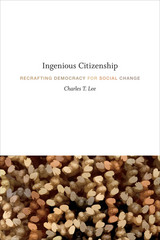 Ingenious Citizenship: Recrafting Democracy for Social Change
Charles T. Lee
Duke University Press, 2016 In Ingenious Citizenship Charles T. Lee centers the daily experiences and actions of migrant domestic workers, sex workers, transgender people, and suicide bombers in his rethinking of mainstream models of social change. Bridging cultural and political theory with analyses of film, literature, and ethnographic sources, Lee shows how these abject populations find ingenious and improvisational ways to disrupt and appropriate practices of liberal citizenship. When voting and other forms of civic engagement are unavailable or ineffective, the subversive acts of a domestic worker breaking a dish or a prostitute using the strategies and language of an entrepreneur challenge the accepted norms of political action. Taken to the extreme, a young Palestinian woman blowing herself up in a Jerusalem supermarket questions two of liberal citizenship's most cherished values: life and liberty. Using these examples to critically reinterpret political agency, citizenship practices, and social transformation, Lee reveals the limits of organizing change around a human rights discourse. Moreover, his subjects offer crucial lessons in how to turn even the worst conditions and the most unstable positions in society into footholds for transformative and democratic agency.
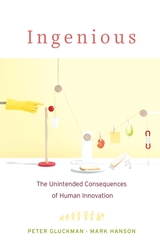 Ingenious: The Unintended Consequences of Human Innovation
Peter Gluckman and Mark Hanson
Harvard University Press, 2019 As humans evolved, we developed technologies to modify our environment, yet these innovations are increasingly affecting our behavior, biology, and society. Now we must figure out how to function in the world we’ve created.
Over thousands of years, humans have invented ingenious ways to gain mastery over our environment. The ability to communicate, accumulate knowledge collectively, and build on previous innovations has enabled us to change nature. Innovation has allowed us to thrive.
The trouble with innovation is that we can seldom go back and undo it. We invent, embrace, and exploit new technologies to modify our environment. Then we modify those technologies to cope with the resulting impacts. Gluckman and Hanson explore what happens when we innovate in a way that leads nature to bite back. To provide nourishment for a growing population, humans developed methods to process and preserve food; but easy access to these energy-dense foods results in obesity. To protect ourselves from dangerous pathogens we embraced cleanliness and invented antibiotics, which has led to rising rates of autoimmune diseases and antibiotic-resistant bacteria. More recently, our growing dependence on the internet and social media has been linked to mental health concerns and declining social cohesion. And we are only at the beginning of the digital transformation that will influence every part of our existence. Our ingenuity has not only changed our world—it has changed us.
Focusing on immediate benefits, we rarely pause to consider the longer-term costs of innovation. Yet we are now starting to see how our choices affect the way our brains develop and our bodies function. The implications are profound. Ingenious opens our eyes to the dangers we face and offers solutions we cannot ignore.
Ingenuity in the Making: Matter and Technique in Early Modern Europe
Richard J. Oosterhoff, José Ramón Marcaida, and Alexander Marr
University of Pittsburgh Press, 2021 Ingenuity in the Making explores the myriad ways in which ingenuity shaped the experience and conceptualization of materials and their manipulation in early modern Europe. Contributions range widely across the arts and sciences, examining objects and texts, professions and performances, concepts and practices. The book considers subjects such as spirited matter, the conceits of nature, and crafty devices, investigating the ways in which ingenuity acted in and upon the material world through skill and technique. Contributors ask how ingenuity informed the “maker’s knowledge” tradition, where the perilous borderline between the genius of invention and disingenuous fraud was drawn, charting the ambitions of material ingenuity in a rapidly globalizing world.
 Inglorious Artists: Art World Satire and the Emergence of a Capitalist Art Market in Paris, 1750-1850
Kathryn Desplanque
University of Delaware Press, 2025 Inglorious Artists traces the origins of the image of the starving artist to late eighteenth- and early nineteenth-century France, where practicing and aspiring visual artists mobilized the emerging genre of graphic satire to publish hundreds of satirical images that satirized the Paris art world. By examining many of these images, which have never before been studied or published, this book provides a new social history of the status of the artist, revealing the ways in which the starving artist trope was used to protest the emergence of an early capitalist art market and to distinguish artists and their work from an increasingly commercial world. During this period, a series of political revolutions brought the possibility of radical change in the French art world. Parisian artists struggled to keep pace with the emergence of modern financial speculative capitalism, transitioning away from an art system dominated by guild and corporate interest. We have neglected the complaints visual artists made about these changes, expressed in the medium most accessible to them: the graphic image. In examining this imagery for the first time, Inglorious Artists reveals that the emergence of our modern conception of the artist is far more conflicted than has been considered.
This book is also freely available online as an open access digital edition.
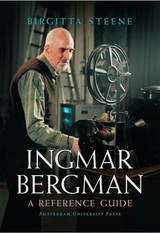 Ingmar Bergman: A Reference Guide
Birgitta Steene
Amsterdam University Press, 2006 The films of Swedish director Ingmar Bergman are renowned for their largely spare and stark aesthetic, an existential framework, and plots driven by a fascination with death and the moral torments of the human soul. Birgitta Steene offers here in Ingmar Bergman: A Reference Guide an essential and unparalleled resource on the life and work of Bergman. Plumbing the depths of these trademark Bergman themes, Steene traces as well the indelible mark he left on world cinema through his other cinematographic work and writings.
Over the decades, Bergman's stature and image have evolved in fascinating ways—an iconoclast of the 1950s, a bourgeois traditionalist of the 1960s, and an icon in the 1980s. This exhaustive compendium considers each phase of his career, exploring his deep and vast oeuvre in all its controversy and complexity, and analyzes his intriguing and unique motifs such as his efforts to expose dead conventions and his portrayals of Woman as the archetype of humanity. As well as providing a detailed account of Bergman's life and chronicling his career as a filmmaker and theater director, including his work for television, Steene offers transcripts of some of the numerous interviews and conversations she conducted with Bergman. Writings by and about Bergman and a detailed chronological survey of his film and theatrical work completes this eminently readable and thoroughly researched volume. A wide-ranging and groundbreaking work of film history, Ingmar Bergman is the definitive reference for scholars of the Scandinavian master.
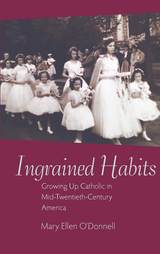 Ingrained Habits: Growing Up Catholic in Mid-Twentieth-Century America
Mary Ellen O'Donnell
Catholic University of America Press, 2018 Born Catholic. Raised Catholic. Americans across generations have used these phrases to describe their formative days, but the experience of growing up Catholic in the United States has changed over the last several decades. While the creed and the sacraments remain the same, the context for learning the faith has transformed. As a result of demographic shifts and theological developments, children face a different set of circumstances today from what they encountered during the mid-twentieth-century. Through a close study of autobiographical and fictional texts that depict the experience, Ingrained Habits explores the intimate details of everyday life for children growing up Catholic during the 1940s, 50s, and 60s. These literary portrayals present upbringings characterized by an all-encompassing encounter with religion. The adult authors of such writings run the gamut from vowed priests to unwavering atheists and their depictions range from glowing nostalgia to deep-seated resentment; however, they curiously describe similar experiences from their childhood days in the Church.
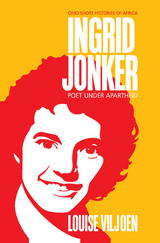 Ingrid Jonker: Poet under Apartheid
Louise Viljoen
Ohio University Press, 2012 Nelson Mandela brought the poetry of Ingrid Jonker to the attention of South Africa and the wider world when he read her poem “Die kind” (The Child) at the opening of South Africa’s first democratic parliament on May 24, 1994. Though Jonker was already a significant figure in South African literary circles, Mandela’s reference contributed to a revival of interest in Jonker and her work that continues to this day. Viljoen’s biography illuminates the brief and dramatic life of Jonker, who created a literary oeuvre—as searing in its intensity as it is brief—before taking her own life at the age of thirty-one. Jonker wrote against a background of escalating apartheid laws, violent repression of black political activists, and the banning of the African National Congress and the Pan Africanist Congress. Viljoen tells the story of Ingrid Jonker in the political and cultural context of her time, provides sensitive insights into her poetry, and considers the reasons for the enduring fascination with her life and death. Her writings, her association with bohemian literary circles, and her identification with the oppressed brought her into conflict with her father, a politician in the white ruling party, and with other authority figures from her Afrikaner background. Her life and work demonstrate the difficulty and importance of artistic endeavor in a place of terrible conflict.
 Inhabitants of the Deep: The Blueness of Blackness
Jonathan Howard
Duke University Press, 2025 In Inhabitants of the Deep, Jonathan Howard undertakes a black ecocritical study of the deep in African American literature. Howard contends that the deep—a geographic formation that includes oceans, rivers, lakes, and the notion of depth itself—provides the diffuse subtext of black literary and expressive culture. He draws on texts by authors ranging from Olaudah Equiano and Herman Melville to Otis Redding and August Wilson to present a vision of blackness as an ongoing inhabitation of the deep that originates with and persists beyond Middle Passage. From captive Africans’ first tentative encounter with the landless realm of the Atlantic to the ground on which black peoples still struggle to stand, the deep is what blackness has known throughout the changing same of black life and death. Yet this radical exclusion from the superficial Western world, Howard contends, is more fully apprehended not as the social death hailed by the slave ship but as the black ecological life hailed by a blue planet.
The Inhabited Woman
Gioconda Belli; Translated by Kathleen March
University of Wisconsin Press, 2004 Lavinia is The Inhabited Woman: accomplished, independent, and fiercely modern. She is sheltered and self-involved, until the spirit of an Indian woman warrior enters her being, then she dares to join a revolutionary movement against a violent dictator and—through the power of love—finds the courage to act.
The Wisconsin edition is for sale only in North America.
Inhabiting the Impossible: Dance and Experimentation in Puerto Rico
Susan Homar and nibia pastrana santiago, Editors
University of Michigan Press, 2023 This first-of-its-kind book brings together writing by artists and scholars to survey the lively field of Puerto Rican experimental dance across four decades. Originally published as Habitar lo Imposible, the translation in English features essays, artist statements, and interviews plus more than 100 photos of productions, programs, posters, and scores. Throughout, Inhabiting the Impossible provides fresh, invaluable perspectives on experimentation in dance as a sustained practice that has from the start deeply engaged issues of race, gender, sexuality, and politics. The book is also enhanced by a bibliographic section with detailed resources for further study.
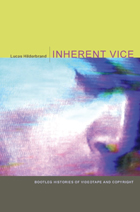 Inherent Vice: Bootleg Histories of Videotape and Copyright
Lucas Hilderbrand
Duke University Press, 2009 In an age of digital technology and renewed anxiety about media piracy, Inherent Vice revisits the recent analog past with an eye-opening exploration of the aesthetic and legal innovations of home video. Analog videotape was introduced to consumers as a blank format, essentially as a bootleg technology, for recording television without permission. The studios initially resisted VCRs and began legal action to oppose their marketing. In turn, U.S. courts controversially reinterpreted copyright law to protect users’ right to record, while content owners eventually developed ways to exploit the video market. Lucas Hilderbrand shows how videotape and fair use offer essential lessons relevant to contemporary progressive media policy. Videotape not only radically changed how audiences accessed the content they wanted and loved but also altered how they watched it. Hilderbrand develops an aesthetic theory of analog video, an “aesthetics of access” most boldly embodied by bootleg videos. He contends that the medium specificity of videotape becomes most apparent through repeated duplication, wear, and technical failure; video’s visible and audible degeneration signals its uses for legal transgressions and illicit pleasures. Bringing formal and cultural analysis into dialogue with industrial history and case law, Hilderbrand examines four decades of often overlooked histories of video recording, including the first network news archive, the underground circulation of Superstar: The Karen Carpenter Story, a feminist tape-sharing network, and the phenomenally popular website YouTube. This book reveals the creative uses of videotape that have made essential content more accessible and expanded our understanding of copyright law. It is a politically provocative, unabashedly nostalgic ode to analog.
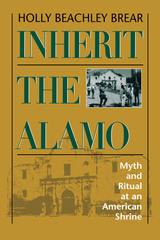 Inherit the Alamo: Myth and Ritual at an American Shrine
By Holly Beachley Brear
University of Texas Press, 1994 Long overshadowed by the towering buildings of downtown San Antonio, the modest little Alamo still evokes tremendous feeling among Texans and, indeed, many other Americans. For Anglo Texans, the Alamo is the "Cradle of Texas Liberty" and a symbolic confirmation of Manifest Destiny. For Hispanic Texans, however, the Alamo has increasingly become a stolen symbol, its origin as a Spanish mission forgotten, its famous defeat used to exclude Hispanics from an honorable place in Texas history. In this important new book, Holly Beachley Brear explores in fascinating detail what the Alamo means to the numerous groups that lay claim to its heritage. She shows how Alamo myths often diverge from the historical facts—and why. She decodes the agendas of various groups, including the Daughters of the Republic of Texas (who maintain the Alamo buildings and grounds), the Order of the Alamo, the Texas Cavaliers, and LULAC. And she probes attempts by individuals and groups to rewrite the Alamo myth to include more positive roles for themselves, as she explains the value in laying claim to the Alamo's past. With new perspectives on all the sacred icons of the Alamo and the Fiesta that celebrates (one version of) its history each year, Inherit the Alamo is guaranteed to challenge stereotypes and offer new understanding of the Alamo's ongoing role in shaping Texas and American history and mythology. It will be of interest to a wide popular and scholarly audience.
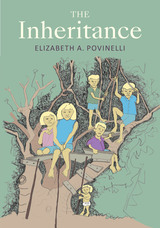 The Inheritance
Elizabeth A. Povinelli
Duke University Press, 2021 Elizabeth A. Povinelli’s inheritance was passed down not through blood or soil but through a framed map of Trentino, Alto Adige—the region where family's ancestral alpine village is found. Far more than a map hanging above the family television, the image featured colors and lines that held in place the memories and values fueling the Povinelli family's fraught relationships with the village and with each other. In her graphic memoir The Inheritance, Povinelli explores the events, traumas, and powers that divide and define our individual and collective pasts and futures. Weaving together stories of her grandparents' flight from their village in the early twentieth century to the fortunes of their knife-grinding business in Buffalo, New York, and her own Catholic childhood in a shrinking Louisiana woodlands of the 1960s and 1970s, Povinelli describes the serial patterns of violence, dislocation, racism and structural inequality that have shaped not only her life but the American story. Plumbing the messy relationships among nationality, ethnicity, kinship, religion, and belonging, The Inheritance takes us into the gulf between the facts of history and the stories we tell ourselves to survive and justify them.
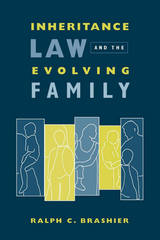 Inheritance Law And The Evolving Family
Ralph C. Brashier
Temple University Press, 2004 Nontraditional families are today an important part of American family life. Yet when a loved one dies, our inheritance laws are often stingy even towards survivors in the nuclear family. With humor, enthusiasm, and a bit of righteous outrage, Ralph C. Brashier explores how probate laws ignore gender roles and marital contributions of the spouse, often to the detriment of the surviving widow; how probate laws pretend that unmarried couples—particularly gay and lesbian ones—do not exist; how probate laws allow a parent to disinherit even the neediest child; and how probate laws for nonmarital children, adopted children, and children born of surrogacy or other forms of assisted reproductive technology are in flux or simply don't exist. A thoughtful examination of the current state of probate law and the inability of legislators to recognize and provide for the broad range of families in America today, this book will be read by those with an interest in the relationship between families and the law across a wide range of academic disciplines.
Inheritance: Love, Loss, and the Legacy of the Holocaust
Charlie Scheidt
Rutgers University Press, 2026 After his mother’s death, Charlie Scheidt discovered a trove of historic documents that set him on a decade-long journey to uncover his family’s hidden past during the Holocaust. Joined by Kat Rohrer, the granddaughter of a Nazi officer, Scheidt embarked on a quest to trace his family’s harrowing efforts to escape from Nazi-occupied Europe. As they investigated, they uncovered stories of survival and loss. Their journey takes them across generations and continents, revealing a legacy of love, loss, and resilience. Grappling with questions about the long-lasting effects of inherited trauma, the book asks whether it is possible to break free of a familial cycle. This memoir, rooted in his family’s escape and the lasting trauma that followed, is a powerful reflection on history’s enduring scars, the importance of remembrance, and healing across generations.
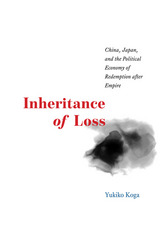 Inheritance of Loss: China, Japan, and the Political Economy of Redemption after Empire
Yukiko Koga
University of Chicago Press, 2016 How do contemporary generations come to terms with losses inflicted by imperialism, colonialism, and war that took place decades ago? How do descendants of perpetrators and victims establish new relations in today’s globalized economy? With Inheritance of Loss, Yukiko Koga approaches these questions through the unique lens of inheritance, focusing on Northeast China, the former site of the Japanese puppet state Manchukuo, where municipal governments now court Japanese as investors and tourists. As China transitions to a market-oriented society, this region is restoring long-neglected colonial-era structures to boost tourism and inviting former colonial industries to create special economic zones, all while inadvertently unearthing chemical weapons abandoned by the Imperial Japanese Army at the end of World War II.
Inheritance of Loss chronicles these sites of colonial inheritance––tourist destinations, corporate zones, and mustard gas exposure sites––to illustrate attempts by ordinary Chinese and Japanese to reckon with their shared yet contested pasts. In her explorations of everyday life, Koga directs us to see how the violence and injustice that occurred after the demise of the Japanese Empire compound the losses that later generations must account for, and inevitably inherit.
 Inheritance of Night: Early Drafts of Lie Down in Darkness
William Styron
Duke University Press, 1993 From 1947 to 1949, William Styron twice attempted to write a novel under the working title Inheritance of Night. On the third attempt he produced the award-winning Lie Down in Darkness, which when published in September 1951 established him as one of the most promising writers of his generation. Duke University Press is proud to publish, in facsimile form, the long-lost drafts of Styron's earliest versions of Lie Down in Darkness.
Although Styron began the narrative twice, he realized both times that his writing was derivative and his characters not yet fully conceived. These drafts show young Stryon feeling his way into the story with various narrative voices and strategies, and attempting to work out his plot. Influence from William Faulkner, F. Scott Fitzgerald, and Robert Penn Warren is apparent in the text, and there is a character present named Marcus Bonner who is an early rendition of Stingo in Sophie's Choice.
The typescript drafts of Inheritance of Night for many years were thought to have been lost, but in 1980 were discovered in the files of one of Styron's former literary agents. These drafts, eventually made their way to the archive of Styron's papers assembled at Duke University Library. This facsimile is published here in two different limited editions for collectors: a lettered, signed, and boxed edition (26 copies) and a numbered, signed edition (250). A general interest trade volume is also available.
With a preface by Styron and an introduction by James L. W. West III, these drafts afford much insight into the creation of Lie Down in Darkness and the writing of a major twentieth-century American writer.
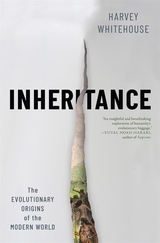 Inheritance: The Evolutionary Origins of the Modern World
Harvey Whitehouse
Harvard University Press, 2024 “An insightful and breathtaking exploration of humanity’s evolutionary baggage that explains some of our species’ greatest successes and failures.” —Yuval Noah Harari, author of Sapiens
The ancient inheritance that made us who we are—and is now driving us to ruin.
Each of us is endowed with an inheritance—a set of evolved biases and cultural tools that shape every facet of our behavior. For countless generations, this inheritance has taken us to ever greater heights: driving the rise of more sophisticated technologies, more organized religions, more expansive empires. But now, for the first time, it’s failing us. We find ourselves hurtling toward a future of unprecedented political polarization, deadlier war, and irreparable environmental destruction.
In Inheritance, renowned anthropologist Harvey Whitehouse offers a sweeping account of how our biases have shaped humanity’s past and imperil its future. He argues that three biases—conformism, religiosity, and tribalism—drive human behavior everywhere. Forged by natural selection and harnessed by thousands of years of cultural evolution, these biases catalyzed the greatest transformations in human history, from the birth of agriculture and the arrival of the first kings to the rise and fall of human sacrifice and the creation of multiethnic empires. Taking us deep into modern-day tribes, including terrorist cells and predatory ad agencies, Whitehouse shows how, as we lose the cultural scaffolding that allowed us to manage our biases, the world we’ve built is spiraling out of control.
By uncovering how human nature has shaped our collective history, Inheritance unveils a surprising new path to solving our most urgent modern problems. The result is a powerful reappraisal of the human journey, one that transforms our understanding of who we are, and who we could be.
 Inheritance: The Evolutionary Origins of the Modern World
Harvey Whitehouse
Harvard University Press An “exhilarating” (Irish Times) and “ambitious” (The Guardian) account of the ancient inheritance that made us who we are—and is now driving us to ruin.
Why do humans everywhere believe in ghosts?
How might our tendency to imitate one another be contributing to the climate catastrophe?
And does our deep evolutionary past impel us to vote for strongmen?
In 1987 Harvey Whitehouse went to live with an indigenous community deep in the Papua New Guinea rainforest. His experiences there convinced him that, far from being wildly different, humans are fundamentally alike: their beliefs and behaviors are rooted in a set of evolutionary biases that can be found in any society, anywhere.
In Inheritance, Whitehouse leads us across twelve millennia and five continents to uncover how these biases—conformism, religiosity, and tribalism—have both shaped and been reshaped by human history. Along the way, he shows that this ancient inheritance holds the key not just to explaining the modern world, but perhaps also to repairing it.
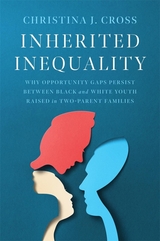 Inherited Inequality: Why Opportunity Gaps Persist between Black and White Youth Raised in Two-Parent Families
Christina J. Cross
Harvard University Press, 2025 A groundbreaking study challenges basic tenets of US social welfare policy with proof that raising Black children in two-parent families does not close racial gaps in life outcomes.
Ever since Daniel Patrick Moynihan’s controversial 1965 report on “The Negro Family,” the disadvantages of the single-parent household have been at the center of debates about racial inequality in the United States. In particular, absent fathers and single-parent homes are seen as fundamental to the “tangle of pathology” that supposedly underlies Black disadvantage. Redressing inequality thus requires interventions that promote marriage and shore up the two-parent family.
Inherited Inequality is a decisive refutation of this narrative and a definitive account of the harm it has caused. Marshaling extensive longitudinal data of African American and white children from birth through young adulthood, sociologist Christina Cross demonstrates that the two-parent family is no equalizer. While growing up with two parents increases average household income and allows for more parental involvement, the resulting gains are racially skewed: Black children brought up in a two-parent home still fare much worse than their white counterparts, in school and on the job market. Thus, interventions aimed at correcting the supposed deficiencies of the Black family will not fix these inequities. To the contrary, Cross insists, focusing on family structure distracts us from the racist legacies and logics that persistently leave African Americans with fewer resources and opportunities, regardless of who raises them.
The first comprehensive empirical study of its kind, Inherited Inequality is a resounding repudiation of welfare policies that, to this day, favor marriage counseling over economic assistance. More than that, it is a provocative invitation to rethink the meaning of family in Black communities.
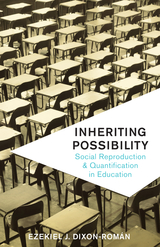 Inheriting Possibility: Social Reproduction and Quantification in Education
Ezekiel J. Dixon-Román
University of Minnesota Press, 2017 How has the dominant social scientific paradigm limited our understanding of the impact of inherited economic resources, social privilege, and sociocultural practices on multigenerational inequality? In what ways might multiple forces of social difference haunt quantitative measurements of ability such as the SAT? Building on new materialist philosophy, Inheriting Possibility rethinks methods of quantification and theories of social reproduction in education, demonstrating that test performance results and parenting practices convey the impact of materially and historically contingent patterns of differential possibility. Ezekiel J. Dixon-Román explores the dualism of nature and culture that has undergirded theories of inheritance, social reproduction, and human learning and development. Research and debate on the reproduction of power relations have rested on a premise that nature is made up of fixed universals on which the creative, intellective, and discursive play of culture are based. Drawing on recent work in the physical and biological sciences, Dixon-Román argues that nature is culture. He contends that by assuming a rigid nature/culture binary, we ultimately limit our understanding of how power relations are reproduced. Through innovative analyses of empirical data and cultural artifacts, Dixon-Román boldly reconsiders how we conceptualize the processes of inheritance and approach social inquiry in order to profoundly sharpen understanding and address the reproducing forces of inequality.
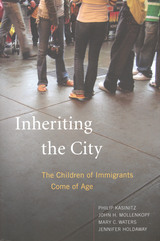 Inheriting the City: The Children of Immigrants Come of Age
Philip Kasinitz
Russell Sage Foundation, 2008 The United States is an immigrant nation—nowhere is the truth of this statement more evident than in its major cities. Immigrants and their children comprise nearly three-fifths of New York City's population and even more of Miami and Los Angeles. But the United States is also a nation with entrenched racial divisions that are being complicated by the arrival of newcomers. While immigrant parents may often fear that their children will "disappear" into American mainstream society, leaving behind their ethnic ties, many experts fear that they won't—evolving instead into a permanent unassimilated and underemployed underclass. Inheriting the City confronts these fears with evidence, reporting the results of a major study examining the social, cultural, political, and economic lives of today's second generation in metropolitan New York, and showing how they fare relative to their first-generation parents and native-stock counterparts. Focused on New York but providing lessons for metropolitan areas across the country, Inheriting the City is a comprehensive analysis of how mass immigration is transforming life in America's largest metropolitan area. The authors studied the young adult offspring of West Indian, Chinese, Dominican, South American, and Russian Jewish immigrants and compared them to blacks, whites, and Puerto Ricans with native-born parents. They find that today's second generation is generally faring better than their parents, with Chinese and Russian Jewish young adults achieving the greatest education and economic advancement, beyond their first-generation parents and even beyond their native-white peers. Every second-generation group is doing at least marginally—and, in many cases, significantly—better than natives of the same racial group across several domains of life. Economically, each second-generation group earns as much or more than its native-born comparison group, especially African Americans and Puerto Ricans, who experience the most persistent disadvantage. Inheriting the City shows the children of immigrants can often take advantage of policies and programs that were designed for native-born minorities in the wake of the civil rights era. Indeed, the ability to choose elements from both immigrant and native-born cultures has produced, the authors argue, a second-generation advantage that catalyzes both upward mobility and an evolution of mainstream American culture. Inheriting the City leads the chorus of recent research indicating that we need not fear an immigrant underclass. Although racial discrimination and economic exclusion persist to varying degrees across all the groups studied, this absorbing book shows that the new generation is also beginning to ease the intransigence of U.S. racial categories. Adapting elements from their parents' cultures as well as from their native-born peers, the children of immigrants are not only transforming the American city but also what it means to be American.
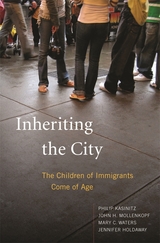 Inheriting the City: The Children of Immigrants Come of Age
Philip Kasinitz, John H. Mollenkopf, Mary C. Waters, and Jennifer Holdaway
Harvard University Press, 2008 Behind the contentious politics of immigration lies the question of how well new immigrants are becoming part of American society. To address this question, Inheriting the City draws on the results of a ground-breaking study of young adults of immigrant parents in metropolitan New York to provide a comprehensive look at their social, economic, cultural, and political lives.
Inheriting the City examines five immigrant groups to disentangle the complicated question of how they are faring relative to native-born groups, and how achievement differs between and within these groups. While some experts worry that these young adults would not do as well as previous waves of immigrants due to lack of high-paying manufacturing jobs, poor public schools, and an entrenched racial divide, Inheriting the City finds that the second generation is rapidly moving into the mainstream—speaking English, working in jobs that resemble those held by native New Yorkers their age, and creatively combining their ethnic cultures and norms with American ones. Far from descending into an urban underclass, the children of immigrants are using immigrant advantages to avoid some of the obstacles that native minority groups cannot.
Inheriting the Holocaust: A Second-Generation Memoir
Paula S. Fass
Rutgers University Press, 2011 In Inheriting the Holocaust, Paula S. Fass explores her own past as the daughter of Holocaust survivors to reflect on the nature of history and memory. Through her parents' experiences and the stories they recounted, Fass defined her engagement as a historian and used these skills to better understand her parents' lives. Fass begins her journey through time and relationships when she travels to Poland and locates birth certificates of the murdered siblings she never knew. That journey to recover her family's story provides her with ever more evidence for the perplexing reliability of memory and its winding path toward historical reconstruction. In the end, Fass recovers parts of her family's history only to discover that Poland is rapidly re-imagining the role Jews played in the nation's past.
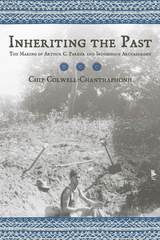 Inheriting the Past: The Making of Arthur C. Parker and Indigenous Archaeology
Chip Colwell-Chanthaphonh
University of Arizona Press, 2009 In recent years, archaeologists and Native American communities have struggled to find common ground even though more than a century ago a man of Seneca descent raised on New York’s Cattaraugus Reservation, Arthur C. Parker, joined the ranks of professional archaeology. Until now, Parker’s life and legacy as the first Native American archaeologist have been neither closely studied nor widely recognized. At a time when heated debates about the control of Native American heritage have come to dominate archaeology, Parker’s experiences form a singular lens to view the field’s tangled history and current predicaments with Indigenous peoples.
In Inheriting the Past, Chip Colwell-Chanthaphonh examines Parker’s winding career path and asks why it has taken generations for Native peoples to follow in his footsteps. Closely tracing Parker’s life through extensive archival research, Colwell-Chanthaphonh explores how Parker crafted a professional identity and negotiated dilemmas arising from questions of privilege, ownership, authorship, and public participation. How Parker, as well as the discipline more broadly, chose to address the conflict between Native American rights and the pursuit of scientific discovery ultimately helped form archaeology’s moral community.
Parker’s rise in archaeology just as the field was taking shape demonstrates that Native Americans could have found a place in the scholarly pursuit of the past years ago and altered its trajectory. Instead, it has taken more than a century to articulate the promise of an Indigenous archaeology—an archaeological practice carried out by, for, and with Native peoples. As the current generation of researchers explores new possibilities of inclusiveness, Parker’s struggles and successes serve as a singular reference point to reflect on archaeology’s history and its future.
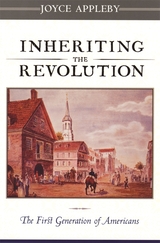 Inheriting the Revolution: The First Generation of Americans
Joyce Appleby
Harvard University Press, 2000 Born after the Revolution, the first generation of Americans inherited a truly new world--and, with it, the task of working out the terms of Independence. Anyone who started a business, marketed a new invention, ran for office, formed an association, or wrote for publication was helping to fashion the world's first liberal society. These are the people we encounter in Inheriting the Revolution, a vibrant tapestry of the lives, callings, decisions, desires, and reflections of those Americans who turned the new abstractions of democracy, the nation, and free enterprise into contested realities.
Through data gathered on thousands of people, as well as hundreds of memoirs and autobiographies, Joyce Appleby tells myriad intersecting stories of how Americans born between 1776 and 1830 reinvented themselves and their society in politics, economics, reform, religion, and culture. They also had to grapple with the new distinction of free and slave labor, with all its divisive social entailments; the rout of Enlightenment rationality by the warm passions of religious awakening; the explosion of small business opportunities for young people eager to break out of their parents' colonial cocoon. Few in the nation escaped the transforming intrusiveness of these changes. Working these experiences into a vivid picture of American cultural renovation, Appleby crafts an extraordinary--and deeply affecting--account of how the first generation established its own culture, its own nation, its own identity.
The passage of social responsibility from one generation to another is always a fascinating interplay of the inherited and the novel; this book shows how, in the early nineteenth century, the very idea of generations resonated with new meaning in the United States.
 The Inheritor: A Play
Kate Bredeson and Thalia Wolff
Northwestern University Press, 2025 The first English-language translation of the 1968 activist play about inequality and access to education
In The Inheritor, surrealist imagery and experimental forms convey the radically different experience of two students, the Inheritor and the Non-Inheritor, as they prepare for a high-stakes exam. Revealing a world of privilege where “there is no such thing as luck,” the play features a beheaded knight, a talking record player, and a boisterous chorus of professors depicted as a flock of squawking birds.
Based on sociologists Pierre Bourdieu and Jean-Claude Passeron’s The Inheritors: French Students and Their Relations to Culture, the play was collectively created by Théâtre de l’Aquarium, a company then composed entirely of students. It proved a powerful success when it premiered in May 1968 amid student and worker protests in Paris, and it continues to speak forcefully to education inequity on campuses across anglophone countries today.
 In-House Weddings
Bohumil Hrabal
Northwestern University Press, 2007 Inspired by “Mrs. Tolstoy and Mrs. Dostoevsky, whose biographies about their husbands have now been published in Prague,” Bohumil Hrabal decided to produce his own autobiographical work, ostensibly fiction, from his wife’s point of view. He would write, he said, “not a putdown about myself, but a little bit of how it all was, that marriage of ours, with myself as a jewel and adornment of our life together.”
The task, taken up by such a rogue comic talent, could be nothing other than strangely delightful; and in In-House Weddings, the first of the trilogy that Hrabal produced, we meet the author through the eyes of his wife Eliska. She narrates his life from his upbringing in Nymburk through his work as a dispatcher in a train station and then in a scrap paper plant, his first publication, his trouble with the authorities, and his association with notable artists and authors such as Jiri Kolar, Vladimir Boudnik, and Arnost Lustig. Hrabal’s bohemian life was itself a source of great interest to the Czech public; transmuted here, it is even more compelling, a wry portrait of artistic life in postwar Eastern Europe and a telling reflection on how such a life might be recast in the light of literary brilliance.
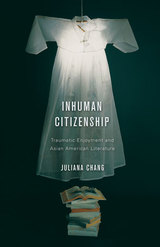 Inhuman Citizenship: Traumatic Enjoyment and Asian American Literature
Juliana Chang
University of Minnesota Press, 2012 In Inhuman Citizenship, Juliana Chang claims that literary representations of Asian American domesticity may be understood as symptoms of America’s relationship to its national fantasies and to the “jouissance”—a Lacanian term signifying a violent yet euphoric shattering of the self—that both overhangs and underlies those fantasies. In the national imaginary, according to Chang, racial subjects are often perceived as the source of jouissance, which they supposedly embody through their excesses of violence, sexuality, anger, and ecstasy—excesses that threaten to overwhelm the social order. To examine her argument that racism ascribes too much, rather than a lack of, humanity, Chang analyzes domestic accounts by Asian American writers, including Fae Myenne Ng’s Bone, Brian Ascalon Roley’s American Son, Chang-rae Lee’s Native Speaker, and Suki Kim’s The Interpreter. Employing careful reading and Lacanian psychoanalysis, Chang finds sites of excess and shock: they are not just narratives of trauma; they produce trauma as well. They render Asian Americans as not only the objects but also the vehicles and agents of inhuman suffering. And, claims Chang, these novels disturb yet strangely exhilarate the reader through characters who are objects of racism and yet inhumanly enjoy their suffering and the suffering of others. Through a detailed investigation of “family business” in works of Asian American life, Chang shows that by identifying with the nation’s psychic disturbance, Asian American characters ethically assume responsibility for a national unconscious that is all too often disclaimed.
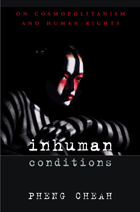 Inhuman Conditions: On Cosmopolitanism and Human Rights
Pheng Cheah
Harvard University Press, 2006 Globalization promises to bring people around the world together, to unite them as members of the human community. To such sanguine expectations, Pheng Cheah responds deftly with a sobering account of how the "inhuman" imperatives of capitalism and technology are transforming our understanding of humanity and its prerogatives. Through an examination of debates about cosmopolitanism and human rights, Inhuman Conditions questions key ideas about what it means to be human that underwrite our understanding of globalization. Cheah asks whether the contemporary international division of labor so irreparably compromises and mars global solidarities and our sense of human belonging that we must radically rethink cherished ideas about humankind as the bearer of dignity and freedom or culture as a power of transcendence. Cheah links influential arguments about the new cosmopolitanism drawn from the humanities, the social sciences, and cultural studies to a perceptive examination of the older cosmopolitanism of Kant and Marx, and juxtaposes them with proliferating formations of collective culture to reveal the flaws in claims about the imminent decline of the nation-state and the obsolescence of popular nationalism. Cheah also proposes a radical rethinking of the normative force of human rights in light of how Asian values challenge human rights universalism.
Inhuman Power: Artificial Intelligence and the Future of Capitalism
Nick Dyer-Witheford, Atle Mikkola Kjosen, and James Steinhoff
Pluto Press, 2019 The past several years have brought staggering advances in the field of Artificial Intelligence. And Marxist analysis has to keep up: while machines were always central to Marxist analysis, modern AI is a new kind of machine that Marx could not have anticipated.
Inhuman Power explores the relationship between Marxist theory and AI through three approaches, each using the lens of a different Marxist theoretical concept. While the idea of widespread AI tends to be celebrated as much as questioned, a deeper analysis of its reach and potential produces a more complex and disturbing picture than has been identified. Inhuman Power argues that on its current trajectory, AI is likely to render humanity obsolete and that the only way to prevent it is a communist revolution.
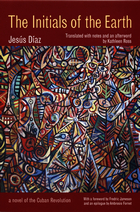 The Initials of the Earth
Jesús Díaz
Duke University Press, 2006 Many critics consider The Initials of the Earth to be the quintessential novel of the Cuban Revolution and the finest work by the Cuban writer and filmmaker Jesús Díaz. Born in Havana in 1941, Díaz was a witness to the Revolution and ardent supporter of it until the last decade of his life. In 1992 he took up residence as an exile in Berlin and later in Madrid, where he died in 2002. This is the first of his books to be translated into English. Originally written in the 1970s, then rewritten and published simultaneously in Havana and Madrid in 1987, The Initials of the Earth spans the tumultuous years from the 1950s until the 1970s, encompassing the Revolution and its immediate aftermath. The novel opens as the protagonist, Carlos Pérez Cifredo, sits down to fill out a questionnaire for readmission to the Cuban Communist Party. It closes with Carlos standing before a panel of Party members charged with assessing his merit as an “exemplary worker.” The chapters between relate Carlos’s experiences of the pre- and postrevolutionary era. His family is torn apart as some members reject the Revolution and flee the country while others, including Carlos, choose to stay. He witnesses key events including the Bay of Pigs invasion, the Cuban missile crisis, and the economically disastrous sugar harvest of 1970. Throughout the novel, Díaz vividly renders Cuban culture through humor, slogans, and slang; Afro-Cuban religion; and references to popular music, movies, and comics. This edition of The Initials of the Earth includes a bibliography and filmography of Diaz’s works and a timeline of the major events of the Cuban revolutionary period. In his epilogue, the Cuban writer Ambrosio Fornet reflects on Díaz’s surprising 1992 renunciation of the Revolution, their decades-long friendship, and the novel’s reception, structure, and place within Cuban literary history.
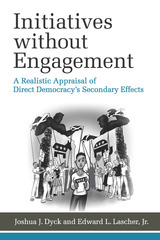 Initiatives without Engagement: A Realistic Appraisal of Direct Democracy’s Secondary Effects
Joshua J. Dyck and Edward L. Lascher, Jr.
University of Michigan Press, 2019 Arguments about the American ballot initiative process date back to the Progressive Era, when processes allowing citizens to decide policy questions directly were established in about half of the states.
When political scientists began to systematically examine whether the state ballot initiative process had spillover consequences, they found the initiative process had a positive impact on civic engagement. Recent scholarship casts doubt on these conclusions, determining the ballot initiative process did not make people believe they could influence the political process, trust the government, or be more knowledgeable about politics in general. However, in some circumstances, it got them to show up at the polls, and increased interest groups’ participation in the political arena. In Initiatives without Engagement, Dyck and Lascher develop and test a theory that can explain the evidence that the ballot initiative process fails to provide the civic benefits commonly claimed for it, and the evidence that it increases political participation. This theory argues that the basic function of direct democracy is to create more conflict in society.
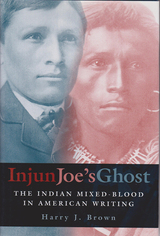 Injun Joe's Ghost: The Indian Mixed-Blood in American Writing
Harry J. Brown
University of Missouri Press, 2004
What does it mean to be a “mixed-blood,” and how has our understanding of this term changed over the last two centuries? What processes have shaped American thinking on racial blending? Why has the figure of the mixed-blood, thought too offensive for polite conversation in the nineteenth century, become a major representative of twentieth-century native consciousness?
In Injun Joe’s Ghost, Harry J. Brown addresses these questions within the interrelated contexts of anthropology, U.S. Indian policy, and popular fiction by white and mixed-blood writers, mapping the evolution of “hybridity” from a biological to a cultural category. Brown traces the processes that once mandated the mixed-blood’s exile as a grotesque or criminal outcast and that have recently brought about his ascendance as a cultural hero in contemporary Native American writing.
Because the myth of the demise of the Indian and the ascendance of the Anglo-Saxon is traditionally tied to America’s national idea, nationalist literature depicts Indian-white hybrids in images of degeneracy, atavism, madness, and even criminality. A competing tradition of popular writing, however, often created by mixed-blood writers themselves, contests these images of the outcast half-breed by envisioning “hybrid vigor,” both biologically and linguistically, as a model for a culturally heterogeneous nation.
Injun Joe’s Ghost focuses on a significant figure in American history and culture that has, until now, remained on the periphery of academic discourse. Brown offers an in-depth discussion of many texts, including dime novels and Depression-era magazine fiction, that have been almost entirely neglected by scholars. This volume also covers texts such as the historical romances of the 1820s and the novels of the twentieth-century “Native American Renaissance” from a fresh perspective. Investigating a broad range of genres and subject over two hundred year of American writing, Injun Joe’s Ghost will be useful to students and professionals in the fields of American literature, popular culture, and native studies.
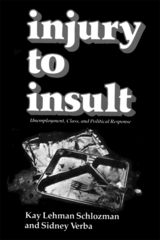 Injury to Insult: Unemployment, Class, and Political Response
Kay Lehman Schlozman and Sidney Verba
Harvard University Press, 1979 It is commonplace in contemporary American politics for those who experience economic strain to join together and ask the government for help. The unemployed, by and large, have not done so. In their study, Kay Lehman Schlozman and Sidney Verba look closely at the unemployed and ask why not.
Using the results of a large-scale survey supplemented by intensive interviews, the authors consider the political attitudes and behavior of the unemployed: how much hardship they feel, how they interpret their joblessness, what they do about it, how they view the American social order, and how they vote or otherwise take part in politics. The analysis is placed in the context of several larger concerns: the relationship between stress in private life and conduct in public life, the circumstances under which the disadvantaged are mobilized for politics, the changing role of social class in America, and the links between politics and macroeconomic conditions.
|
|

